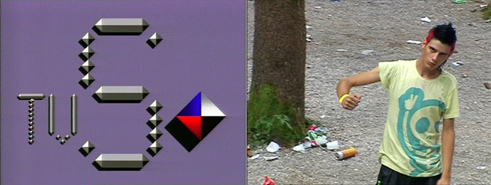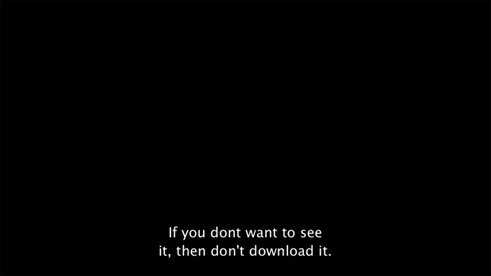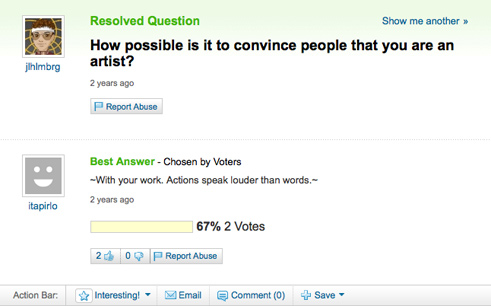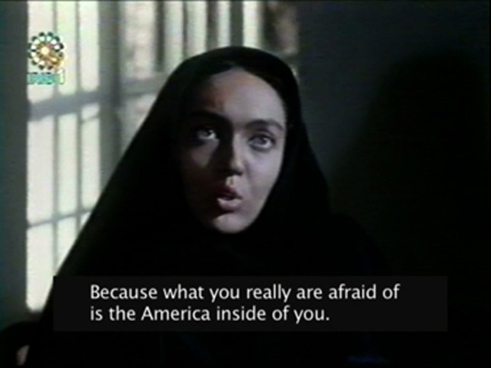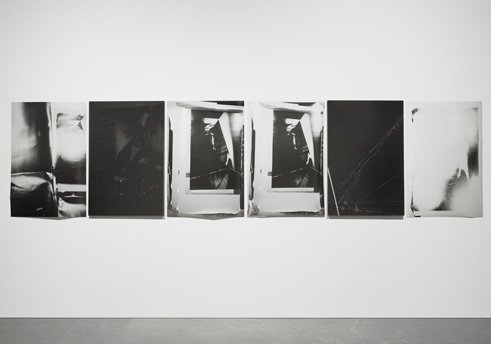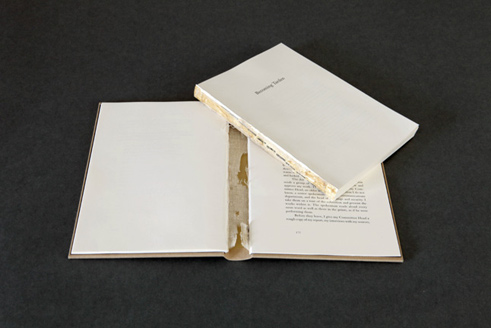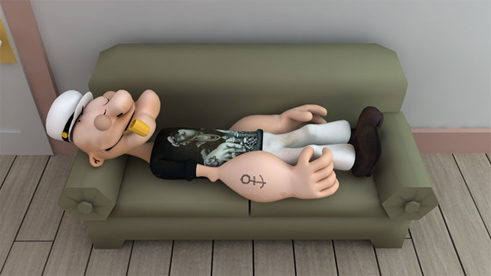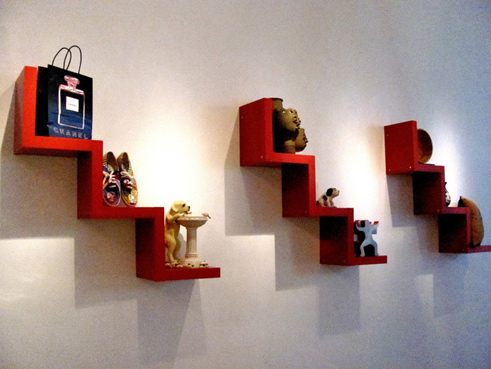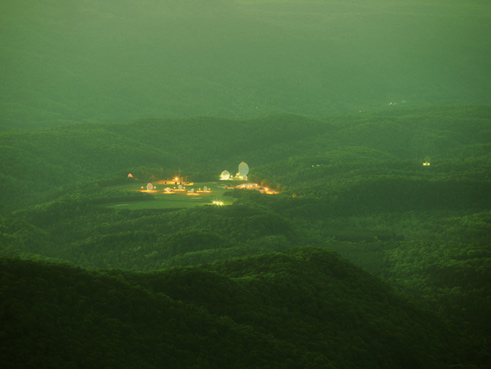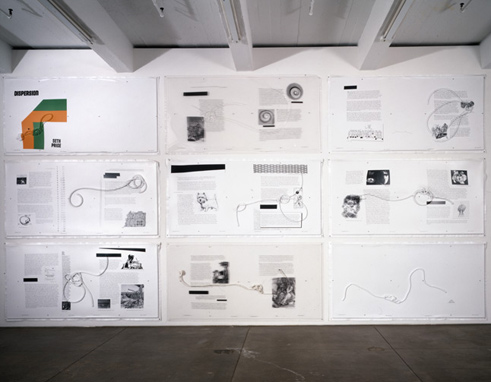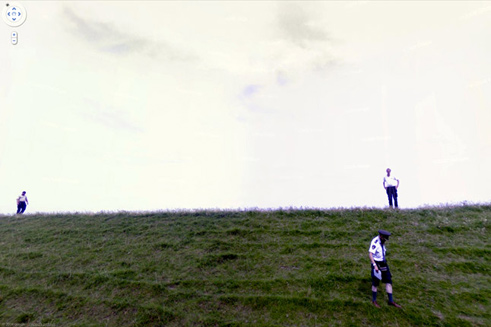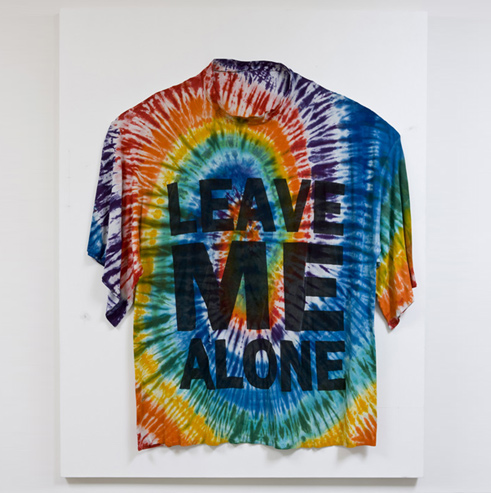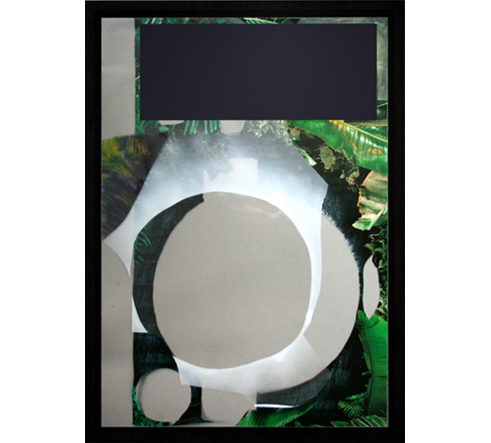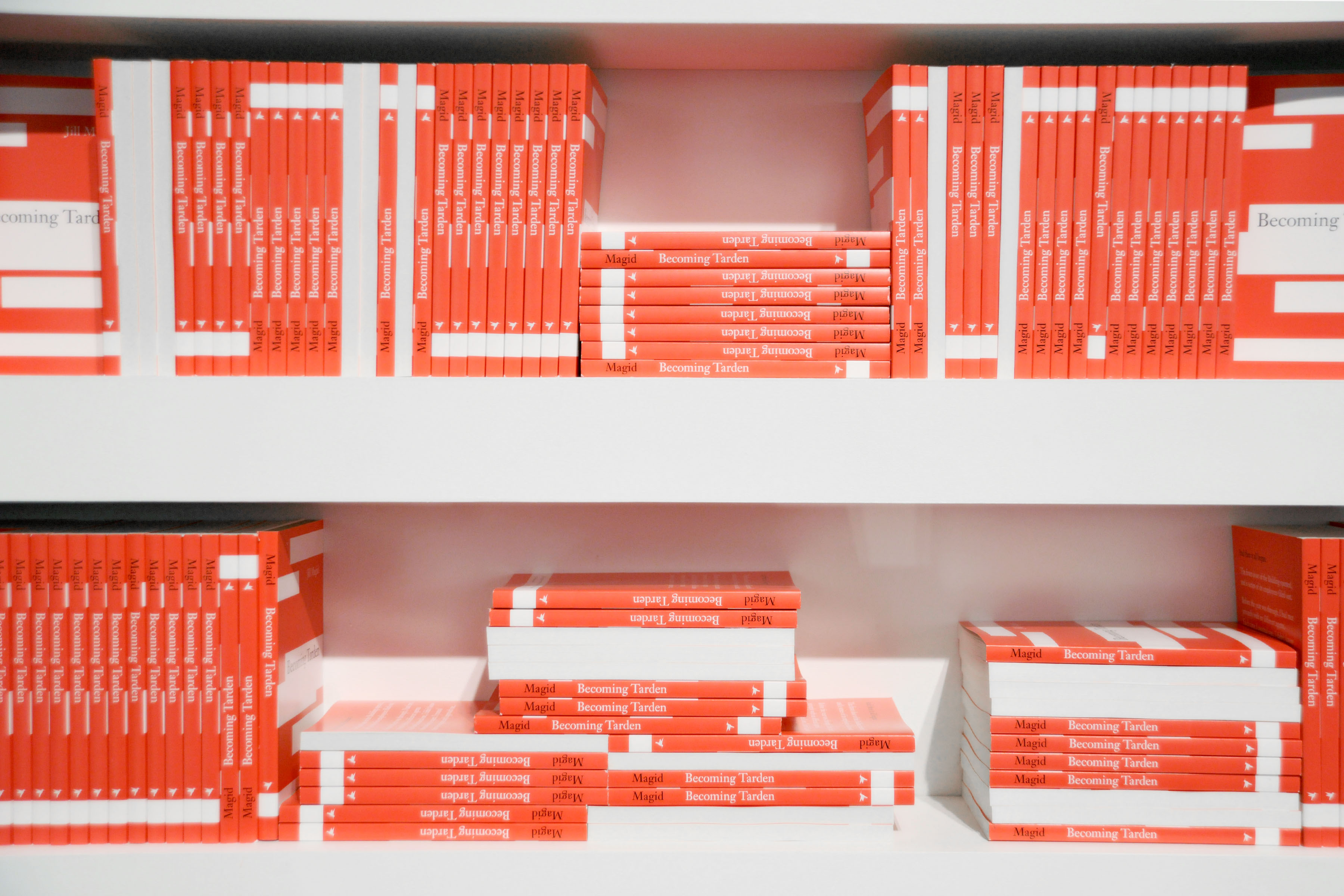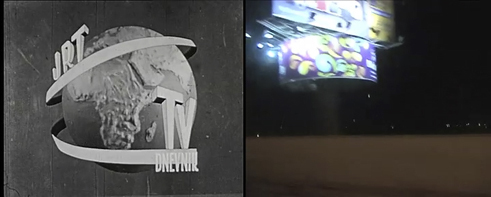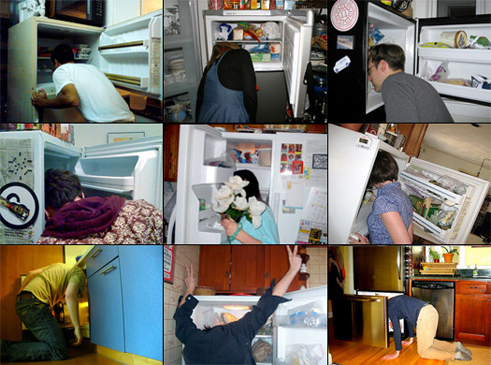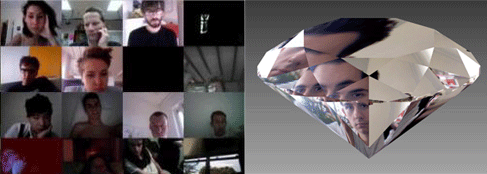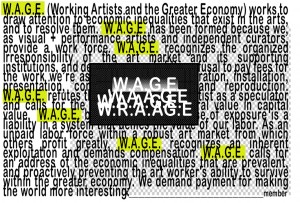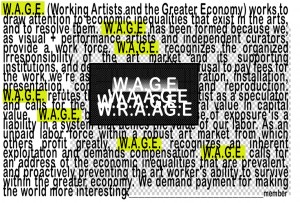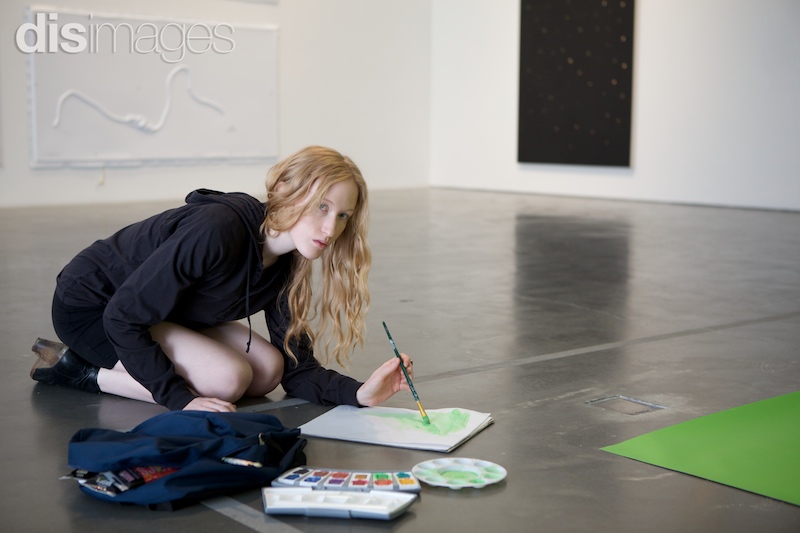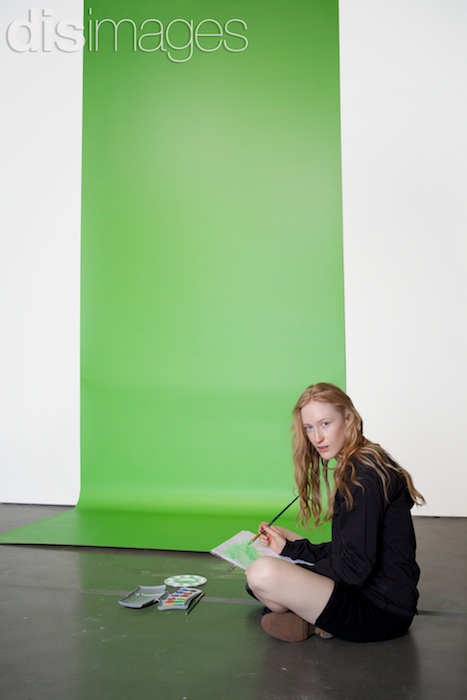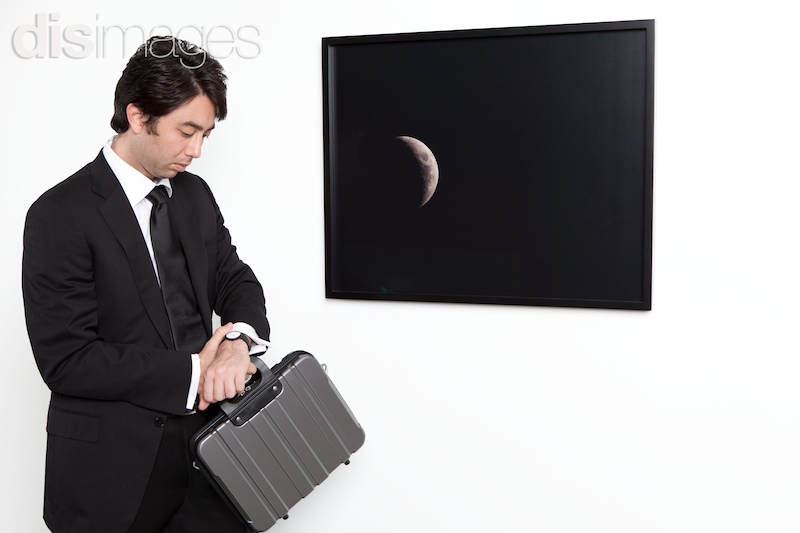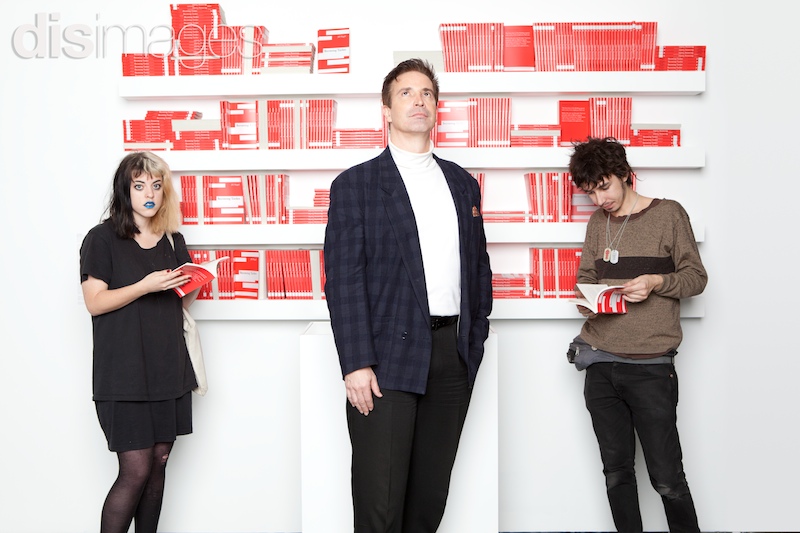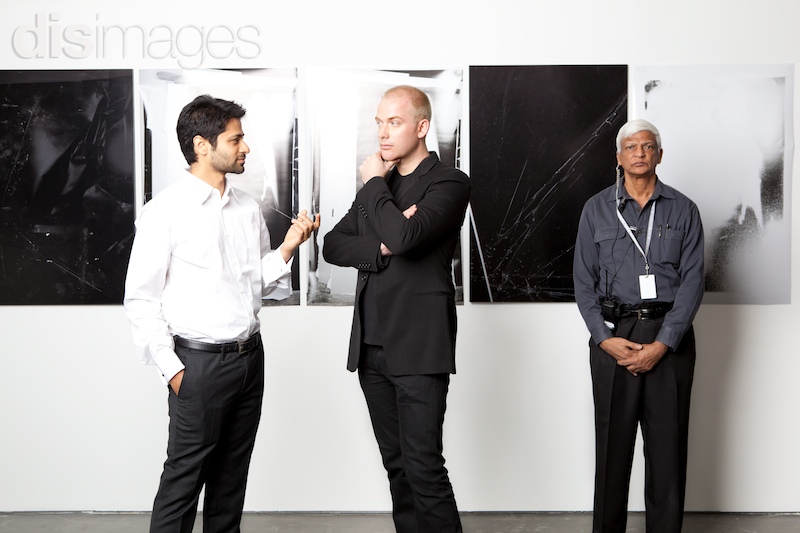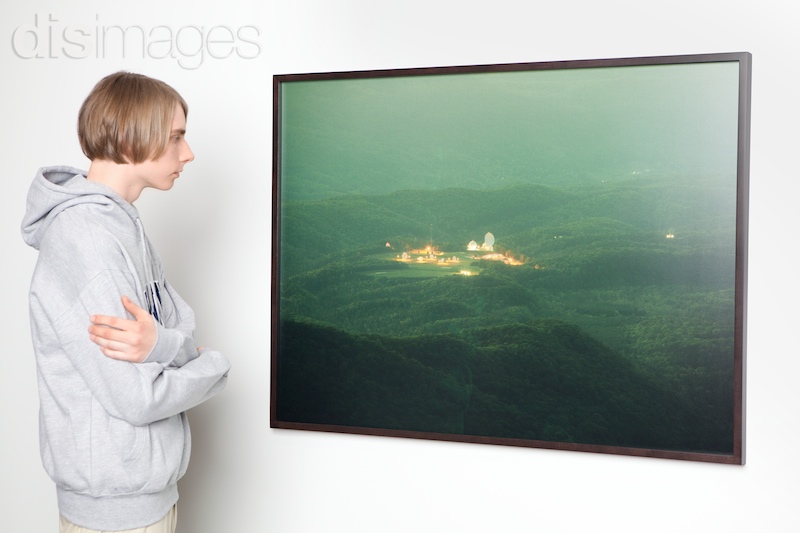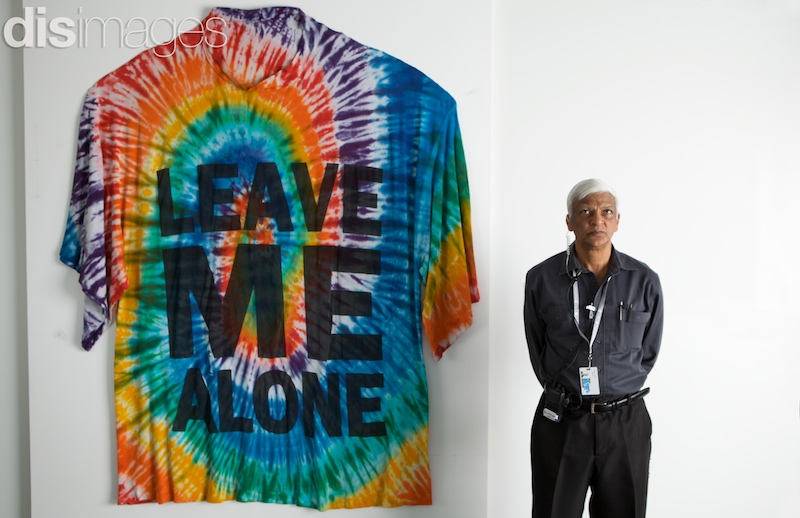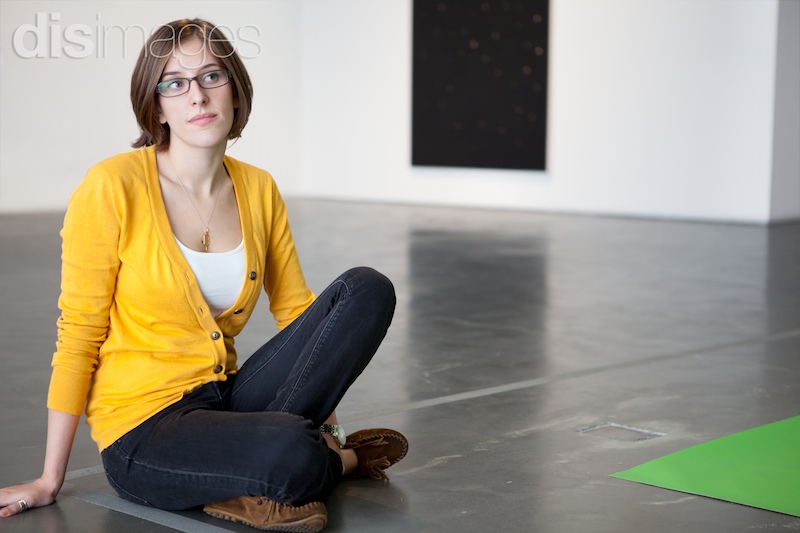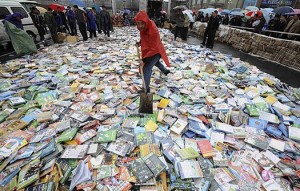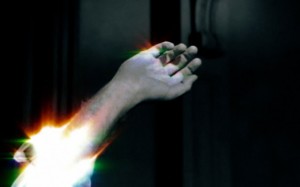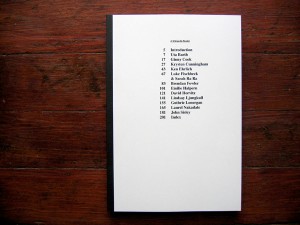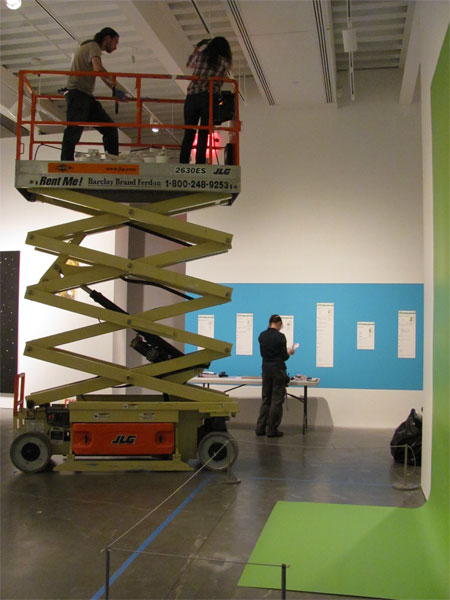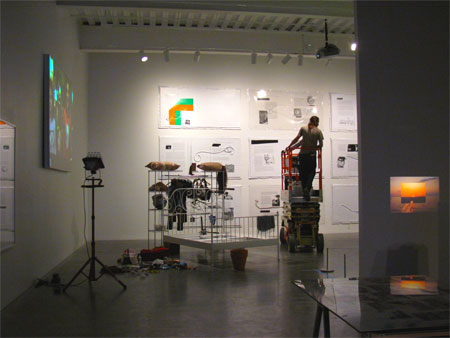Free
October 20, 2010 ~ January 23, 2011
“Free” explores how the internet has fundamentally changed our landscape of information and our notion of public space. Today, our shared space has expanded beyond streets and schools to more distributed forms of collectivity. What constitutes this expanded public is not only greater social connectedness but a highly visual, hybrid commons of information.
SPONSORS
“Free” is made possible by a generous grant from The Andy Warhol Foundation for the Visual Arts.
Major support provided by Shane Akeroyd
Significant support is also provided by the New York State Council on the Arts, a state agency, and the Toby Devan Lewis Emerging Artists Fund.
Additional funding is provided by the Mondriaan Foundation, Amsterdam, the Office for Contemporary Art Norway, and the Royal Norwegian Consulate General

Artists
Artist texts were written by Brian Droitcour, Jacob Gaboury, Ceci Moss and Lauren Cornell. Writers are noted on individual texts.
- Liz Deschenes,
- Aleksandra Domanovic,
- Lizzie Fitch,
- Martijn Hendriks,
- Joel Holmberg,
- David Horvitz,
- Lars Laumann,
- Andrea Longacre-White,
- Kristin Lucas,
- Jill Magid,
- Takeshi Murata,
- Hanne Mugaas,
- Rashaad Newsome,
- Lisa Oppenheim,
- Trevor Paglen,
- Seth Price,
- Ryan Trecartin and David Karp,
- Jon Rafman,
- Clunie Reid,
- Amanda Ross-Ho,
- Alexandre Singh,
- Harm van den Dorpel
2010 – Double-laminated inkjet print

The blue screen is a special-effects technique developed by cinema in the 1920s, to place actors in situations that are difficult or impossible to film. This ubiquitous yet invisible technique is the subject of Liz Deschenes’s series “Blue Screen Process,” which traces the blue screen’s evolution through film and television history. Using various photographic techniques to evenly apply color to surfaces, Deschenes achieved results evocative of modernist monochromes, paintings about the materiality of paint itself. But “Blue Screen Process” is less about the immediate presence of color than the infinite possibilities of what could replace it if her blue screens were to be activated. One work from this series, Green Screen #4, is an inkjet print. It simultaneously invokes its origins in the software program that coded its color and the video-editing program that, in a hypothetical future, will chroma key it into oblivion. Deschenes’s display of the artifact suspends the cycle of digital fabrication and erasure at its physical midpoint, a stage that is at once the most concrete and the most replete with possibility.
The blue screen was mainly a media industry tool when Deschenes made “Blue Screen Process” in 2001. Since then, its user base has expanded. Now that it is common for rudimentary video software to come with every home computer, the green screen has become a regular player in homemade skits and pop-culture remixes, which found platforms for distribution in video-sharing sites like YouTube. In the context of “Free,” recent associations like these enter the field of Green Screen #4. Yet the principles of blue-screen technology have hardly changed since its inception, and the work reveals a fundamental aspect of the photographic process that has endured from the Hollywood studio to the personal desktop. -B.D.
Education
Rhode Island School of Design B.F.A. Photography, 1988
Selected Exhibitions
2010 – Sutton Lane, Brussels (upcoming)
2010 – Tilt / Swing (version 2), Art|41|Basel – Art Unlimited
2010 – Item, Mitchel-Innes & Nash, New York
2010 – Picture Industry (Goodbye To All That), organized by Walead Beshty, Regen Projects, Los Angeles
2009 – Right/Left, Sutton Lane, Paris
2009 – Chromatic Aberration (Red Screen, Green Screen, Blue Screen – a series of photographs from 2001 – 2008), Sutton Lane, London
2009 – Tilt / Swing, Miguel Abreu Gallery, New York, NY
2009 – Infinitesimal Eternity, Yale University School of Art, New Haven, CT
2009 – Color Chart, curated by Ann Temkin, Tate Liverpool, UK
2009 – FAX, The Drawing Center, New York
2009 – Art|40|Basel – Premiere, Liz Deschenes & R. H. Quaytman
2009 – Constructivismes!, curated by Olivier Renaud-Clément, Galerie Almine Rech, Brussels
2008 – Photography on Photography: Reflections on the Medium since 1960, Metropolitan Museum of Art, New York, NY
2008 – Color Chart, curated by Ann Temkin, Museum of Modern Art, New York, NY (Cat.)
2007 – Photographs, Sutton Lane, London
2007 – Registration, Miguel Abreu Gallery, New York, NY
2007 – STUFF – International Contemporary Art from the Collection of Burt Aaron, Museum of Contemporary Art, Detroit, MI
2002 – Modern Photographs from the Collection, Metropolitan Museum of Art , New York, NY
2001 – Blue Screen Process, Andrew Kreps Gallery, New York, NY
1999 – Below Sea Level, Andrew Kreps Gallery, New York, NY
1997 – Beppu, Bronwyn Keenan Gallery, New York, NY


2010 – 2-channel video, color, sound

By a coincidence of history, widespread internet use came on the heels of socialism‘s collapse in Eastern Europe. Routes of global commerce multiplied in parallel with the speed of information. From today’s standpoint, a world where capitalism and socialism coexisted is associated with rhythms of life defined by slower forms of media. Aleksandra Domanovic considers this condition through her own experience and the history of her native Yugoslavia in 19:30 (2010). The title comes from the time slot of the Yugoslav nightly news, when the whole country would take time to view the broadcast. Watching the news became even more important to the daily routine as ethnic tensions mounted in the late 1980s, but that routine, like many other unifying social norms, dissolved along with Yugoslavia itself amid open conflict. Around 1995, electronic dance music became popular in the former Yugoslavia (a bit later than it did in the rest of the world, due in part to the international isolation of the warring republics) and young people crossed the new borders to attend parties and dance to wordless, repetitive techno—a musical genre free of national associations. When information can be accessed at any time, the nightly news loses the power to create a simultaneous, shared experience for a multitude of people. But a live event like a rave, Domanovic points out, still holds that power.
19:30 is her attempt to reconcile past and present. Last year Domanovic traveled around the former Yugoslavia to collect idents, the graphical introductory sequences that precede news broadcasts. Her research process involved visits to television stations, national archives, and even peoples’ homes, and resulted in an extensive collection of idents, annotated with historical details. After assembling the collection, Domanovic reached out to techno DJs and asked them to use the idents as samples and mix them in their music.
19:30 highlights how the nature of shared experience has changed and unites two disparate models of it. Domanovic‘s collectionof digitized idents isn’t an archive, a graveyard for dead scraps of history, but an active library, where audible pieces of public memory gain new life. Through remixing and live performance, the old melodies become free, like bodies given over to dance. -B.D.
Education
Faculty of Architecture, University of Ljubljana 2000 – 2001
University of Applied Arts, Vienna 2001 – 2006
Selected Exhibitions
2011 – 19:30, Museum of Yugoslav History, Belgrade
2010 – From Abstract to Activism, Eternal Tour, Jerusalem
2010 – Free, The New Museum, New York
2010 – Shift, Basel
2010 – 255.804 km2, City Art Museum, Ljubljana
2010 – Surfing Club, Plug.in, Basel
2010 – Bidoun Magazine Video Screening, Art Dubai, Dubai
2010 – Noise Not Noise (http://front.nfshost.com/noisenotnoise/), The Western Front
2009 – Session_7_Words, Am Nuden Da, London
2009 – AFK Sculpture Park, Atelierhof Kreuzberg, Berlin
2009 – Image Search, P.P.O.W. Gallery, New York
2009 – Padiglione Internet, collateral event of the 53rd Venice Biennale, S.A.L.e, Venice
2009 – Doing Boundless, Platform 3, Munich
2009 – BAKSPEILET, Rogaland Art Centre, Stavanger, Norway
2009 – Yebisu International Festival for Art and Alternative Visions, Tokyo Metropolitan Museum of Photography, Tokyo
2009 – Ours: Democracy in the Age of Branding, The Sheila C. Johnson Design Center, New York
2009 – http://www.nobelprize.no/, curated by: Aeron Bergman & Alejandra Salinas
2009 – http://mybiennialisbetterthanyours.com/, curated by Tolga Taluy, 14.9.2009 – 31.12.2009
2009 – The Painting Show, Gallery Art Since The Summer of 69, Private Circulation PDF, April 2009
2008 РShift, Dreispitzhalle Basel/Münchenstein, Basel
2008 – Tomorrow is Humorless, Stedelijk Museum Bureau Amsterdam (SMBA), Amsterdam
2008 – Videomedeja, The Museum of Vojvodina, Novi Sad
2008 – First Selection, Curated by Harm van den Dorpel, www.clubinternet.org, 8.5. – 14.6. 2008
2008 – ORACLE, Curated by Harm van den Dorpel, www.clubinternet.org, 16.6. – 17.7. 2008
2008 – Contact (1997), Curated by Damon Zucconi, www.clubinternet.org, 25.7. – 19.8. 2008
2007 – Ursula Blickle Videopreis 2007, KUNSTHALLE WIEN, Vienna
2007 РProjections Series: Darren Almond and Music Video, Museod‘art contemporain de Montreal
2006 – Wired Women of Whitechapel, Whitechapel Gallery, London
2006 – Nemaf (Seoul New Media Festival), Seoul
2006 – Chicago Underground Film Festival, Chicago


2010 – In collaboration with Lauren Boyle, Solomon Chase, and David Toro for DIS, Ryan Trecartin and Telfar Clemens.
Bed Frame, wood, windows, clothing, printed material, globe, purses, belts, rocks, sand, paint, clothing rack, plaster, foundation, nails, gloves, eyelashes, pillows, shoes, hangers, video cameras, hammer, tupperware, clothespin, plastic

Today, often the most social parts of our lives take place in our bedrooms at a remove or, as the artist writes “through windows.” Pangea, a new sculpture by Fitch, literalizes the ways in which computers have collapsed the boundaries of our personal and public space. Fitch, a sculptor whose work pivots on identity, creates large-scale assemblages out of found objects through a process that resembles the digital-effects tool Photoshop in its rampant copying, pasting, and reshaping. Her materials are often sourced from the realm of lifestyle merchandise and branding. She picks and chooses clothing or accessories that signify a certain class, gender, or culture and then inverts them by ripping them out of their context.
Fitch often works with other artists, and some of her main collaborators contributed to Pangea. DIS Magazine, a multimedia art magazine, presents original jewelry to adorn underwear, along with shoes, and a set of terra-cotta-colored undergarments; fashion designer Telfar has outfitted original hangers; and artist Ryan Trecartin, featured separately within “Free,” has placed a two-screen video recording device underneath the bed that—instead of shooting from one angle—captures exchange between viewers observing the sculpture. All video captured through this camera will be streamed live onto DIS Magazine’s website: dismagazine.com.
Represented in the gallery and online (through the DIS website), Pangea pushes the privacy of its own solitary location within the gallery. -L.C.


2008 – Video, black and white, silent, 8:48 min

Martijn Hendriks describes his 2008 Untitled Black Video as a reconstruction of a leaked cell phone video of the 2006 execution of former Iraqi dictator Saddam Hussein. Paradoxically, his reconstructive process removed the footage from the frame entirely, replacing it with anonymous reactions from various online chat forums where the video was posted. Hendriks is interested in how the use of digital effects might correct a discrepancy between the appearance of images and their cultural meaning. His previous explorations of this idea have involved running paparazzi photos of Britney Spears through atmospheric filters to
make them more mysterious and ambiguous, and erasing the eponymous threat of The Birds from each frame of the eponymous movie—a result that could be considered a more effective visualization of Hitchcock‘s concept of pervasive, overwhelming, inexplicable fear.
Untitled Black Video carries Hendriks’s inquiry into the realm of politics and history, by presenting reactions to a historical moment as an alternative form of documentation. With its appropriation of typical internet chatter, Untitled Black Video gives voice to the idiosyncratic media literacy characteristic of contemporary visual culture, and the attitude of irreverent dismissal it breeds. Yet the work has an air of solemn mystery befitting the historic import of Hussein’s execution. When the mass distribution of an image implicitly subjects it to defacement, belittlement, or (worse yet) indifference, what can an artist do to assert an image‘s significance? In Untitled Black Video, Hendriks offers one suggestion: Make it disappear. -B.D.
Education
University of Maastricht, 2002
Academy of Fine Arts Tilburg, 1994
Selected Exhibitions
2010 – Turned into nothing before leading into everything, RSTR4, Munich, DE
2010 – Smooth Structures, Smart Project Space, Amsterdam
2010 – Be Blue, Laleh June Galerie, Basel
2010 – Fotografia, Museo d’Arte Contemporanea di Roma, Rome
2010 – Catalyst, American University Museum at the Katzen Arts Center, Washington DC
2010 – Video Feedback, Hunter Times Square Gallery, New York NY
2010 – The Destroyed Room II, Whatspace, Tilburg
2010 – The Destroyed Room I, Galerie im Regierungsviertel / Forgotten Bar Project, Berlin
2010 – Whole Earth Catalogue, Neoncampobase, Bologna
2009 – Let’s Call the Whole Thing Off, MIC Toi Rerehiko, Auckland
2009 – Versions, Netherlands Institute for Media Arts Montevideo/Time Based Arts, Amsterdam
2009 – Imagine, CasZuidas, Amsterdam
2009 – New Wave, Padiglione Internet, 53rd Venice Biennale, Venice
2009 – Michael Jackson Doesn’t Quit, The Future Gallery, Berlin
2009 – Contemporary Semantics Beta, Arti et Amicitiae, Amsterdam
2008 – When Absence Becomes Presence, Washington Project for the Arts, Washington DC
2008 – The Birds without the birds, Broadway Media Centre, Nottingham
2008 – Drawing near, then away, FADA Art Gallery, Ankara
2008 – Always on your minds, Video Vortex 3, Ankara
2008 – Netmares/Netdreams, Current Gallery, Baltimore MA
2007 – Video Vortex 2, Netherlands Media Art Institute Montevideo/Time Based Arts, Amsterdam
2007 – Video as Urban Condition, Lentos Kunstmuseum/Museum of Modern Art Linz, Linz
2007 – Untitled Group Show, Atelierhaus, Aachen


2007–10 – 10 panels, printed Sheetrock

Joel Holmberg’s work explores how behavior, environments, and objects translate online. Many of his projects center around online experience, and the ways people can both participate in and reject commercial systems provided to them. Projects, like Legendary Account, foreground corporate structures, and throw them off with witty disobedience.
Legendary Account (2007–10) involves the artist asking profound, existential questions in the user-generated forum Yahoo! Answers, which requires users to select categories like “Pets” or “Home Maintenance” before posting. It is
commonly used for questions like “Where is the nearest pet store?” Holmberg’s questions—including “How does it feel to be in love?” or “How do I best convince someone I am an artist?” or “How do I occupy space?”—subvert the simple Q&A service. They are too searching, too complex; they tease the system of Yahoo! Answers and challenge commenters to interpret and grapple with philosophical questions. The work exists both online, in a series of answers on Holmberg’s Yahoo! Answers account. Here, the questions are installed as scrolls against a background that matches the background of the Yahoo! Answers site.
Education
Virginia Commonwealth University, Richmond, VA, BFA August 2002 – May 2005
Selected Exhibitions
2010 – Bidoun Video Program, Art Dubai, Dubai, UAE
2010 – Surfing Club, Plug-in, Basel, CH / Espace Gantner, Belfort, FR
2010 – Multiplex, Sun Gallery, Munich, DE
2010 – Made in Internet, Artboom Festival, Krakow, PL
2010 – Bidoun Video Program”, Townhouse Gallery, Cairo, EG
2009 – Woman Eating Grapes / Empty Pockets (Roullete Wheel), Clockwork Gallery, Berlin, DE
2009 – Totale Erinnerung, Alter Meßplatz, 3rd Fotofestival in Mannheim, Mannheim, DE
2009 – Away From Keyboard Sculpture Park, Atelierhof Kreuzberg, Berlin, DE
2009 – Nasty Nets, Sundance Film Festival, Park City, UT, USA
2009 – Distributed Gallery, Telic Arts Exchange, Los Angeles, CA, USA
2008 – Dallas Video Festival, Conduit Gallery, Dallas, TX, USA
2008 – Nasty as U Wanna Be, New York Underground Film Festival, New York, NY, USA
2007 – Professional Surfer, Rhizome.org at The New Museum, New York, NY, USA
2006 – Free Wireless, Harvey Levine Gallery, Los Angeles, CA, USA
2005 – Circuit, Eyebeam, New York, NY, USA
2005 – Hypertemporality, Marsh Art Gallery, University of Richmond Museums, Richmond, VA, USA


2010 – Newsprint and book

David Horvitz’s work spans photography, performance, sculpture, and print media. Recurring interests across these disciplines include attention to strategies of information circulation and the impermanence of digital artifacts. From the Southern-most Inhabited Island of Japan (Hateruma… Public Domain) is an extension of A Wikipedia Reader, a multi-artist publication and project Horvitz organizes and publishes with the designer Mylinh Nguyen.
A book released in multiple installments, A Wikipedia Reader presents trails of interlinking Wikipedia articles that have been made by contributors, providing the reader with a casual portrait of their thought process as they browsed this massive database.
Inspired by A Wikipedia Reader, From the Southern-most Inhabited Island of Japan (Hateruma… Public Domain) tracks the artist’s travel to the Japanese island Hateruma, and parallels it with the journey of an image through Wikipedia from the entry “Hateruma” to “Public Domain.” The installation includes images from these entries, which also include original photographs by the artist that he uploaded, to mix his own personal recollections into the public picture of the places he passed through. The images have been assembled sequentially, following the path of his journey; his trail begins and ends with the public domain, from the initial photograph of Hateruma by Horvitz that he posted to the island’s entry, and its conclusion with a shot of Newton’s Philosophiae Naturalis Principia Mathematica (a book famously not copyrighted) taken from the Wikipedia page for the Public Domain. The images presented in From the Southern-most Inhabited Island of Japan (Hateruma… Public Domain) depict Horvitz’s travel through its online representation. -C.M.
Education
Milton Avery Graduate School of Arts Bard College 2010
University of California at Riverside 2004
Exhibitions
2010 – Carry On, Gallerie West, Den Haag, Holland
2010 – Kiosk, Golden Parachutes, Berlin, DE
2010 – Palling Around with Socialists,U·turn Art Space, Cincinnati, OH
2010 – No Soul For Sale, Tate Modern, London
2010 – We Have as Much Time as it Takes,Wattis Institute, San Francisco, CA
2009 – Young Collectors #1, Sign, Groningen, Holland
2009 – Get Free, Golden Parachutes, Berlin, DE
2009 – Evading Customs, Brown, London
2009 – Unintended Uses, Nexus, Philadelphia, PA
2009 – The Wild So Close, Or Gallery, Vancouver
2009 – Rarely Seen Bas Jan Ader Film, 2nd Cannons, Los Angeles, CA
2008 – Cycling Apparati, High Energy Constructs Gallery, Los Angeles, CA
2008 – Line Up, Strip Down, Fade Out, Vanderbilt University Gallery, Nashville, TN
2007 – Between Thought and Expression, Sweeney Art Gallery, Riverside, CA


2010 – Video projection

Lars Laumann uses video to explore alternative realities and histories. Helen Keller (and the great purging bonfire of books and unpublished manuscripts illuminating the dark) is a video essay in two parts. It uses a range of techniques and approaches to discuss filmic and literary adaptation, multiple narratives, censorship, and the burning of books. The first part, “Kari & Knut,” is based on the texts of Helen Keller. Born in Alabama in 1880, Keller was an author, lecturer, and political activist; she was blind and deaf—she lived in complete darkness and silence. The video uses found footage from an Iranian adaptation of J.D. Salinger’s 1963 story Franny and Zooey to retell two of her works, The Frost King and How I Became a Socialist, which brought her accusations of plagiarism.
The second part is a collage of found and produced elements. It revolves around a 1960s adaptation of the Swedish author Selma Lagerlof’s novel, The Wonderful Adventures of Nils. Published early in the twentieth century, the novel tells the story of Sweden’s history and geography. It was written for children but became one of the most popular Swedish books of the last 100 years. Lagerlof covers all the different parts of Sweden except Halland, an area in the southwest. Many people believe Lagerlof omitted Halland because she saw it as ”racially impure. ”Lagerlof was involved in (and financially supported) racial biology research in its early stages. This second part features a new music track called “It’s Grim Out West” by Dan Ola Persson, whose background is in Scandinavian black and death metal. The work’s central theme is censorship: Lagerlof ”censored” Halland; Keller was censored around copying and for political reasons; Salinger censored himself. Salinger continued to write but did not publish after 1964 and refused all adaptations of his work. -L.C.
Education
Norwegian State Academy, Oslo, Norway 1995-2001
North Norwegian Art and Film School, Kabelvåg, Norway. 1993-1995
Exhibitions
2010 – Kunsthalle Winterthur, Winterthur, Switzerland
2010 – Maureen Paley, London, UK
2010 – Foxy Production, New York, NY
2010 – Bunkier Sztuki, Krakow, Poland
2010 – Liverpool Biennial, Liverpool, UK
2010 – Mediations Biennale, National Museum, Warsaw, Poland
2009 – Forth Worth Contemporary Arts, Forth Worth, TX
2009 – Galway Arts Festival, Galway Arts Centre, Galway, Ireland
2009 – Trænafestivalen, Træna, Norway
2009 – Momentum 5th Nordic Biennial of Contemporary Art, curated by Lina Džuverović and Stina Högkvist, Momentum Kunsthall and Galleri F15, Moss, Norway
2009 – Report on Probability, curated by Adam Szymczyk, Kunsthalle Basel, Basel, Switzerland
2009 – The Reach of Realism, curated by Ruba Katrib, Museum of Contemporary Art, North Miami, Miami, FL
2008 – 5th Berlin Biennial, curated by Adam Szymczyk and Elena Filipovic, Berlin, DE
2008 – Medium Cool, curated by Hanne Mugaas, Art in General, New York, NY
2007 – “Morrissey Foretelling the Death of Diana”, curated by Matthew Higgs, White Columns, New York, NY
2007 – Morrissey Foretelling the Death of Diana”, Vox Populi/SCREENING, Philadelphia, PA
2007 – East International, curated by Matthew Higgs and Marc Camille Chaimowicz, Norwich Gallery, Norwich
2007 – Peer in Peer Out, Scottsdale Museum of Contemporary Art, Scottsdale, AZ; and The Moore Space, Miami, FL
2006 – The Thick Plottens, Galuzin Gallery, Oslo, Norway
2006 – Entre Chienne et Louve*, Le Commissariat, Paris, FR


2010 – Archival inkjet prints

The photographs on display by Andrea Longacre-White include work from two series, entitled “Dark Current” and “Black Outs.” Both take their names from technical terms used in digital photography: “Dark Current” refers to the irregularities that can occur during an image‘s translation into digital content; “Black Outs” to a process whereby the artist’s shooting speed surpasses the flash’s capacity to recharge, resulting in a flash-less recording. Longacre-White uses these conditions of potential failure as a departure point for works that explore the lack of transparency or intelligibility in photographs, even when enabled by the highest production tools. Each work begins with a stock low-resolution photograph—in this case, images of car accidents that the artist found in response to a nagging vision that she herself would be involved in a car accident en route to get prescriptions for her dying father—that is then shot and re-shot in the artist’s studio, blurring the original image out of recognition, making it almost impossible to track or locate. Contemporary imagery is often subjected to endless reproduction and re-presentation, as it cycles through different contexts. Here, the artist speeds up the image’s evolution by submitting it to generations of re-shooting and re-framing in her studio. Applying different frames to the image, and capturing different surfaces, Longacre-White brings out the photograph’s materiality, its tangible presence and flaws—a far cry from the ephemeral state in which the photograph was first found. -L.C.
Education
Hampshire College, Amherst, MA, BFA, 2003
Selected Exhibitions
2010 – Solo Exhibition, Rental Gallery, New York, NY
2010 – Substance Abuse, Leo Koenig Projekte, New York, NY
2010 – Ashes to Ashes, AMP Gallery, Athens, Greece
2009 – Not Fair, Oh Wow Space, Miami, FL
2009 – Ooga Booga Reading Room, The Swiss Institute, New York, NY
2008 – And Then, What Then: Photography Show, Capricious Space, Brooklyn, NY
2008 – Every Picture Tells A Story… Or At Least Is A Picture, Curated by Jo Jackson and Chris Johanson), , Small A Projects, Portland, Or
2008 – I Do Adore, Receiver Gallery, San Francisco, CA
2007 – Tiny Vices Show, Curated by Tim Barber, Spencer Brownstone Gallery, New York, NY
2007 – Red White and Blue, Spencer Brownstone Gallery, New York, NY


2007 – 6 sections: newspaper announcement, two pencil drawings by Joe McKay, two court transcripts, and decree-changing name

New technology doesn’t just offer new conveniences; it also equips us with new metaphors. In 2007, Kristin Lucas told a judge she wanted to legally change her name from Kristin Sue Lucas to Kristin Sue Lucas, in order to refresh herself as though she were a web page.
The term “refresh” entered the computing lexicon as a metaphor in the 1960s, to designate the act of updating a memory device. In the 1990s it became a fixture of web browsers. Lucas’s back-translation of the term to the human realm puts a tech-inflected spin on the philosophical problem of change, contested at least since Parmenides’s proposition, more than two millennia ago, that an entity remains the same as long as the language used to name it does. When you click a refresh button, the browser sends a query to the server hosting the web page you‘re looking at and returns with new information, if there is any. The notion of versionhood suggests that the essence of identity—the soul, if you like—is remote and unseen, like a host server, and a person is its visible, tangible manifestation, its interface. And even as a person changes, her link to her essential self is as constant as a domain’s connection to its IP address.
Lucas has identified herself with telecommunications technologies before. In her 1996 video Cable Xcess, she claimed to transmit a broadcast through her body, as though it were a satellite; her message was a public-service warning about the negative consequences of long-term exposure to television‘s electromagnetic fields. The online project Between a Rock and a Hard Drive prompts viewers to imagine themselves in a “waiting room” inside a computer as it loads data over a slow connection. Through the parallel she draws between people and devices, Lucas offers insight into how the pervasiveness of technology has subtly changed our perceptions of the world and ourselves. -B.D.
Education
The Cooper Union 1994
Stanford University 2006
Selected Exhibitions
2010 – Seven on Seven, The New Museum, New York, NY
2009 – The Future Is Not What It Used To Be, Postmasters Gallery, New York, NY
2009 – Variety Evening, The New Museum, New York, NY
2008 – Kristin Lucas: Show #14, And/Or Gallery, Dallas, TX
2008 – Record, Record, Shift Electronic Arts Festival, Basel
2008 – Off The Grid, Neuberger Museum of Art, White Plains, NY
2007 – If Then End Else If, Postmasters Gallery, New York, NY
2007 – Automatic Update, The Museum of Modern Art, New York, NY
2006 – if lost then found, Or Gallery, Vancouver
2006 – No Place, Cheekwood Museum of Art, Nashville, TN
2005 – Brides of Frankenstein, San Jose Museum of Art, San Jose, CA
2005 – Balance of Power: Performance and Surveillance in Video Art, Krannert Art Museum, Champaign
2004 – Fly Utopia!, Transmediale.04, Berlin, DE
2004 – New Acquisitions, The Museum of Modern Art, Queens, NY
2003 – Celebrations for Breaking Routine, Foundation for Art & Creative Technology, Liverpool, UK
2003 – Celebrations for Breaking Routine, Plug.in, Basel, Switzerland
2003 – Web as Performance Space, Institute of Contemporary Art, London, UK
2001 – The Electric Donut, The New Museum of Contemporary Art Media Z Lounge, New York, NY
2001 – Animations, P.S.1 Contemporary Art, Queens, NY
2001 – Drama Queens, Guggenhiem Museum, New York, NY
2001 – Body as Byte,New Kunstmuseum, Luzern
2000 – Temporary Housing for the Despondent Virtual Citizen, O.K Center for Contemporary Art, Linz
1997 – The 1997 Whitney Biennial, Whitney Museum of American Art, New York, NY
1997 – Young and Restless, The Museum of Modern Art, New York, NY


2010 – Paperback books, hardcover book, and document

In 2005, artist Jill Magid was commissioned by the Dutch secret service (AIVD) to create a work that would reveal the human face of the organization. During the next three years she met with eighteen agents who volunteered to be interviewed, but remained anonymous even to her. The project resulted in a variety of forms, among them a novel called Becoming Tarden—Tarden being a character in Polish-American novelist Jerzy Kosinski’s book Cockpit, an agent (a “hummingbird”) whose real identity is kept from other agents and is often disguised as a cultural official, a businessman, an artist, or writer. Up to 40 percent of Magid’s manuscript was censored by the AIVD, as they felt their methods and the identities of their agents were being exposed. After negotiations with the organization, Magid agreed to let them seize the uncensored body of the book after being exposed—under glass and out of reach—from the Tate Modern in London earlier this year. She retained for herself only the prologue and the epilogue. The paperback edition of Becoming Tarden shown here includes the redactions of the Dutch government.
Becoming Tarden resonates with Magid’s larger body of work, which involves the infiltration of closed systems and the turning of surveillance back on itself. For instance her project LOVE, in which her request for a cop to search her post-9/11 New York, became the basis of a long relationship in which she surveyed the MTA’s inner workings. -L.C.
Visitors are encouraged to remove and read books from the lower shelf. We ask that you return them in the place you found them.
Books are available for purchase in the New Museum Store.


2010 – Single-channel video, 6 min – Sound design and music by Devin Flynn and Ross Goldstein

In Europe, Popeye’s copyright expired on January 1, 2009, which means his likeness can be used in comics, on clothing, and elsewhere without authorization from the copyright holder—but only in Europe, where the law protects copyright for seventy years following the author‘s death (E.C. Segar, who first drew the spinach-guzzling sailor in 1929, died in 1938). In the United States, however, copyright stands for ninety-five years after it is first registered, so uses of Popeye will have to be registered through 2024. The discrepancy in US and EU law has created an odd situation where geography determines legal constraints on the production of highly mobile images.
Takeshi Murata wasn’t aware of the copyright issue when he began working on I, Popeye (2010), but it highlights the contradictions that interest him: the possibility of “unauthorized use” with images that are as deeply embedded in the popular consciousness as a song like “Happy Birthday.” Here, Murata twists a cartoon of heroic triumph into a litany of failure—the opposite of what Disney does when adapting a tale that, in the Grimms’ telling, doesn‘t end happily. The halting, minor-key version of the Popeye theme song in Devin Flynn and Ross Goldstein‘s soundtrack and the leering, moneyed Popeye pictured on the anti-hero‘s T-shirt—a caricature of pop-culture icon as commodity—are two details that contribute the video‘s effect. But the key factor is the medium itself. By rendering the characters in the kind of slick three-dimensional animation commonly associated with big-studio production, Murata intensifies and complicates the discrepancy between the official Popeye and his own “folk” version. -B.D.


2010 – Mixed-medium installation

Hanne Mugaas is a curator whose exhibitions cross over into the terrain of art, and can often be understood as artworks. Her projects are inspired by the impact of the internet on visual culture and often manifest in transitory spaces, such as PDF files, websites, one-night exhibitions, and screenings. She is the co-founder of Art Since the Summer of ’69, a six-by-six-foot gallery housed in the former cleaning closet of the 195 Chrystie building, around the corner from the New Museum. The project on view here, Secondary Market (2010), is an assemblage of items that Mugaas has sourced from the online auction site eBay. The term secondary market refers colloquially to the backroom of galleries, and literally to the resale of contemporary artworks, usually after the work in question has increased in value. As a platform for buying and selling used items, eBay follows this same model, except its audience is the larger public, rather than collectors, galleries, and auction houses. Mugaas purchases new items for each version of the work here. In the past objects such as shopping bags that repurpose Picasso’s paintings as a design motif or T-shirts with repetitive patterns lifted from Andy Warhol have been included. Secondary Market, in both its name and concept, spotlights how art is translated outside of its primary market, and adopted and even re-created by popular culture. It acts as a small exhibition of art as it is popularly bought and sold—not through gallery backrooms, but on eBay. -C.M./L.C.


Status Symbol #31 2010 – Collages on paper with frame

Rashaad Newsome creates powerful, original collage and performance through composite parts. His practice is based in sampling and he is interested in the ways picking apart and recombining culturally specific material, like a hip-hop track, can, in the artist’s words, “elicit emotional and visceral responses that can be universally recognized and felt.” His work spans performance, sound, video and collage—all of which are tightly composed and choreographed
Status Symbols #31 and Status Symbols #35 are part of Newsome’s “Coat of Arms” series through which he blends eighteenth-century heraldry with today’s pop culture and bling. In #31, merchandise from the rap impresario Jay-Z mingles with ornate jewelry; in #35, the singer Nicki Minaj is perched atop an amalgamation of weapons and jewelry. Sourced from the web, the images have been lifted and resized—their original shape and context lost—so that they can meld within a new cultural emblem. In bridging heraldry with pop cultural and hip hop references—all ensconced in wild amounts of bling—Newsome intermingles, and erases, notions of high and low culture.
Newsome’s previous works have similarly explored identity and culture by bridging diverse traditions and technologies. Shade Compositions (2009), which first premiered at The Kitchen in New York, is a vibrant improvisational performance, which features a chorus of more than twenty black women. Newsome conducted them—divided into groups akin to instrumental sections as they performed sequences of culturally specific or stereotypical gestures, movements, and vocalizations—and at the same time, recorded, mixed and looped it with a Nintendo Wii controller. The video The Conductor weaves a composite of popular hip-hop tracks sourced from New York radio stations Hot 97 and 105.1 in and out of Carl Orff’s “Carmina Burana” in six parts.


2006 – 35mm slide projection

For The Sun is Always Setting Somewhere Else (2006), Lisa Oppenheim sourced pictures of sunsets from the image-sharing website Flickr taken by US soldiers serving in Iraq and Afghanistan, and then re-photographed them against her own horizon in Manhattan. The work frames a shared, unspoken tendency to connect to a universal experience from a foreign vantage point. As with other works by Oppenheim, The Sun is Always Setting Somewhere Else takes seemingly minor aspects of visual culture, and teases out their deeper meaning, demonstrating how they point to larger events. In the case of The Sun is Always Setting Somewhere Else, the larger event is war, and a yearning for human connection or purpose within displaced and challenging circumstances. Oppenheim‘s work involves much time spent looking for artifacts or images that illuminate larger histories or contemporary situations. Her work begins with material found in archives, magazines, or the web, and manifests in a wide range of forms depending on her original subject matter, from 16mm film, to photography, prints, and drawing. -L.C.


2010 – C-print

Trevor Paglen is an artist, writer, and experimental geographer working in New York City and Oakland, CA. For the past eight years Paglen has explored the “black world” of secret military operations, publishing critical texts, image collections, and photography documenting the objects that make up this unseen world. While images in Paglen’s work may at first appear simple or commonplace, they in fact reveal that which is hiding in plain sight. Working with amateur astronomers, plane spotters, and other online communities of often-anonymous individuals, Paglen gains insight into the secrets of this “black world” and visualizes them in these subtle but striking images.
In They Watch the Moon, 2010, Paglen captures a surveillance station run by the NSA and the Navy in a part of West Virginia known as the US National Radio Quiet Zone, in which no electromagnetic radiation is permitted. While officially this is to prevent interference with the nearby Green Bank Observatory, it also services this radio telescope spying station, which was originally constructed to pick up telephone and other radio signals on the other side of the planet as they are transmitted out into space and bounce off of the moon. Paglen captures the site at night, glowing under the light of a full moon.
In Dead Military Satellite (DMSP 5D-F11) Near the Disk of the Moon (2010), Paglen captures a dead military satellite as it is about to cross the disk f the moon. Before they were commonplace, satellites were often referred to in laymen’s terms as “artificial moons.” Similarly the moon is one of many forms of “natural satellites,” in that it is a celestial body that orbits a larger, primary body.
In PAN (Unknown; USA-207), an array of stars is made visible using time-lapse photography as they streak across the night sky. Looking closer toward the center of the image there is a cluster of stationary dots that do not move along with the other stars. These are communications satellites that have been positioned in a narrow ring of orbit called the Clarke Belt, in which objects move at the exact speed of the earth‘s rotation and thus appear stationary above a particular global point. While these satellites are used for all kinds of communication, both commercial and military, the second dot from the left of the central cluster is a secret, unregistered satellite known as Pan, or Palladium at Night, hovering above Somalia and the Middle East. The image was captured in South Africa with the aid of amateur astronomers.
Finally, Untitled (Predators; Indian Springs, NV) from 2010 captures two military predator drones as they fly across the sky during training exercises sixty miles northwest of Las Vegas.
-J.G.


Essay with Knots, 2008 – Screenprint on high-impact polystyrene and ropes; 9 parts

Essay with Knots is one manifestation of Dispersion, an open-ended work Price started in 2002, that takes the form of a widely reproduced essay, an artists’ book, a freely available online PDF, as well as the sculpture on view. Price adjusted and tweaked Dispersion over a decade, leaving it perpetually unfinished, in an open state. In the essay, Price discusses attempts by conceptual artists to circumvent the structures of the art world and the art market by co-opting the distribution-oriented, communicative media associated with popular culture, and how these works have, to some extent, been thwarted by art history’s tendency toward archive and provenance. The tone shifts from authoritative to personal, swinging back and forth from proclamations to doubt. Price’s examples include Marcel Duchamp, Dan Graham, and Seth Siegelaub, but he was also referring to his own work: his essays, music mixes, and Dispersion itself.
Essay with Knots turns the text of Dispersion into sculpture made of vacuum-formed plastic, a material used to package mass-produced goods. The packaging is empty, a trace for a product that is shapeless and absent; the question is whether that’s enough to make a convincing connection between the static object and the digital file, a questioned raised by Price in the essay: “An art that attempts to tackle the expanded field, encompassing arenas other than the standard gallery and art world circuit, sounds utopian at best, and possibly naïve and undeveloped. . . . .” He continues, “But hasn’t the artistic impulse always been utopian, with all the hope and futility that implies?”
Dispersion is cited as an inspiration for “Free” for the above ruminations, and also for Price’s consideration of a new form of publicness: “We should recognize that collective experience is now based on simultaneous private experiences, distributed across the field of media culture, knit together by ongoing debate, publicity, promotion, and discussion. Publicness today has as much to do with sites of production and reproduction as it does with any supposed physical commons, so a popular album could be regarded as a more successful instance of public art than a monument tucked away in an urban plaza.” In an exhibition examining the evolution of an expanded culture, Price’s grappling with changes the web has wrought to art, and the expansion of public space, is an essential touchstone.
Selected Exhibitions
2010 – Capitain Petzel, Berlin, DE
2010 – Isabella Bortolozzi, Berlin, DE
2010 – Meet Me Inside, Gagosian Gallery, Beverly Hills, CA
2009 – Reena Spaulings Fine Art, New York, NY
2009 – Museo d’Arte Moderna di Bologna, Bologna, IT
2009 – Besides, With, Against and Yet: Abstraction and the Ready-Made Gesture, The Kitchen, New York, NY
2009 – Altermodern, Tate Triennial, London, UK
2008 – Whitney Biennial, Whitney Museum of American Art, New York, NY
2008 – Kunsthalle Zurich, Zurich, Switzerland
2008 – Koelnischerkunstverein, Cologne, DE
2008 – Friedrich Petzel Gallery, New York, NY
2008 – Institute of Contemporary Arts, London, UK
2007 – Modern Art Oxford, Oxford, UK
2007 – Galerie Gisela Capitain, Cologne, DE
2007 – A Fair Show: Slang and Cool Orthodoxy, Massimo de Carlo, Milan, IT
2007 – Lyon Biennial, Lyon
2006 – Friedrich Petzel Gallery, New York, NY
2006 – Reena Spaulings, New York, NY
2006 – Electronic Arts Intermix, New York, NY
2006 – Galerie Isabella Bortollozi, Berlin, DE
2006 – Gold Standard, P.S.1, New York, NY
2006 – Grey Flags, Sculpture Center, New York, NY
2005 – This is Not an Archive, The Center for Curatorial Studies, New York, NY
2005 – Greater New York, P.S.1, New York, NY
2004 – Autumn Catalogue: Leather Fringes, Kunsthalle Basel, Basel, Switzerland
2003 – In Light, Art Gallery of Ontario, Ontario
2003 – Playground, Galleria Emi Fontana, Milan, IT
2003 – 25th Ljubljana Biennial of Graphic Arts, curated by Christophe Cherix, Ljubljana
2002 – Whitney Biennial, Whitney Museum of American Art, New York, NY
2002 – Project Room, Artists Space, New York, NY
2002 – Playground, CAN, Neuchatel


Programming and design by Nick Hasty and Sergio Pastor.
2010 – Video project, streaming live from the web at riverthe.net

A dynamic, open website that allows users to upload ten-second videos with three identifying tags, riverthe.net may be viewed streaming live off the web as a continuously generated playlist, transitioning from one video to the next based on related tags. The result is a rapid-fire, associative stream of video that allows viewers to cycle through clips produced through the collaborative efforts of anonymous users. River the Net was developed through Seven on Seven, a conference organized by Rhizome, which paired artists with technologists to create new work.
Ryan Trecartin is an artist currently working in Philadelphia, PA. Trecartin’s videos are an exploration of space, identity, technology, and culture in an assemblage of color, video effects, and slang. Much of his work is temporally and otherwise abstracted to produce what Trecartin describes as an alternate mode of viewing: one that is both reflective and emotional, asking viewers to let each image rush over them as it transitions to the next. His work is often discussed in relation to the aesthetic and tone of online video, chat, and internet culture, as if it seeks to represent the hyper-accelerated nature of these technologies.
David Karp is the founder and CEO of the popular microblogging platform Tumblr. Tumblr was created in 2007 as an alternative to traditional long-form blogging. Karp wanted to produce a format that allowed users to post images, quotes, video, and other short items throughout the day, creating a constant stream of short-form content. Tumblr has grown into an extremely popular blogging platform, with an average of 2,000,000 posts and 15,000 new users per day. -J.G.


10 Ijsselmeerdijk, Zeevang, Nederland, 2010 – Digital C-print

The use of search engines and other online services involves an implicit transaction: You benefit from a company’s software, and the company benefits from the information left in the wake of your surfing. User compliance relies on the trust that this information won’t be abused, and compliance continues because, in most cases, the chances of abuse seem trivial. Whether you embrace this reality or feel resigned to it, you have to admit that internet companies have introduced a dramatic paradigm shift with the proposition that everyone’s preferences and interests belong to the commons, as public as streets, parks, air, and water. Google added a brazen twist to that idea in 2007, when it dispatched a fleet of camera-equipped cars to photograph every public place in the world, in order to add a new feature—Google Street View—to its popular application, Google Maps.
Jon Rafman has spent countless hours exploring the world through the window of Google Street View, saving striking images from the service’s panorama of stitched-together snapshots. The images displayed here represent his collection’s range of sights and moods: a burning house on an eerily unpopulated Arkansas street, which the Google vehicle passes with utter detachment; teenage boys in Northern Ireland, their faces automatically blurred in Google’s gesture toward privacy, even as they make gestures of their own at Google; the haunting, cinematic shot of a spectrally pale woman alone on a beach. Rafman has compared his work with Google Street Views to that of classic street photographers like Henri Cartier-Bresson, who sought out moments of urgency and serendipity. If Google’s mission is “to organize the world’s information and make it universally accessible and useful,” then Rafman
has decided that his is to make it meaningful. -B.D.


2009 – 27 Inkjet prints on silver foil

Clunie Reid prints out images found online, makes mixed-medium drawings with them, photographs the results, and prints them again. Her method is like a semi-manual version of Photoshop, where contact between the artist‘s hand and the digital image is an essential part of the process. Reid often flips images on their side or head as hammy suggestions of failure and disaster, or articulates her point with crude scrawls of a marker. Sometimes she does both. Binary thinking and sentimentality are objects of scorn for Reid, and she exaggerates their simplicity by layering them to the point of absurdity. Her techniques of re-photography and reprinting are formal doubles to these quasi-literary devices of rephrasing and reiteration.
Reid describes herself as a “complete amateur online” yet her work demonstrates a true sensitivity to the condition of the digital image. She reuses certain images within a series, or even across several works. The silver foil she
uses to print her collages adds an element of indeterminacy and fluidity as it captures the shifting color and light of the gallery where the work is displayed. Among other features of Reid‘s work, these speak to the overwhelming sensation of navigating a loosely managed, chaotic environment.
Education
Royal College of Art, London. MA Painting, 1993- 95
School of the Art Institute of Chicago, USA, 1994
Wimbledon School of Art, London. BA Painting, 1990- 93
Selected Exhibitions
2010 – Dumb Down, Get Dressed, Move Out, Studio Voltaire, London. Supported by The Elephant Trust, London
2010 – Clunie Reid and James Richards, Art Now, Tate Britain, London.
2010 – In The Event Of Suspicion, Bielefelder Kunstverein, Germany
2010 – Newspeak: British Art Now, The Saatchi Gallery, London
2010 – Contact Photography Festival, Toronto
2010 – Misty Boundaries Fades and Dissolves, Fromcontent, London
2009 – Zoo 2009, John Jones Prize Winner Exhibition, London
2009 – Clunie Reid, MOT International, London
2009 – Out There, Not Us, Focal Point Gallery, Southend-on-Sea
2009 – Peek A De Boom, Galerie Reinhard Hauff, Stuttgart
2009 – Karaoke – Photographic Quotes, Fotomuseum Winterthur, Zurich
2009 – We Came Here To Get Laid, Not To Critique Dutch Culture, with Tom Ellis and Richard Parry, Wilfried Lentz, Rotterdam
2008 – Nought To Sixty, Institute for Contemporary Arts, London
2008 – Life As You Like It, Camden Arts Centre, London
2007 – Life As You Like It, MOT International, London
2007 – East International, Norwich
2007 – Propaganda Machine, Local Operations, Serpentine Gallery, London
2007 – Transmission Gallery, Glasgow
2007 – Aspen 11, Neue Alte Brucke, Frankfurt
2006 – Trousers Too Tight, Heels To High, Keith Talent Gallery, London
2006 – A Tree Can’t See, Flaca Gallery, London
2006 – Launch Project, “falkeandcharlotte project space”/Dolores, Ellen de Bruijne Gallery, Amsterdam
2006 – Needle Drops, Parade, London
2006 – God Is Bored Of Us II, Fast Moving Consumer Goods, London
2006 – This Show Is Ribbed For Her Pleasure, Cynthia Broan Gallery, New York
2005 – Les Marveilles Du Monde, Centre for Contemporary Art, Dunkerque
2005 – Clutterin Colours Roamin In Limbo, Keith Talent Gallery, London
2004 – Doubtful Pleasures, APT Gallery, London
2004 – Sir Reel, Redux Gallery, London
2004 – The Possibility Of Experiencing The Death Of Others, One in the Other Gallery, London
2003 – Render Red Nose, MOT, London
2003 – Not Everything, Jeffrey Charles, London
2003 – Other Than, MOT, London
2003 – Platform Primera, Plate forme 4, Dunkerque
2003 – The Greatest Show On The Earth, curated by Peter Fillingham, The Metropole Gallery, Folkestone


THE SKIES THE LIMIT (LEAVE ME ALONE) – 1998–2009 – Hand painted, rainbow tie-dyed T-shirt, acrylic, graphite, and oil pastel on canvas
YOU AND ME FINDINGS (ROTATED 90° CW) – 2009 – Black gesso on canvas, lot of 109 vintage and newer small earring singles
Seizure – 2006 – Inkjet print on PVC foam board, two aluminum saw horses
Double Feature #2 – 2010 – High-density foam, fiberglass resin, urethane primer, vacuum metalized in gold

The image search engine has upended cliché by teaching its users that a word is worth a thousand pictures. Of course, pictures retain their unique communicative properties, but in the context of the internet access to them is determined by language. Amanda Ross-Ho’s work with images found online plays off the relations between visual and verbal modes of representation. Ross-Ho is interested in eBay as a platform that not only translates generalized keywords into concrete objects, but also includes a framework for acquiring those objects. For her 2009 YOU AND ME FINDINGS (ROTATED 90° CW), she collected the earrings she had purchased on eBay through searches for “earrings,” and placed them on a canvas, where they lost their function as jewelry and became abstractions, like the word “earrings” itself. Double Feature #2, a fabricated enlargement clown-head pin, performs the same action but uses scale instead of plurality as a means of conceptual transformation.
Seizure began with a collection of photographs of confiscated contraband that Ross-Ho had printed and laid on a table in her studio. As she arranged the images, the logic of her collection began to duplicate the organization of objects within the photos. By photographing the surface of her table and incorporating it in a sculpture, Ross-Ho took the images she “confiscated” from police websites—seedy, rarely seen corners of the internet—and recoded them for public consumption in a dramatically different context.
The dates indicated for SKIES THE LIMIT (LEAVE ME ALONE)—1998–2009—reflect a lengthy process of metamorphosis and cannibalization. LEAVE ME ALONE, a work Ross-Ho made in 1998, was an extra-large T-shirt hung in a gallery as a meditation on clothing as a vehicle for a message and size as a correlate of volume. Later, she merged a photograph of that work with an image of tie-dyed T-shirt. Most recently, she tie-dyed the T-shirt purchased in 1998 and mounted it on a canvas, as a way of “printing” her preceding Photoshop experiment. SKIES THE LIMIT involves a potentially endless process of versioning and recontextualization, which mirrors the nature of her sources.
Education
University of Southern California, Los Angeles, CA, Master of Fine Arts, 2006
School of the Art Institute of Chicago, Chicago, IL, Bachelor of Fine Arts, 1998
Exchange Program: California College of Arts and Crafts, Oakland, CA, 1997
Selected Exhibitions
2011 – The Approach, London, UK
2011 – Visual Arts Center, University of Texas, Austin, TX
2010 – Cherry and Martin, Los Angeles, CA
2010 – SOMEBODY STOP ME, Mitchell-Innes & Nash, New York, NY
2010 – Project Series 40: Amanda Ross-Ho, Pomona College Museum of Art, Pomona, CA
2010 – New Photography 2010, Museum of Modern Art, New York, NY
2010 – The Artist’s Museum, The Museum of Contemporary Art, Los Angeles, CA
2009 – UNTITLED EVENT, Hoet Bekaert Gallery, Gent, Belgium
2009 – Interiority Complex, Artist Curated Projects, Los Angeles, CA
2009 – Bitch is the New Black, Honor Fraser Gallery, Los Angeles, CA
2009 – Summer Group Show, Mitchell-Innes and Nash, New York, NY
2009 – July Artist of the Month, Invisible Exports, New York, NY
2008 – HALF OF WHAT I SAY IS MEANINGLESS, Cherry and Martin, Los Angeles, CA
2008 – Whitney Biennial, Whitney Museum of American Art, New York, NY
2007 – Hoet Bekaert Gallery, Knokke, Belgium
2007 – NOTHIN FUCKIN MATTERS, Cherry and Martin, Los Angeles, CA
2006 – gran-abertura, Western Exhibitions, Chicago, IL
2006 – Don’t Front (You Know I Got Cha Open), Cherry and Martin, Los Angeles, CA
2004 – Season Finale, Western Exhibitions, Chicago, IL
2003 – The Earth is Rotating with this Room as its Axis, Soap Factory, Minneapolis, MN
2003 – Scene of Changery, Dogmatic, Chicago, IL


2010 – Multimedia installation

Despina, the Toaster, is a strident feminist. Sergei, the bleach bottle, is a lecherous Marxist—or rather a neo-post-Marxist, as he insists on calling himself. Tape players Lucian and Osmin are opinionated intellectuals. In Alexandre Singh’s comedy of manners, the personalities of the characters are as one-dimensional as their bodies are immobile. His allegorical device helps fix them in the audience’s mind as their conversation spins out on vertiginous loops and wild tangents, loosely centered on a debate of the merits of The School for Objects, an installation by Alexandre Singh almost identical to the one that viewers encounter here. The School for Objects Criticized inverts the roles of artwork and spectator by letting sculptures speculate on the world of humans. Their bombastic utterances on art cast doubt on our own discussions of art and culture, on the contradictory and ill-considered ideological criteria we often use to judge the worth of art
Singh‘s work refers to the self-aware theater of Molière (the title of this work and the unrealized one discussed therein riff on The School for Wives and The School for Wives Criticized) and the satirical writings of Lucian Samosata, the tape player’s namesake, who in the third century parodied both the Socratic method and the waning Roman pantheon in dialogues among impotent deities. Influences of Oscar Wilde and Woody Allen can also be felt. Singh’s collages, performances, and installations draw connections between works and ideas of disparate periods to position culture as a continuous field of playful, reflexive thought, rather than a sub-segment of civilization that develops linearly, determined by changes in technology and politics. The School for Objects Criticized connects to themes of “Free” in its desire to move against the prevailing winds of change, expressed in the use of an outmoded genre—the theatrical comedy of manners—to mock aspirations to articulate the essence of our age. -B.D.
Education
Skowhegan School of Painting and Sculpture, ME, 2006
School of Visual Arts, New York, NY, 2005
Ruskin School of Drawing and Fine Art, Oxford University, UK, 2001
Selected Exhibitions
2010 -The School for Objects & The School for Objects Criticized, Monitor Gallery, Rome
2009 – 3 Lectures + 1 Story = 4 Evenings: Performa Biennial 09, White Columns, New York
2009 – Assembly Instructions (Tangential Logick), Harris Lieberman Gallery, New York
2008 – Assembly Instructions, Jack Hanley Gallery, San Francisco
2008 – The Marque of the Third Stripe, Monitor Gallery, Rome
2008 – Hello Meth Lab in the Sun, Alexandre Singh, Justin Lowe & Jonah Freeman in collaboration, Ballroom, Marfa, TX
2008 – UNCLEHEAD, Alexandre Singh & Rita Sobral Campos in collaboration, Museu da Electricidade, Lisbon
2007 – The Marque of the Third Stripe, White Room, White Columns, New York
2010 – Bold Tendencies IV, Peckham Rye Multistory Car Park, London
2010 – Bagna Cauda, Art:Concept, Paris
2010 – Voices from Silence – Truths Unveiled by Time, Opdahl Gallery, Berlin
2010 – Acts Are For Actors, Southfirst Gallery, Brooklyn
2010 – Dynasty, Palais de Tokyo & Musée d’Art moderne de la Ville de Paris, Paris (cat.)
Arrivals and Departures_Europe, Mole Vanvitelliana, Ancona, Italy
Knight’s Move, Sculpture Center, New York
2010 Fax, Para/Site Art Space, Hong Kong, Plug In ICA,
Winnipeg, Canada and Torrance Art Museum, Torrance, CA
2009 100 Years (version #2), PS1-MoMA, Queens, NY
Fax, Contemporary Museum, Baltimore
NO SOUL FOR SALE, Rhizome at the New Museum, X-Initiative, New York


2010 – Plastic, acrylic, glass, and spray paint

Critic and novelist Bruce Sterling has said, “The idea that the virtual is somehow philosophically separate from the actual is a period notion. It’s done.” Encompassing websites, video, collage and sculpture, Harm van den Dorpel melds physical and virtual realms, exploring how their overlap affects aesthetics and objecthood. He often utilizes sophisticated design and programming to create works that return materiality to digital form.
For the series “Redux,” van den Dorpel appropriated movie posters from popular Hollywood films, including Cloverfield, The Lost World, and King Kong, which rely on costly technologies to create spectacular digital effects. These are the same technologies that are later used (by non-industry professionals) to capture and distribute the films for free via peer-to-peer networks and on CDs and DVDs. The collages in “Redux” are inspired by this radical shift in form. They draw on the commercial branding of the DVD-R & CD-Rs to examine the way content is carried in a post-cinematic, sometimes illegal state, where packaging and presence has been completely stripped down. By removing all figurative elements from the original posters and adding other material such as plastics, acrylic, glass, and spray paint, the collages lose their primary narrative and commercial context. What remains is a vastly different object, abstracted from its original, relying almost entirely on pattern and texture to convey a complex media transition, that is totally unlike, but haunted by its original content. -J.G./L.C.
Education
Rietveld Academy, Amsterdam, Fine Arts, 2006
Vrije Universiteit Amsterdam, Artificial Intelligence, 2001
Selected Exhibitions
2010 – Multiplex, Peer to Space, Munich, DE
2010 – Enchanted, School of Development, Berlin, DE
2010 – Fotografia, Museum of Contemporary Art, Rome, IT
2010 – Sousveillance, The Young Artists’ Biennial, Romania
2009 – Homebrew Readymades, Senko Gallery, Denmark
2009 – Prints, etc., Fabio Paris , Brescia, IT
2009 – Contemporary Semantics Beta, Arti et Amicitae, Amsterdam
2009 – OAOA Annual Show, Rijksacademie van Beeldende Kunst, Amsterdam
2009 – Are you sure you are you?, Spencer Brownstone Gallery, New York, NY
2009 – The New Easy, Art News Projects, Berlin, DE
2009 – New Wave, Internet Pavillion, Biennale di Venezia, Venice, IT
2009 – Away from Keyboard Sculpture Garden, Atelierhof Kreuzberg, Berlin, DE
2009 – Argot, Plan B, Amsterdam
2009 – Objects, Furniture, and Patterns, Art Since The Summer Of ’69, New York, NY
2009 – Versions, Dutch Institute For Media Arts, Amsterdam


Essays
Essays by Lauren Cornell, Joanne McNeil, Brian Droitcour, Ed Halter, and Caterina Fake will be published sequentially throughout the run of the exhibition.

The palest ink is better than the strongest memory.
— Chinese proverb
In 2001 the hard disk on my laptop crashed and everything on it was lost. I’d been using the computer for two, almost three years, and had all my work on it—email, which was stored locally; photos; fragments of poems; presentations; sketches; ideas; love letters; everything. I lamented the loss to my friends and got lectured on doing backups. I sent the disk out to be repaired, but word came back from the shop that there was nothing that could be done. Miserably I thought of all the precious memories I’d lost.
Days later, after the initial shock had passed, I had a sudden sense of liberation and relief. 1999-2000-2001—I was completely free of those three years— I had no archive.
Recently I tried to recover some old blog posts from 1998–2003, and found they were also gone. I went to the Internet Archive’s Way Back Machine, but it turns out at some point I’d blocked the Archive on my robots.txt. And I remembered the impulse that inspired the blocking: the ruthlessness of computers and how, if you set them up a certain way, the way that has become, today, the default— they never, ever forget.
Several years later, I started a website called Flickr and a team of people in Canada, a site for digital photographs, shared among a social network, with the photos defaulting to a public view. It incorporated tagging, groups, an API, posting photos on other sites, and other features that have now become standard in social media. It grew very rapidly, and as one of my friends told me, Flickr was a really great place to be a photograph. A photograph could remember the name of the wine you liked at that restaurant, that brunch where your friend made the funny jokes, the slant of sun on a winter’s day, your lover’s face that morning in May. We’d improved ourselves by improving our recall, our memory.
One of the first users of Flickr was a guy who seemed to photograph every minute of every day. Untied shoelaces, spots on the pavement—nothing seemed too trivial to escape his documentation and attention. This is excessive, even pathological, I thought. But it was nothing like what was to come. The participatory media of Web 2.0—MySpace, YouTube, Flickr, Facebook, Twitter, and so on—made documentation, sharing, deliberate and passive documentation a daily activity for billions of internet denizens, including businesses, governments, and citizens.
“Free” is the museum show of our times, presaging the whole Wikileaks dustup, and it shows shifting power dynamics and a glimpse of the human in a world of flowing data. Pervading the show is this sense of how the “data”—the “facts,” if you will—tells us something, but fails to capture the human drama, the story, the suffering, the lived lives behind the information gathered and displayed.
Lisa Oppenheim gathers photographs that American soldiers stationed in Iraq have taken of Iraqi sunsets and posted on Flickr, prints them, and then holds them up, re-photographing against her own, local sunsets in an act of tribute and attempt at communal experience. The gulf yawning between her experience and theirs, the impossibility of connection, is emphasized. The sense is that their lives in a war zone cannot be known, and only a gesture is made to demonstrate fellow feeling.
Images of people caught on Google Maps “Street View” appear in Jon Rafman’s work, of which Rafman says:
The world captured by Google appears to be more truthful and more transparent because of the weight accorded to external reality, the perception of a neutral, unbiased recording, and even the vastness of the project.
We are bombarded by fragmentary impressions and overwhelmed with data, but we often see too much and register nothing.
Although the Google search engine may be seen as benevolent, Google Street Views present a universe observed by the detached gaze of an indifferent Being. Its cameras witness but do not act in history. For all Google cares, the world could be absent of moral dimension.
Joel Holmberg collects earnest, whimsical and profound questions on Yahoo! Answers, foregrounding their often earnest, whimsical, and profound responses. They are both mock-serious and mock-comic in attitude, showing, again, the gap the medium creates between the querent and the human truth. Martin Hendrick’s video of shockingly callous texts (LOL!!!) in response to the footage of Saddam Hussein’s execution shows how people become things, how digital experiences are reduced to entertainment, and how meaning is leached out of the most significant or fraught events. It’s impossible not to see how the anonymity of online interactions dehumanizes us.
This effect is nowhere more tragic than in the real-life suicides of various teenagers living their lives online: Tyler Clementi, a freshman at Rutgers University, was having sex with another guy when his roommate and a female student broadcast their intimacies on the internet, resulting in Clementi throwing himself off a bridge and killing himself. Abraham Biggs, a young nineteen-year-old man from Florida, committed suicide live online, on the “lifecasting” site Justin.tv while viewers said “go ahead and do it, faggot.” And Megan Meier, a thirteen-year-old, hung herself after her rival’s mother created a fake MySpace identity “Josh Evans” to bully and humiliate her.
Can you withdraw? Can you escape? Is it possible to exist without being recorded by people’s devices, the unscrupulous roommates who would broadcast our most intimate moments, not to mention the ubiquitous closed-circuit cameras? Writer Evan Ratliff conducted an experiment for Wired magazine, in which he attempted to vanish for thirty days. His data trail was collated by various self-anointed online detectives (a $5,000 prize was offered to the person who could find Ratliff, say the word “fluke,” and take a photo of him) and he was eventually found. The sheer difficulty and inconvenience he underwent to attempt to evade detection was a lesson to us all. The project has launched an entire movement of efforts to disappear.
”Free” includes Jill Magid’s work Becoming Tarden (2010), a book-length profile of 18 Dutch secret service agents, created in collaboration with the agency. The final product did not meet the agency’s approval, and 40% of the text was censored — to protect the agents and the agency, to permit them secrecy, to allow their work to continue, as a secret service agency does, in private. Many arguments against the release of documents by Wikileaks covered the same territory: is some level of privacy required for diplomacy to take place? Not secrecy, mind you. Privacy. All of our parents had to do something in order for us to be conceived and born. It’s not a secret. But it likely happened in private. A necessary distinction.
Becoming Tarden is exhibited at the New Museum, copies of the book printed with the text blacked out, hiding the any information that might identify the secret service agents. Did their real selves escape behind those black boxes? You get the feeling it was never there to begin with. The book’s final quote is from Jerzy Kosinski’s Cockpit, where the character “Tarden” appears:
All that time and trouble, and still the record is a superficial one: I see only how I looked in the fraction of a second when the shutter was open. But there’s no trace of the thoughts and emotions that surrounded that moment. When I die and my memories die with me, all that will remain will be thousands of yellowing photographs and 35mm negatives in my filing cabinets.
The works of art in “Free” show the gap between the impassive data-gathering technology, human input, and the strange hybrid that is result of those interactions. As the human and data combine, as we appear in surveillance cameras, and leave behind traces on the internet, we’re in an alien netherworld, our selves and our humanity fugitive beyond the machine. There’s a reason we say IRL: our real life happens offline, unrecorded.
I often wonder if we should build some kind of forgetting into our systems and archives, so ways of being expand rather than contract. Drop.io, an online file sharing service, allowed you to choose the length of time before your data would be deleted. This seems not only sensible, but desirable. As Heidegger said, in Being and Time, “Forgetting is not nothing, nor is it just a failure to remember; it is rather a ‘positive’ ecstatic mode of one’s having been, a mode with a character of its own.” Proustian memory, not the palest ink, should be the ideal we are building into our technology; not what memory recalls, but what it evokes. The palest ink tells us what we’ve done or where we’ve been, but not who we are.
If we are not given the chance to forget, we are also not given the chance to recover our memories, to alter them with time, perspective, and wisdom. Forgetting, we can be ourselves beyond what the past has told us we are, we can evolve. That is the possibility we want from the future.
I remember a quote from the pre-digital, offline version of my high school yearbook, more than 20 years ago, which seems impossibly cute and corny to me now (form is more difficult, capitalization more dignified!) and yet so very true:
teach disappearing also me the keen
illimitable secret of begin
— e.e. cummings



Charles A. Csuri, Hummingbird II, 1969
A little over forty years ago, Harold Rosenberg observed that contemporary painting and sculpture had transmogrified into what he called “a species of centaur–half art materials, half words,”1 a hybrid form in sharp contrast to the visual purity of the previous decade’s central artistic movement, Abstract Expressionism. Though Rosenberg himself had coined the term “action painting,” originally arguing for that mode’s existential ability to convey a record of the artist’s process on the canvas (“not a picture, but an event”2 as he put it), by the late 1960s he had evidently revised this theory in light of conceptual art, minimalism, earthworks, and other developments.
Modern art, he now argued, never truly offered such direct access to experience; from its earliest beginnings, it had required the support of language, in the form of artists’ writings, curatorial statements, and criticism, in order be understood. Experiencing the artwork itself had become insufficient; increasingly, specialized knowledge was required. “Of itself, the eye is incapable of breaking into the intellectual system that today distinguishes between objects that are art and those that are not,” Rosenberg maintained. “Given its primitive function of discriminating among things in shopping centers and on highways, the eye will recognize a Noland as a fabric design, a Judd as a stack of metal bins—until the eye’s outrageous philistinism has been subdued by the drone of formulas concerning breakthroughs in color, space, and even optical perception (this, too, unseen by the eye, of course).”3 Rosenberg imagines that for viewers without access to these “formulas,” contemporary art objects simply disappeared into the consumer landscape, seen but misunderstood.
Rosenberg suggested that the vogue for text supporting the works themselves—or in the case of the most uncompromising conceptual artists, text as the works themselves—was not a radical break with the past, but an intensification of certain pre-existing qualities. The conceptual turn was simply a more overt manifestation of a state of affairs that stretched back to the turn of the century, when the pictorial role of art was displaced by the full-scale rethinking of visual representation at the core of the various avant-gardes. Modern art had always been conceptual; in the 1960s, it just became more self-aware about it.
In the headiness of this realization, artists and critics foresaw the dematerialization of art, but this never completely happened. Today, gallery spaces of the early 21st century remain populated by Rosenberg’s word-object centaurs. Once pressed into battle against the primacy of painting and sculpture, they have evolved into less warlike beasts, a menagerie of possibilities roaming through the expanded field. Like figures from Ovid, they exist frozen in mid-transformation from one state to the next.
“Free” is dominated by work in a post-conceptual mode that Rosenberg would recognize; it is a show in which wall text matters, and post-visit googling rewarded. Most pieces, like Aleksandra Domanovic’s 19:30 (2010), Lisa Oppenheim’s The Sun Is Always Setting Somewhere Else (2006) or Amanda Ross-Ho’s YOU AND ME FINDINGS (ROTATED 90° CW) (2009), remain less than fully comprehensible without recourse to information about their making. An uninformed viewer could not know that Domanovic collected a personal archive of Yugoslavian nightly news intro segments, then distributed them online for DJs to use as samples, simply by watching her two-screen video, though some variation of this back-story might be surmised. A similar issue arises with Ross-Ho’s grid of gold earrings, arranged on black canvas. She displays this jewelry like a taxonomist attempting to catalog variations within a species, but nothing intrinsic to the resulting arrangement communicates how she sourced them on eBay using the keyword “earring;” with this knowledge as context, her piece looks more like a physicalized version of a search results listing. At first glance, Oppenheim’s slides show photographs of sunsets re-photographed against other sunsets, their horizon-lines synched up by the photographer’s hand. The work only becomes truly meaningful when one reads that she found pictures of evenings in Iraq, taken by American soldiers and uploaded to Flickr, then re-shot them against analogous views in New York.
Cursory museum-goers averse to reading would mistake these works for simply what they appear to be: a video installation of appropriated television logos and rave footage, a minimalistic grid of found earrings, a slideshow of reflexive landscape photographs. Each of these objects is epistemologically incomplete, reliant on exterior information to achieve full significance. They point beyond themselves, to events that occurred outside the gallery walls, but at the same time bear more formal integrity than mere props for ideas.
This quality of incompleteness, of meanings sequestered elsewhere, is by no means unique to the works in “Free”—innumerable examples could be cited from the past half-century. But by focusing on art that responds to the Internet, something new comes to light through this exhibition. If conceptual art is a hybrid of objects and ideas, then conceptual art has changed, because our relationship to ideas has changed. And our relationship to ideas has changed because of the Internet. The Internet has altered how we relate to ideas—how we discover them, how we distribute them, how they circulate through society, how they are hidden or revealed—and this plays out in the latter-day descendants of what Gregory Battcock called “idea art.”
Consider Joel Holmberg’s Legendary Account (2007-10), presented at the New Museum in the form of six pieces of paper pasted to an expanse of sheetrock, each color-printed with a page from Yahoo! Answers. These half-dozen examples are taken from an ongoing series in which Holmberg, under his Yahoo! ID “jlhmberg,” posts absurdly open-ended questions to the popular knowledge-sharing site, verging on the logic of Zen koans. In the site’s section on “Wrestling,” he posts the question, “How can you occupy space?” In an area for “Men’s Health,” he asks, “When does post-coital end?” The wisdom of crowds remains dumbfounded in the face of such disordered queries, yet users nonetheless feel compelled to respond, if only to express their confusion. Legendary Account attempts to parody the online truism of “collectivity is correctivity” by pushing the process to its limits; the appearance of the piece in “Free” raises further conundrums.
The first is the question of documentation: do the printed-out sheets of paper mounted at the New Museum constitute the work, or are they just evidence of something that happened (or continues to happen) elsewhere? The answer depends on whether Legendary Account is seen from a medium-specific point of view—Legendary Account as a work of internet art—or a post-conceptual one. A medium-specific response would be that these bits of paper provide images of something that is meant to be experienced online, and as such, can only be properly understood in that context. Looking at Legendary Account in light of post-conceptualism sidesteps this issue. The replacement of performances with their documentation in the gallery is an established practice for art; performances are by their nature ephemeral, exhibitions require something to exhibit, and therefore to bemoan the illegitimacy of recordings would be unproductive in light of their utility. Like Domanovic’s video projection, Holmberg’s paper-and-sheetrock installation is an “incomplete” object pointing towards the existence of an artistic process outside of itself. On his own website, Holmberg chronicles the work through screenshots of the questions and their responses, calling them “performance documentation,” and does not link to the original pages. Some of his questions can be found by searching the Yahoo! Answers archive, while others cannot.
But querying the Yahoo! Answers database for Holmberg’s originals reveals something significant: any number of equally ridiculous questions posed by other users, like “At what point does your soul enter?” or “How is one supposed to know the difference between pre-coital and post-coital?” After wading through the proliferation of badly worded, inscrutable, juvenile or prankish postings on Yahoo! Answers, it becomes clear that the inquiries posed as part of Holmberg’s Legendary Account are essentially indistinguishable from these other “real” examples when experienced in situ. Therefore, a salient aspect of Holmberg’s performance is that it is invisible as a performance to fellow users of Yahoo! Answers. In this regard, Legendary Account could be compared to Vito Acconci’s Proximity Piece (Room Situation), performed during the Jewish Museum’s 1970 exhibition “Software,” which consisted of the artist walking close enough to unsuspecting attendees until such point they stepped away in discomfort. To attendees of that exhibition who were unaware of Proximity Piece, Acconci must have seemed like just another socially aberrant New Yorker. One is tempted to say that Legendary Account only becomes an artwork after the performance, when the screenshots are posted to Holmberg’s site. Prior to this point, it existed only as part of the normal ebb and flow of sketchy online weirdness. As the old New Yorker cartoon says, on the Internet nobody knows you’re a dog. Here, we might instead propose that on the Internet, nobody knows you’re an artist.
Holmberg’s work presents an extreme example of a phenomenon well-known to contemporary internet artists: given the proliferation of creative activity online—amateur, corporate and otherwise—it is difficult, and sometimes impossible, to tell when something online should be thought of as art, or indeed to imagine purely formal criteria that would distinguish art from any number of very art-like creations. Like Rosenberg’s Nolan fabric designs and Judd metal bins, online artworks easily disappear into the flux. Consider, then, the role played by the information presented at http://www.joelholmberg.com. Holmberg’s homepage embraces the conventions of the artist’s curriculum vitae and portfolio within its formal parody of news site. Examples of his work are categorized under tabs marked “video,” “sound,” “sculpture,” “internet” and so forth, and a “bio” section states clearly that “Joel Holmberg (b. 1982, Maryland, USA) Currently in Brooklyn, NY : creates artwork with computers and bare hands.”
In the decades-long discussion around the centrality of the readymade to contemporary art, the nomination of an object to the status of art is classically thought of as occurring in the space of the gallery, as if the white walls themselves were necessary for this transformative magic. But for Legendary Account, the paper print-outs on view at “Free” comprise merely one version of the piece, and arguably a non-essential one—any number of platforms could be used to show it, in an “art space” or not. The status of Holmberg’s Legendary Account postings as art is primarily supported by Holmberg’s assertion of his own professional status as artist. Put another way, Legendary Account’s status as art can’t be separated from Holmberg’s own self-authored online presence. Joelholmberg.com is not merely a means to document his artworks; its ultimate purpose is to document himself as an artist.
This process is not particular to Holmberg’s work, of course. The online portfolio plays a key role for artists in general, but internet artists especially, and we should consider how incredibly easy this has become. Through the publication of an online portfolio, any individual can confer upon her- or himself the status of artist, and thereby the status of art to her or his works. The power of the online portfolio, however, is purely nominative, rather than evaluative. One cannot, more crucially, evaluate one’s own work as good or bad, successful or unsuccessful, important or not. To state the obvious: the artist can declare him- or her-self an artist, but only other people can decide if he or she is a good one. These kinds of judgments can be stated on the portfolio as evidence of outside evaluation: academic degrees, exhibition history, critical reception, fellowships and residencies, where and how the work may be sold. The citation and listing of such facts becomes an argument for the kind of artist as well—commercial, fine, amateur, student, etc.
This question of the artist’s institutional existence is central to Jill Magid’s Becoming Tarden, installed at the New Museum in the form of a shelf bearing multiple paperbacks of her non-fiction novel, also entitled Becoming Tarden, and a vitrine containing a letter and a manuscript. Magid’s novel details her time spent as artist-in-residence at the headquarters of AIVD, the Dutch secret service agency. The center of the manuscript, containing the text of the novel’s narrative, has been removed from its binding; the book lies face open in the vitrine with its inner spine exposed, the novel’s prologue and epilogue sections lying flat to either side. The letter to its left details the removal of the novel’s body from its exhibition at Tate Modern by delegates of the AIVD, as per a prior agreement between Magid and the organization. At the New Museum, wall text informs visitors that they are welcome to read the copies of Becoming Tarden on the shelf by the vitrine, and that they can also purchase copies of the book downstairs at the museum bookstore.
Jill Magid, Becoming Tarden, 2010 (Photo by Nick Hunt)
At just over 180 pages, Becoming Tarden is short for a novel, but not so brief that a museum-goer would likely read the entire thing in the course of visiting the exhibition. The sections of the book are arranged out of order: first its Epilogue, then its Prologue, then “The Redacted Manuscript,” which is most of the book, and finally a brief postscript. In the course of the novel, Magid makes it clear that it is the book Becoming Tarden which is the central work produced by her residency: she decided to create a collective portrait of AIVD by becoming one of its agents, and interviewing fellow agents about their lives and jobs. Composed as a memoir, these interviews form the basis of the Redacted Manuscript, with substantial sections removed by the agency after a vetting process, represented by blank spaces in the text. Magid’s residency was the result of Dutch arts funding laws that required a certain percentage of the budget of new state buildings to be set aside for this purpose. As the book chronicles, the literary form of Becoming Tarden was a surprise to the organization, which expected Magid to create a physical, singular art object—something more along the lines of a sculpture or installation to be displayed in its headquarters. In the Epilogue, Magid reports that the idea for exhibiting the novel in a vitrine came from the director of the organization itself.
My advisor interrupts him. What are you proposing?
He directs his answer to me. We want you to think of the book as an object of art. We will redact it and put it inside the vitrine with your notebooks where it will remain, permanently.
You want me to put it under glass so that it will no longer function as a book but as sculpture?
Yes. He blinks his eyes rapidly. It becomes an object of art.4
This exchange appears as part of a scene detailing one set of negotiations between Magid and AIVD, here represented by the unidentified “Director of the Organization.” As portrayed in the novel, the process of producing Becoming Tarden involves many such negotiations for Magid, with a population of lawyers, representatives of government agencies, and members of AIVD. The removal of large portions of the Manuscript, via AIVD’s redaction process, transforms the novel from a more straightforward memoir into a piece of experimental fiction, lending an erotic mystery to its lacunae; this feeling is heightened by Magid’s writing, which often contains implicit or explicit elements of romance and seduction. Because of these negotiations, Becoming Tarden ultimately becomes a collaboration between Magid and the secret service agency, both sides working to determine the final shape and nature of the product. As such, the novel provides a picture—a documentary parody, even—of the European-style administered artist, given resources and status by the state only through an agreement to function within its parameters.
There is a web version of Becoming Tarden, containing some of the documents from the project, but the work is not primarily about online culture. At “Free,” Magid’s work is situated close by the photos of Trevor Paglen, which likewise seek to provide visual form to the governmental control of information. Neither is directly about the internet but both could be said to exist in its negative space, being about information withheld rather than shared. By becoming complicit in the control of information by an intelligence agency, Magid provides a picture of this mode of power. The controversies around and repercussions of the Wikileaks diplomatic cable leaks, currently unfolding as this essay is being written, underscore this juxtaposition of government control and the possibilities of online file-sharing technologies.
Becoming Tarden takes its title from the main character of Jerzy Kosinski’s 1998 novel Cockpit, which Magid purchased at an English-language bookshop in The Hague. Kosinski’s Tarden is an ex-spy who, as the book’s current Amazon.com product description puts it, “thriving on psychological pressure, penetrates the lives of others, leading his momentary partners in a ruthless dance of complex intrigue.” Magid becomes fixated on the concept of the “hummingbird” in Cockpit, and quotes this passage from Kosinski’s novel at the end of her Prologue:
I was one of the specially trained groups of agents called ‘the hummingbirds’. The men and women of this group are so valuable that to protect their covers no central file is kept on them and their identities are seldom divulged to other agents.
Most hummingbirds remain on assignment as long as they lead active cover lives, usually as high-ranking government officials, military or cultural officials based in foreign countries. Others serve as businessmen, scientists, editors, writers and artists.
But I always used to wonder what would happen if a hummingbird vanished, leaving no proof…5
“I study Cockpit now as a guide to a kind of organization I have yet to see,” Magid writes in the Manuscript itself. “In Holland, I am looking to reveal Kosinski’s world, the kind of service that he describes, where the hummingbirds pull all the strings and know all the truths… To find the face at the center I will become a hummingbird and I will use the Organization to learn how to be one, because I believe it does this, it can do this, it is doing it all the time.”6 A black emblem of a flying hummingbird is included on the novel’s title page, and again in the center of the last page, facing the inside back cover.
Kosinski’s hummingbirds go so deeply undercover that they blend into the world around them, unseen in their operation. Perhaps the word derives from the flight patterns of tiny real-life hummingbirds, always flitting just out of view. Becoming Tarden presents a number of different disappearances: information deleted from the page via redaction, the original book vanishing into the archives of the AIVD, Magid herself trying to melt into the structure of the organization. The hummingbird stands for an ominous kind of control through secrecy, but also a form of personal transcendence through seamless transformation. The artist and the agent become mirrors of one another; both provide metaphors for general questions of social identity.
“Suppose an artist were to release the work directly into a system that depends on reproduction and distribution for its sustenance, a model that encourages contamination, borrowing, stealing, and horizontal blur,” Seth Price writes in his essay “Dispersion.” “The art system usually corrals errant works, but how could it recoup thousands of freely circulating paperbacks?” This quote calls to mind the softcover edition of Becoming Tarden, sitting on shelves in the New Museum, a book that the AIVD didn’t wish to see available to the public, yet there it is. Price seems to envision something distributed through regular bookstores or other non-art channels, but Becoming Tarden, judging from the information on its colophon and lack of ISBN, appears to be a small print run, its availability likely limited to art spaces.
A chapbook version of “Dispersion” has been available for sale at similar venues, but has circulated far more widely as a pdf available from Price’s site. The essay considers the impact of conceptual art’s legacy on artists’ practices, and how its original ethos might continue today. According to Price, conceptual art asked the question “What would it mean to step outside of this carefully structured system?” only to be re-contained by the artworld through entering its archives as “documentation and discourse.” He offers that a more successful route might be to create work for the realm of “distributed media,” which he defines “as social information circulating in theoretically unlimited quantities in the common market, stored or accessed via portable devices such as books and magazine, records and compact discs, videotapes and DVDs, personal computers and data diskettes.” One of the most dynamic spaces of distributed media would be the internet, and, as Price says, “Anything on the internet is a fragment, provisional, pointing elsewhere. Nothing is finished. What a time you chose to be born!”
“Dispersion” is displayed at “Free,” in a form that frustrates normal reading practices, as the wall-mounted Essay With Knots (2008). Like other works at “Free,” it too points elsewhere, in this case to the original essay itself. Blown up to enormous size, a complete set of its design galleys is printed onto sheets of plastic that in turn have been vacuum-sealed over large knots of rope, over which the words stretch and streak. Its large-scale industrial materials make Essay With Knot seem both monumental and disposable, as if it were an item that had been wrongly constructed, or a strange sort of container that might be discarded to get at the ropes inside. It imagines the essay as a means to package (and perhaps ship) a set of conundrums.
Essay With Knots appears to convey an uneasiness with its own physical necessity, and this paradoxical ambivalence is found in “Dispersion” as well. Past failures to transcend the institutions of the art world, Price writes, have stumbled because “immersing art in life runs the risk of seeing the status of art—and with it, the status of artist—disperse entirely.” Yet the utopian urge to exist beyond the art world through distributed media seems doomed in the same manner. “Complete enclosure means that one cannot write a novel, compose music, produce television, and still retain the status of Artist,” Price writes. He suggests that the freedoms of distributed media, if fully embraced, would become a kind of exile. But at the same time, Price cites disciplines like film, music, fashion and performance as producing “some of the most interesting recent artistic activity,” all happening “outside the art market and its forums.”
This may be why “Free” contains more centaurs than true hummingbirds. Even as immaterial a work as Holmberg’s maintains a thin silver cord tying it to the institutions of the art world, and plays a game of ontological chicken with its own existence as art. But the questions raised by these latter-day hybrids of objects and ideas go beyond old chestnuts of aesthetic theory. In Rosenberg’s age, the combination of material and immaterial may have had a rush of novelty. In 2010, it seems like just part of the information-rich environment we move through every day. Every object in the world now has an image that can be captured, a name to be searched; each thing in our lives provides a potential link. Perhaps we should stop thinking about the failure of conceptualism to transcend the art world, just long enough to notice that it has, in fact, overtaken the world as such.
1. Harold Rosenberg, “Art and Words,” The New Yorker, 29 March 1969, 100.
2. Harold Rosenberg, “The American Action Painters,” in The Tradition of the New (New York: Da Capo, 1994), 25.
3. Rosenberg, “Art and Words,” 110.
4. Jill Magid, Becoming Tarden, (N.p.:n.p., 2010), 21.
5. Ibid, 46.
6. Ibid, 90.


In 2009, Microsoft launched an ad campaign to promote its search engine, Bing. One commercial starts with a blonde complaining about her meal at a sidewalk cafe: “We really need to find a new place for breakfast.” “The Breakfast Club,” her redheaded companion shoots back, “a 1985 cult classic starring members of the Brat Pack.” “What?” Cut to an electronics store. “So do we want a LCD or plasma?” a shopper wonders. His son pipes up: “Plasma is an ionized gas.” Cut to a line at an airport check-in counter. A traveler says to his friend: “Next time we gotta find cheaper tickets.” Glassy-eyed, the friend recites: “Cheap skate. Cheap thrills.” Each vignette resumes. Back at the cafe, the blonde insists: “Seriously, we need a new place to eat.” “Eat lead, eat my dust,” the redhead hisses. She pounds the table and shouts: “Man-eating shark!” A passer-by hailing a taxi chimes in: “Wolf spiders eat their young.” “Plasma cutter,” the electronics-store salesman says. “Tetro plasma,” replies the customer’s son. “Blood plasma,” adds a bystander. At the airport, the wide-eyed tourist says “theater tickets,” another man in line says “raffle tickets,” and over the airport’s PA system a check-in agent intones: “I’ve got two tickets to paradise, won’t you pack your bags and leave tonight.” Cuts quicken, and in each location more strangers extend the chains of association. Discrete vignettes dissolve in a shuffle of shots as absurd conversations become indistinct chatter. Silence. “What has search overload done to us?” Microsoft asks against a black screen. Bing, we’re told, is “not just a search engine, it’s the first-ever decision engine.”
Bing advertisement, 2009
The unnamed culprit is Google. Its search engine, to be fair, is not so bad. But as the most commonly used, it is also most commonly associated with the pitfalls of applying Boolean search to a database as irregular as the World Wide Web. Before last year, Google allocated nearly nothing to advertising, because of its founders’ twin faiths in free-market meritocracy and the internet’s viral gravity. But in 2009, Google purchased airtime during the Superbowl for a commercial called “Parisian Love.” The ad tells a sugary boy-meets-girl story entirely in Google searches. The invisible hero enters “study abroad paris” and selects a program from the results. Google corrects the spelling of his query “cafes near the louve” and returns a map. Amid cafe noises, we hear a Frenchwoman say: “tu es tres mignon.” Google translates: “you are very cute.” With the help of searches, the hero of “Parisian Love” finds things to talk about with his new girlfriend, a job in Paris to be near her, a church to marry her in, and instructions on assembling a crib for their child.
Google advertisement, 2009
Was “Parisian Love” conceived as a riposte to Microsoft’s “Search Overload”? I don’t know, but the polarity of the two is so extreme, it’s funny. The Bing commercial dramatizes web search as an attempt at straightforward communication thwarted by non-sequitur interjections. It smartly exploits popular discomfort with search engines’ departure from natural language — the way Boolean search excises articles and syntax from queries to leave a jumble of decontextualized nouns, vulnerable to multiple interpretations. To great effect, the ad links the fragility of isolated words to the porous social boundaries of the internet. The strangers butting in with useless nonsense are farcical distortions of fears that a foray online might put you in touch with a MySpace predator or a Cragislist killer. The Google commercial romanticizes randomness. For all the quiet reminders of the search engine’s precision — corrections of misspelled phrases (even foreign ones), the return of a flight’s arrival time to a query giving the flight number alone — it is a tale of serendipity and spontaneity. In the Microsoft ad, language is a source of frustration. Ambiguities and proliferous associations harass the speakers. But for Google’s hero, language is the medium by which he contacts his spirit guide. He enters “churches in paris,” then picks Paroisse Saint Leon for his wedding; the telescoping movement from general to particular is like a dream come true.
Bing promises access to goods and services, Google — to love and life. Different as the two ads are, both map desires and anxieties onto language as it is used in a software application. Their success speaks to the search engine’s position in the public imagination: Can you imagine an equally affecting ad for PowerPoint? Neither commercial attempts to explain how the collective experience of the search engine affects individual ones, how the companies collect queries and clicks and use them to plan improvements. Instead, they make you wonder: Can my needs be conveyed in a handful of nouns? Am I feeling lucky?
Find keywords related to feelings, attitudes, and frames of mind. Affectionate, bossy, cheerful, content, displeased, distraught, ecstatic, furious, ignoring, impatient, loving, nosy, playful, serious, shy, sulking, tantrum, terrified, worried.
—Getty Images Keyword Guide
Getty Images licenses images for commercial and professional use from the world’s largest database of stock photography. Its website offers potential clients a brochure with advice on how to search it. Sections on “Concepts,” “Topics,” and “Human Emotions” explain how someone presenting a marketing concept, for instance, might go about finding suitable illustrations. Photo stock today is substantially different from its origins in the late nineteenth century, when new printing and photography technologies enabled the mass reproduction of images in newspapers. For decades, photo stock was a way for photographers to earn money from their leftover shots. But in the 1980s, the industry redirected its efforts toward anticipating the needs of media and advertising companies, commissioning photographers to produce images before anyone knew they needed them.
Aleksandra Domanovic, Anhedonia, 2007 (excerpt)
What works for Getty Images is weird for semantics. An English speaker understands “affectionate” with a set of associations determined by culture and personal experience. Images tagged “affectionate” in the Getty Images database have been chosen — or created — by an editorial team as an optimal visualization of those associations. Thus the word “affectionate” — as a Getty Images keyword or an element in an English speaker’s personal lexicon — and the image licensed by Getty Images both refer to a bundle of semantic and cultural information. But in the context of the photo-stock database, that relationship is severed and diverted: images labeled “affectionate” assume the position of what “affectionate” can mean. When removed from context, the absurdity of this principle quickly becomes apparent. Anhedonia, a video by Aleksandra Domanovic, matches visuals from Getty Images to Annie Hall. Word by keyword, film dialogue confronts discrete visual renderings of meaning. Between the words of Woody Allen and the pictures of Getty Images open gaps facing the infinity of language.
Last year, Domanovic traveled around the former Yugoslavia to assemble an archive of every television news interstitial used in the region since the 1950s. She shared the melodies with deejays and electronic musicians, and encouraged their use as samples in dance tracks. 19:30 arose from Domanovic’s idiosyncratic insight that television viewing and dance parties are two varieties of collective experience. Her association of the two is doubly poignant. Since the days of Yugoslavia’s breakup, cable TV and the internet have diminished network television’s ability to deliver information to the masses on schedule, while techno gave the youth of the former Yugoslavia reason to cross the new borders and attend raves.
Still from videos collected for 19:30
19:30 is an archive of endangered visual and musical material. No one claimed ownership after the Yugoslav national television network dissolved. But 19:30 becomes more interesting when it transcends the archive. When dancers hear the tracks composed at Domanovic’s suggestion, it invokes memory of past music and a past collective activity (i.e., watching television), while acknowledging time’s passage by transforming both. Getty Images, particularly as treated in Anhedonia, is sharp foil. Its archive is a catalogue of discrete visual representations of concepts that simulates collective linguistic knowledge. The collective memory tapped by 19:30 already exists outside of its archive, but by making that archive Domanovic shows the identity of memory and music. When they are activated in dance, a common past is remembered, and the framework of the archive is forgotten.
how is babby formed? how girl get pragnent?
—Question posed on Yahoo Answers
The white void of Google’s homepage was intended as relief from web portals cluttered with logos, flashing ads, and links. It presented the search engine as a tool, not an inviting or exciting destination in itself. This approach was key to Google’s ascendance, but it has never entirely displaced attempts at human warmth. Ask Jeeves, a leading entry point to the web around 2000, anthropomorphized the search engine as a cartoon concierge, and encouraged users to formulate their queries in complete sentences. (Popularity dwindled because Jeeves hadn’t actually discovered a way to parse natural language.) Yahoo was a catalogue of cool sites when it appeared in 1994, and though the company started developing its own search technology in 2003, it has always been associated with an editorial touch. In the early 2000s there was Ask Yahoo, where paid professionals answered questions, but that proved too costly to maintain. Yahoo Answers was the compromise launched in 2006. It blends automated categorization with message-board chat in a haven for people intimidated by search engines. Its community of askers and answerers has become the internet’s largest knowledge base after Wikipedia. Type a natural-language question on an everyday subject in Google, and there’s a good chance it will coincide with the wording of an appeal to Yahoo Answers, and Google will return the site among the top results.
Yahoo advertisement, 2009
One day in April 2008, Joel Holmberg posted three questions to Yahoo Answers: “When buying coffee to make myself, should I always buy whole bean coffee?” “If I buy whole bean coffee then how should I grind it?” “What’s the best way to store coffee beans?” The consensus: Buy whole beans, store them in an airtight container at room temperature, grind them yourself with a coffee grinder, available inexpensively at many stores. A few respondents touted their expertise in response to Yahoo’s prompt for a source of information (“they sell coffee grinders at places like walmart i dont think theyre that expensive / Source(s): we use coffee grinders at dunkin donuts where I work”). There were a few conflicting opinions. The experts said frozen beans lose flavor when thawed, but other users nonetheless advised Holmberg to put his beans in the freezer.
A week later, he submitted another question: “What do you see when you close your eyes while looking at a computer screen.? I see an orangish red color. I assume that this is because I am a white person and this is the color of light shining through my skin. Does race and skin color change what you see when you close your eyes?” There were twenty-eight responses. Someone wrote: “haha Funny Quistion!” Others actually closed their eyes and studied what they saw. “Um I see like a pinkish White light it the back of the darkness lol I sound emo! =]” As best answer, Holmberg chose a detailed account of a bluish flash fading to a dim orange. “good description,” he wrote.
Legendary Account tests the mediation of language by computer and community. When a question is submitted, Yahoo Answers selects a relevant category. Sometimes, ambiguities force the system to offer a few options. Holmberg took advantage of this to see how one question operates under different frames. “How do you occupy space?” went to “Military” and “Internet,” where the best answers, respectively, were “By being” and “by being a boyfriend.” Deliberately vague questions as likely to elicit mockery (“i had a dog named space… I just threw a ball for him and he was pretty occupied.”) as earnestness (“space is occupied by a presence of matter of the lack of there is always atoms or some sort of matter every where so every space is occupied even in outer space.”) The open-ended question opens onto an echo chamber, where speakers are absorbed in their own voices. Yet results for straightforward questions aren’t much different. Freezers of coffee beans! Are you paying attention?
Joel Holmberg, Suggestion Slam, 2007
What matters most to Holmberg is the connection itself: the possibility of gaining and sharing knowledge in a socio-technological framework. Aleksandra Domanovic’s Anhedonia might be ascribed to the same interest; indeed, many of Holmberg’s peers have pursued projects that explore how linguistic and social relations adapt to systems designed for the acquisition of information. Others by him include Woman Eating Grapes, an eponymous Google image search that returns dozens of near-identical results from stock image companies, and Suggestion Slam, a video of the Google search bar as he enters each letter of the alphabet after the word “slam” and reads the results (“slam allen, slam book, slam city skates, slam dunk”) in the jazzy cant of a nineties slam poet. Suggestion Slam sets up an improv performance by Google Autocomplete, which attempts to anticipate Holmberg’s keystrokes by recalling other peoples’ searches. Autocomplete is oblivious, of course, that its own anticipation and other people’s search terms are all that he wants. Push a button and see what happens: This is how Holmberg works. Yahoo Answers appeals to him because it makes language into buttons, because it shrinks the distance between buttons and people.
Piet Mondrian bathroom set [via www.hanne-mugaas.com]
I guess that this is what you’ve all been waiting for! As you might know, art comes in different shapes, and could very well, like these bathroom items, be integrated in-between your everyday objects: “VERY COOL PIET MONDRIAN INSPIRED BATHROOM SET FEATURES A 4 COMPARTMENT TOOTHBRUSH HOLDER (5.25 INCHES X 2 INCHES X 4 INCHES), SOAP DISH (6.25 X 4 X 1), AND STORAGE CONTAINER WITH LID (5 X 4.25 X 3). [...] THESE ITEMS ARE FACTORY PROTOTYPES, NOT CIRCULATED, VERY RARE.”
—Hanne Mugaas
Legend traces eBay’s origins to 1995, when a programmer wanted to help his wife manage her Pez dispenser collection. Other collectors joined the system, and it gained credibility by tallying buyers’ ratings of sellers’ dependability. Dynamics of the shop were reversed: on eBay, you can’t see what you’re buying (aside from a photographic representation), but you can “see” the vendor’s reputation. In the flea market or thrift shop, browsing is the movement of body and eye in space. On eBay, it is the movement of search terms in a database.
Hanne Mugaas didn’t discover eBay until 2008, but she made up for it with vigor. When she came across a lot that intrigued her — most often, a household item with some connection to art history — she would post a tip to her blog, and she grouped her own purchases for resale in Secondary Market. The secondary market sells art and antiques from private collections. It relies on provenance, a record of a thing’s creation, ownership, and storage conditions. Philatelists and hoarders of Pez dispensers have practiced a kind of downmarket provenance for some time. eBay makes it easy enough for mass popularity.
Hanne Mugaas, Secondary Market, 2008.
Secondary Market debuted at Ooga Booga, a Los Angeles shop that sells artists’ editions of everyday objects: plush toys by Mike Kelley, glass tumblers by Wade Guyton and Kelley Walker, moire-pattern buttons by Tauba Auerbach. Mugaas’ project was a good fit. It had a towel designed by Jeff Koons for Art Production Fund, Chanel shopping bags by Andy Warhol, a poster for BMW art cars, old issues of Interview and Artforum, and a reproduction of a Picasso painting from the MoMA store. The selection also included works on paper by self-taught painter Mary Carol Williams. Artists who use eBay as a sales platform occupy an unusual position: they are producers in an economy of resale and redistribution. They sell beauty, original vision, and craft on market where, for the most part, value is conferred by authenticity, scarcity, and seller reputation.
Painting by Mary Carol Williams. [via ebay.com]
Amanda Ross-Ho has used eBay as a starting point for art-making. YOU AND ME FINDINGS (ROTATED 90º CW) attaches earrings from an auctioned lot to canvas, while Double Feature #2 is a fabricated enlargement of a clown-head brooch she purchased. The search engine of eBay connects a word to a thing that can be bought and received in the mail. Ross-Ho, using art’s devices of display, returns the things she buys to the realm of words, of concepts. Language/object relations figure in Secondary Market, too. Mugaas’ searches for “Warhol” return things with motley links to his name. But Warhol is more than a keyword, he’s the guy who replicated everyday things for gallery display; Koons is the guy who exalts kitsch. Traces of them in Secondary Market, amid low-budget Matisses and Picassos, knickknacks and hobby paintings, reproductions and museum souvenirs, materialize the systems of value that cross through eBay.
An adventure is certainly a part of our existence, directly contiguous with other parts which precede and follow it; at the same time; however, in its deeper meaning it occurs outside the continuity of this life.
— Georg Simmel
A graffiti tag tracks a street artist’s movement in urban space. A metadata tag tracks the movement of discourse in a database. The graffiti tag is fixed to multiple locations; the metadata tag is a tool for bringing disseminated data back to one point. Before distributing a band’s tour photos to fans via email, David Horvitz gave each of the unique images a common numerical tag, so that after fans posted them to their blogs or Flickr accounts, they could be lined up with a search for that number. One time, Horvitz posted this message to his site: “TAKE A PHOTOGRAPH OF YOUR HEAD INSIDE A FREEZER. UPLOAD THIS PHOTO TO THE INTERNET (LIKE FLICKR). TAG THE FILE WITH: 241543903. THE IDEA IS THAT IF YOU SEARCH FOR THIS CRYPTIC TAG, ALL THE PHOTOS OF HEADS IN FREEZERS WILL APPEAR.” It got hundreds of responses.
Flickr search results for 241543903. [Via www.knowyourmeme.com]
A graffiti tag refers to its maker. Horvitz’s tags are not signatures; they refer to the data they tag. He stands behind the relationship, not in it. Sometimes he arranges exchanges where he is at the center; on his website, you can send him money for a trip to Taketomi, and he’ll send you a grain the island’s star-shaped sand. For A Wikipedia Reader, Horvitz asked friends to choose a Wikipedia entry relevant to their interests as the beginning of a series built on links contained in the text of each article; it tilted the axis of information’s organization from vertical to horizontal, from categorical logic to contingency and contiguity. Recently Horvitz made a personal edition of the Reader, Southern-most Inhabited Island of Japan (Hateruma… Public Domain), which includes articles on “transport,” “rural delivery service,” “trespass,” “intellectual property,” and others that occur along the path from Hateruma to Public Domain inscribed in the title.
The first move is from “Hateruma Island” to “Island.” It’s a one-way path. Once you’re in the entry on Island there are no links to specific islands. In the world you can’t travel to Island, but you can go to Hateruma, as Horvitz did in the summer of 2007. He took photos and, as other tourists might share photos on Flickr, he uploaded them to Wikimedia Commons, a database of uncopyrighted images available for use as illustrations of Wikipedia articles, so that they might help desktop travelers picture being there. And so on. A sociologist classified the kinds of mobility active in contemporary society — bodily travel, the distribution of objects, imaginative travel via images on screens or pages, virtual travel that transcends geographic and social distance, communicative travel of messages through telecom networks — and urged his colleagues to do work that engages them all. David Horvitz’s methods are nothing like a social scientist’s. But that is what he does.
Photograph of David Horvitz looking at a work by Marcel Duchamp, uploaded to Wikimedia Commons and tagged “Duchamp”
In the last few years, social media applications have moved toward simultaneous engagement of virtual and physical travel. Foursquare lets users broadcast their location, in case friends are nearby and want to say hi, while earning points for visiting the same place repeatedly, or badges for going someplace new. Foursquare, by making urban consumption into a game, tallies the ordinary to sums that are extremely ordinary rather than extraordinary. When Horvitz mixes forms of mobility — using tags, trips, mailings, and photos — he sharpens their particularities, making each one strange and wondrous. “I found it all the way at the bottom,” he wrote of his photo at Hateruma’s tip. “Imagine going all the way to the end of something – to a point your body can go no further. Imagine standing there looking out at sea knowing that only your vision can continue further. It is this, your vision, that extends out into the distance, the unreachable, the impossible.”
Meeting: So Beautiful, OMG, |transition|
GK: Shhhhh You know? \transition?\
Meeting: definitely (kiss)
GK: Becareful:
{You Too/You2}
Girl, Watch me go reschedule My identical USA Post
—Ryan Trecartin
Tim Berners-Lee developed the World Wide Web at CERN, the research facility in Switzerland. His goal to make a “pool of human knowledge” by connecting computers around the world was largely informed by the needs of his first audience: scientists who wanted to upload multimedia data for review and commentary by their peers. Hypertext as understood by Berners-Lee and scholarly practice are not so different. An academic paper, with its footnotes and bibliography, points in a multitude of directions; it presents itself as a new node in a network of knowledge.
Standard web interfaces mimicked the printed page (diagrams, charts, captions, commentary) and, by extension, science’s commitment to the collective accretion of knowledge. As web use spread from CERN to the rest of world, the interface did not change. But the ideal it stood for drowned in burlesque. Witness YouTube, each page of which arranges image, index, and… comments: “this shit is retarded. i’m gonna go back to watching rap videos and halo montages.” “son wtf..dis is sum neck shit..is dis like supposed to be viewed on drugs ? lol” These were posted to wyantweecatin, Ryan Trecartin’s YouTube channel. They are relatively coherent compared to what you can find elsewhere on the site. Who needs it? The pursuit of knowledge will survive on its own. Not everything must adapt to its forms.
David Karp developed the microblogging platform Tumblr to facilitate a decrease in the production of text. Posts tend to be images or links, rather than diary-style monologues. Approval of a post can be indicated by liking or reblogging it, circulating it without adding words. When Karp and Trecartin met in the context of Rhizome’s Seven on Seven conference in April 2010, they conceived what eventually became riverthe.net. The site plays brief videos in a sequence that is mostly random, partly determined by tags assigned to videos by the users who upload them. Viewers can click a tag, in the bottom left of the screen, to direct the flow, but the videos fill the browser, fulfilling Trecartin’s desire to “see the interface move inside the content, rather than surrounding the content.”
Trecartin’s identification of interior and exterior is important. From the icons representing file folders on the computer’s so-called desktop to the command to “open” a browser tab, the interfaces we take for granted are full of signs that distance people from content, by putting the content inside something else. riverthe.net puts everything in front of you: a surface animated with a carnival of images.
On the road [...] the spatial and temporal paths of the most varied people–representatives of all social classes, estates, religions, nationalities, ages–intersect at one spatial and temporal point. [...] Time, as it were, fuses together with space and flows in it.
— Mikhail Bakhtin
One of the technologies Vice President Al Gore is pushing is the information superhighway, which will link everyone at home or office to everything else–movies and television shows, shopping services, electronic mail and huge collections of data.
— The New York Times, October 26, 1993
In June 2009, Wired magazine ran a cover story heralding “The New Socialism.” Its author found a political tinge in activities typical of internet use: collaboration, aggregation, copying, and free services. “Sharing is the mildest form of socialism,” he wrote, “but it serves as the foundation for higher levels of communal engagement.” How can the internet be qualified as socialist when the companies that do the most to define it have found it so conducive to capitalism? The author acknowledges he uses the word, in part, to rescue it from misuse in attacks on the presidential administration. But more than anything, the article is a symptom of the tendency to use metaphor to obscure what is hard to apprehend. The author of a popular book on search describes Google as having “its finger on the pulse,” as being “jacked into the culture’s nervous system,” and as a “Database of Intentions.” A company is a body, an attachment to the body, and an immaterial extension of the collective mind, all in the space of one page.
Al Gore envisioned networked technology as the “information superhighway,” tempted by the symbolic power of the road. In the analysis of Russian thinker Mikhail Bakhtin, the road’s properties of openness and motion make it a common literary setting for encounters among individuals of diverse backgrounds. Time’s forward movement, doubled by the road’s linear shape, is transfused into social exploration. Bakhtin opposes the road to the town, where everyday life follows the cycle of habit, and where the interiority established by buildings and walls embodies fixed social relations. In the early 1990s, the promise of the “information superhighway” was to access the new; buzz about Web 2.0, the “social web,” tends to emphasize staying connected with the familiar.
Harm van den Dorpel, Ethereal Others and Ethereal Self, 2008-2010
The internet is not a town and it is not a road, no more than it is a giant brain or a socialist country. But in how it shapes the experience of time and social relations, it shares properties with both. In fact it elides the distance between habit and exploration, just as the road, in Bakhtin’s description, shortens social distance. All of these relations are established by language, which in its online forms mixes the temporal and spatial characteristics of writing and speech. Written language dominates, but it is used to fulfill functions of speech — most importantly, the everyday affirmation and maintenance of social relations. Writing is subject to immediate feedback, revision, deletion, and other operations impossible for the published page, the ink-and-paper letter.
And so, one definition of the internet might be: an environment where cyclical and forward-moving time on one hand and the temporalities of the conversation and the archive on the other are staggered in simultaneity. Another definition could be: servers connected in networks. That’s fine, but it says little about how the internet is experienced and imagined. Recall the commercial for Bing, where sample search queries are transposed to conversational speech, which is interrupted by strangers: a wrong turn on the road is a breakdown in the order of the town. Google’s “Parisian Love,” in creating a positive message, eliminates everything beyond the user and his search engine, which is as intimate and white as a page of a diary. The social sphere isn’t disrupted, doesn’t disrupt — it’s imagined out of existence.
“We should recognize that collective experience is now based on simultaneous private experiences, distributed across the field of media culture, knit together by ongoing debate, publicity, promotion, and discussion,” Seth Price writes in his essay “Dispersion.” “Publicness today has as much do with sites of production and reproduction as it does with any supposed physical commons, so a popular album could be regarded as a more successful instance of public art than a monument tucked away in an urban plaza.” Ethereal Self is a website by Harm van den Dorpel, with enough hits to be considered public art by Price’s criteria. When viewers allow it to access their webcams, it shows their reflections refracted in a silvery gemstone. Ethereal Others, the site’s double, tiles snapshots of the viewers at the moment their webcams connect. Between these two sites, van den Dorpel visualizes the principle of Google Autocomplete or Amazon’s shopping suggestions, which make individual interests and queries available for common use. Ethereal Self and Ethereal Others — the object of public viewing and the record of its viewers — inverts domestic interiors into the internet’s open space.
Google search screenshot by Hanne Mugaas
Simultaneity and the nature of collective experience are key concerns for the projects discussed above. In 19:30, Aleksandra Domanovic presents a post-internet view of television of simultaneous private experience and launches it into the present via the rave, an event with no interiority, where feeling is expressed physically and, in the twist specific to 19:30, public memory is exteriorized as music. Joel Holmberg uses the multiple temporary communities that pass through the front pages of Yahoo Answers for each question asked; the site is the inverse of Wikipedia, where group interaction is hidden on the “edit” page, and the archive is out front. eBay is another mass of fleeting communities, and Hanne Mugaas presents the multiple values held by them in objects obtained through its systems. David Horvitz steps out of time, out of collective experience by choosing eccentric pathways through language and through the world. riverthe.net tries to give a vernacular shape to this kind of
contingent movement; its solution is to remove the archival framework,
as in 19:30 or Secondary Market.
Can the individual and collective be mediated in a meaningful, enduring way? This is an old question, and the internet poses it more acutely with its simultaneous elisions and shortenings of social and geographic distance. I don’t presume to have an answer. Microsoft and Google, Wikipedia and Getty Images, Yahoo and YouTube, Foursquare and Tumblr — the entities that have invested substantially in shaping the experience of the internet — don’t either. Some of them ignore the question, others offer answers but hedge them in upgrades and versions. The projects discussed here, and most of the works in “Free,” don’t offer answers, but they face the question directly, without allegory or hyperbole or the other figures that popular culture uses to decorate its responses to the internet. They trace the structures of systems available to us, or build new ones alongside them; and in doing so let us more distinctly picture the forms this new environment is taking, the forms it might take.



Louis J.M. Daguerre, Boulevard du Temple, Paris, Spring 1839, 1839
Paris thoroughfare Boulevard du Temple looks strangely absent of horse-drawn wagons, carts, and crowds in Louis Daguerre’s 1839 image. Only a man and a shoeshine boy attending to him appear in the resulting “daguerreotype.” Plenty of people were out that morning, but in the course of the fifteen-minute exposure time their motion blurred them out of representation. Just the shoeshiner and his client stood still long enough.
We see the same sunny emptiness in the cities Google captures. It never rains in the world of Google Street View but few people live there. The camera cars wait for clear skies and shoot at an hour when most people are at work or running errands.
Someday we will press a button to rewind and fast-forward through the history of Google Street View images. We will watch entire neighborhoods created, remade, destroyed, or left unchanged except in the subtlest ways. And in the course of it, we will find flashes of human experiences like the man standing with the shoeshiner in the Boulevard du Temple daguerreotype.
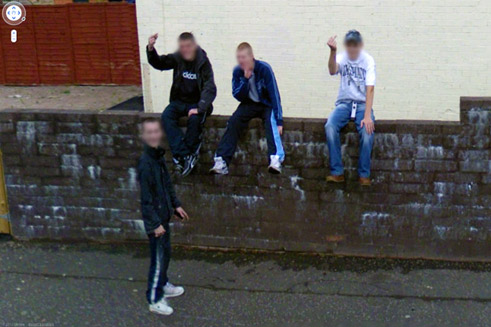
Jon Rafman, Selections from 9 Eyes of Google Street View, 2010
In his work for “Free” at the New Museum, Jon Rafman finds the shoeshiners in Google Street View. These are the few who were not indoors when Google camera cars drove out. A woman unclothed, her feet in the water, starring out at the waves on the coast in southern Italy. Four boys in tracksuits and trainers flashing rude hand gestures, perhaps shouting at the vehicle photographing them. Three men walking aimlessly through the wet grey-green grass in the Dutch countryside. They stand at a distance too far from each other to converse. The man nearest to the camera is wearing a kilted uniform. Is he a pilot? A police officer?
Google’s policy is to blur the faces of the individuals they photograph to protect their anonymity. Obscured by this ersatz bokeh, the people of Google Street View seem even more remote. It is difficult to determine one’s age, even race and gender. Vaguely rendered individuals seem like they are farther off in distance. They are photographed at an unknown moment in time, neither now nor obviously in the past, as indistinctly featured as the man and the shoeshiner.
The world of Google Street View looks eerily different from the crisp, color saturated digital photography that even a disposable camera can produce nowadays. Professional photographers generally avoid shooting in direct sunlight at midday, the conditions ideal for Google Street View cameras cars. Digital cameras are now designed to prevent the washed out look of harsh outdoor light, and in a pinch, Photoshop is there to amplify contrast and hue.
The slightly faded, sometimes blurry look of Google Street View appears without any time signifiers. No time stamps or indication as to what day the cars drove out. Paradoxically, the capacity to capture cities this way is a product of modern technology, but the degraded picture quality looks to come from a digital camera with so low a megapixel range it is no longer sold in stores. The blurred faces only amplify this confusion.
Time is just another thing to scramble and remix on the Internet. Now Google is in the process of reshooting everything in higher resolution, creating the possibility of an enormous geomatic archive if they continue the project. There are reports that the company intends to “refresh” the data every year. Eventually the quality of Street View photography will peak and the website will achieve a perfect atemporality. The image quality of 100 Oak St in Google Street View in 2015 will look no different from a 2025 representation. Date is then determined by recondite indications of the landscape and architecture transforming. No sepia tone, no lens flare occurs to sort these images into their respective moments in history.
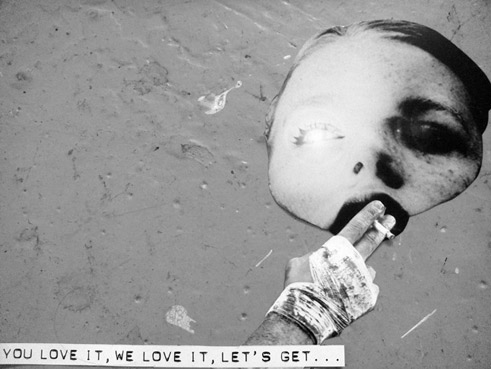
Clunie Reid, Take No Photographs Leave Only Ripples, 2010
Oliver Wendell Holmes called the daguerreotype a “mirror with a memory.” Clunie Reid’s exceptional collage series Take No Photographs Leave Only Ripples (2009) appears like a pastiche of this early photographic method of printing on reflective silver coated plates. But computer screens also reflect in certain light. In a contemporary context, Reid’s work reminds one of the uncanny experience of seeing your reflection in the glare of your monitor while deeply enmeshed in multiple tabs open in your web browser. Inkjet prints on silver foil, the mix of drawings, photographs, text, and media imagery explores sex, power, class, and technology. These are found images from websites striped of the website’s meaning and presented with the artist’s point-of-view. It is as though Reid is sharing every tab she opened in Firefox this week – along with commentary. Catching a glimpse of your reflection in the mirror-like prints is a subtle reminder of the role of the audience in the art experience.
For her slideshow projection, The Sun is Always Setting Somewhere Else (2006), Lisa Oppenheim took pictures of her hand holding snapshots of sunsets in front of actual sunsets. The horizons match up although the colors are not the same. The pictures she holds were taken by US soldiers stationed in Iraq. The artist found them on Flickr. The re-photographed images are a comment on the Internet enabled collapse of space and time. Learning the origin of these snapshots, the sunset becomes a symbol of homesickness, courage, hope, and fear. There is an artificial closeness created on image-sharing sites like Flickr, as we may observe a person’s life through his eyes in unedited streams of uploaded content. Few if any of the images these soldiers upload will ever be printed on paper. Oppenheim’s choice to print these pictures on an obsolescing form enhances the nostalgic quality. A snapshot of a sunset, like photographing an aircraft wing from the window in flight, is a momentary reflection on the possibility of the everyday. Sunsets never cease to be beautiful even in an unsafe place, far from home.
The online experience is generally a self-contained collage-like assemblage of windows and browser tabs open concurrently. The only through line is the user’s sense of curiosity and chance. Online information is generally distributed in asynchronous ways. You access a website sometime after it is created, at a moment convenient for you to receive it. But not everything online is available on demand. Martijn Hendriks’ Untitled Black Video (2008) details a rare shared experience online at a tense moment in recent history. The white text in the pitch black video is directly lifted from the comments section of a site where Saddam Hussein’s execution video was posted. These were among the first reactions to the unauthorized video, leaked cell phone captured footage. The comments express fear and anxiety, as well as cruel humor (“Haha maybe he’s still alive!”) Their anonymity frees them from cultural norms. To comment is to make one’s presence known, as there is no clear reward for engaging in this ad hoc online community. They are sharing an experience without exchanging faces or names. They could be anywhere in the world. All we know about the people who wrote these comments is that they were, at that moment, sitting behind a screen somewhere.
Aleksandra Domanovic’s video installation 19:30 (2010) makes use of the Jugoslavenska Radiotelevizija nightly news themes. It takes its name from the time the broadcast aired every night. But Yugoslavia, as a nation, now no longer exists. The past has an end in this particular archival project. After gathering these broadcast themes, Domanovic asked DJs to remix them, and the resulting music seems anchored to the years in which the nation was falling apart. One of the countdowns played on a vibraphone sounds as memorable as Brian Eno’s Microsoft Windows 95 theme. Others resemble jingles that could be used for commercials or broadcasts today. But most of the music strikes one as uncannily contemporary, sharing similar ground with a recent trend in music that rejects the aural perfection of digital recording. Writer Simon Reynolds and blogger K-Punk call it “hauntology” after Derrida’s concept that history gains relevance as time progresses. Cracks and fuzz are recreated and uncovered old-timey audio tracks are frequently sampled. It is not quite nostalgia, but an entirely different form of remembering the past. Music from anytime over the past hundred years may now sound like it comes from the early twentieth-first century.
The artists in “Free” at the New Museum demonstrate how the Internet shifts our perception of ownership. Before the Internet, no one ever had to think of whether or not his home might be photographed, freely and easily available for anyone in the world to see. Personal snapshots of a soldier stationed abroad would not be available to the wider public, rather these images would exist as stacks of glossy paper in a shoebox under the bed or pictures taped to the refrigerator. And recordings of Yugoslavian nightly news broadcast themes would collect dust someplace, if not lost or destroyed as new countries emerge in its wake.
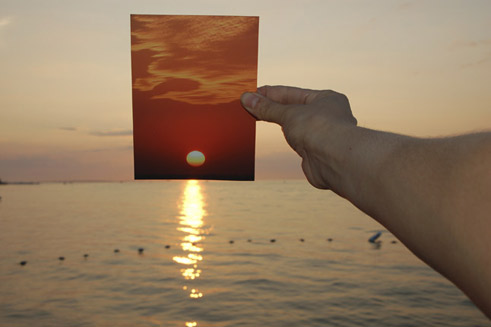
Lisa Oppenheim, The Sun Is Always Setting Somewhere Else, 2006
These are comments not just on the erosion of ownership, but the new frontiers of representation in a digital age. Everything on the Internet is free to see and explore at whatever moment one chooses. The meaning of a photograph of a sunset on the horizon changes when the photographer is a soldier stationed abroad. The meaning of art changes when it is viewed online as part of a personal collage integrated with whatever other desktop apps and browser tabs are open. It plays within the narrative of whatever other desktop apps and browser tabs are open. But if art is viewed in a museum it is a shared experience.
Boulevard du Temple never existed as Daguerre captured it. It never looked that empty. The street has for centuries remained a hub of shopping and entertainment. It is not even clear if the photograph was taken in 1839, some reports have it at 1838. The only thing known is the hour of day (roughly 8 in the morning.) This is the uncertainty of the images in Google Street View. You recognize your car is not in the driveway, so you must be at work, but what day did they photograph it exactly? Google Street View shows you your home as you never actually see it.
Information is scrambled online absent of obvious time indicators. Images no longer fade with age. With no physical object to play the music, recordings do not skip because of scratches in the disk. And as the tools we use to create peak in performance, the date of creation loses its relevance. Although the date is in the metadata of a digital photo or music file, or stamped on a blog entry, the swift ways in which people navigate online means the relevance of the date is not as immediate. Now the story, not the technology to capture it, determines a creative work’s moment in history.
Timelessness is also the mark of a profound work of art. Previously, the atemporal was elusive to artists using cameras, computers, and audio recorders to create. As the technology to produce creative work improves; video, sound, and picture quality plateaus in appearance. Now it is easier to create something ahistoric with tools and gadgets. These creations can be meaningful and look relevant to any age.
The future was once represented in fantastically romantic ways: white spacesuits, buildings infinite in height, interplanetary travel, alien interactions, an abundance of wealth, and robot servitude. Now the future is represented as something more compressed and accessible. The future is on the Internet, in those screens we glance at intermittently at all waking hours of the day. Our expectation is the “IRL” world will look not much unlike what we see today. It is a future of gradual changes, incorporating familiar aspects with new but not too crazy updated technology. What is in abundance is not wealth but information.
The idea of the future is now a distorted mirror. It is the future of screens. Like the daguerreotype, screens contain memory and reflection, as well as an unknown difference only discerning eyes can see. We are overfutured. We’ve reached the point where the past, present, and future look no different from one another.

SERGEI: …Let me ask you all this: What do you think has been the most important technological development of the last twenty years?
LUCIAN: [pauses] I don’t know… The MRI scanner?
DAPHNE: [pauses] Remotely operated killer drones?
PENNY: [pauses] Is it cell phone?
OSMIN: [enthusiastically] Oh, I know what it is! Online dating.
SERGEI: Exactly. Osmin was the only one who got it right. Except for the dating part, that is. It’s the internet, kids.
—Alexandre Singh, from School of Objects Criticized

i. Introduction
It seems unnecessary to foreground this essay with a statement about the internet’s importance, for this fact is permeating daily news, politics, and our personal lives every day. And yet, in contemporary art, its pervasiveness seems often misunderstood or overlooked. While the field of art online continues to thrive, art engaged with the internet does not need to exist there; because the internet is not just a medium, but also a territory populated and fought over by individuals, corporations, and governments; a communications tool; and a cultural catalyst.
The exhibition “Free” explores how the internet has fundamentally changed our landscape of information and our notion of public space. We can now be in public, while being alone and separate. Our shared territory has expanded beyond streets and schools to more distributed forms of collectivity. And, what constitutes the fabric of this publicness is not only the expanded sociality of the web but an accelerated, highly visual, hybridized commons. Free takes its name from free culture, a social movement that was defined and promoted most ardently by Lawrence Lessig in his momentous 2004 book by the same name. Free culture—the philosophy—recognizes the revolution the internet has caused in industries, like music and print publishing, and argues that it be dealt with as an opportunity for greater sharing and distribution of knowledge, rather than a threat. “Free”—the exhibition—is based in this commitment to openness but not directly about the movement itself. Rather it explores how artists are responding to the complex freedoms of a newly expanded public space: How they are examining possibilities, dilemmas, and ethics enabled by the seemingly endless availability and circulation of digital material; rooting out the information that is missing or hidden; and exploring how web aesthetics and logic have seeped across form.
“Free” is also partly inspired by “Dispersion,” an open-ended essay by the artist Seth Price that he tweaked and adjusted since 2002. In the words of writer Brian Droitcour, also a contributing essayist for the exhibition: “The essay examines artists’ attempts throughout the twentieth century to subvert the structures of the art world through conceptual strategies and new forms of media, and thus to reach new audiences.” It also explores how the essence of publicness has changed. Price writes: “…Collective experience is now based on simultaneous private experiences, distributed across the field of media culture, knit together by ongoing debate, publicity, promotion, and discussion. Publicness today has as much to do with sites of production and reproduction as it does with any supposed physical commons, so a popular album could be regarded as a more successful instance of public art than a monument tucked away in an urban plaza.”
“Dispersion” is freely available on Price’s website, but is also exhibited as a sculptural installation in “Free.” This coordination between the gallery and other spaces is shared by several other of the works on display. For some, the gallery is one stop in a larger network, which includes performances, books, archives, installations, websites, and dance parties. For others, the gallery is their final and most appropriate mode of display. The featured works emerge from different modes of artistic practice to form an open-ended inquiry not a conclusive one. Below I outline three themes that bind the works included.
ii. Where Ideas End
“Copying” in contemporary parlance has negative connotations—it is associated with theft and inauthenticy, being derivative. Among the works in “Free,” it is infused with a different, more multifaceted meaning, as it is the inherent basis of so many works. Here many works lift, borrow, and reframe digital images—not in a rebellious act of stealing or a deconstructive act of critique—but as a way to participate thoughtfully and actively in a culture that is highly circulated, hybridized, internationalized—if unevenly.
To discuss issues of adaptation and censorship, Lars Laumann turns to Helen Keller—author, political activist, and also the subject of scandals relating to plagiarism and free speech. In her memoir, The Story of My Life, she recounts a traumatic childhood experience where she was accused of lifting the plot of a story she had been read, and weaving it into a narrative of her own. The resulting trials she endured educated her—in harsh, quick terms—about the boundaries of ideas. On writing the story in question at age eleven, Keller wrote:
“My thoughts flowed easily; I felt a sense of joy in the composition. Works and images came tripping to my finger ends, and as I thought out sentence after sentence, I wrote them on my Braille slate.” And, after being run through a trial of accusation and inquisition: “Now, if words and images come to me without effort, it is a pretty sure sign that they are not the offspring of my own mind, but stray waifs that I regretfully dismiss… It is certain that I cannot always distinguish my own thoughts from those I read, because what I read becomes the very substance and texture of my mind.”1
This trouble over distinguishing is relevant to artists working within a shared culture that is deeply textured, reproduced, and regurgitative. Where others’ ideas stop and yours begin is a highly sensitive fault line with major ramifications. What material is and is not legitimate to appropriate are important, and murky, questions that often come into sharp focus when intellectual property is asserted.
The artist Takeshi Murata is interested in how culture—like the song “Happy Birthday”—can be part of our living environment, and yet legally out of grasp. Evoking the evolution of a folk song that is sung thousands of different times—each iteration unique—his works often copy, mutate, and personalize public imagery. The character Popeye is the flexible subject of I, Popeye (2010), his new single-channel video that premieres in “Free.” Here, Popeye is given endless visual treatments: he stands facing the camera as a 3D model, wearing a T-shirt with his own face on it; he rides through neon-colored geometric landscapes, eats spinach; and melts into puddles of electric colors. He is copied endless times, broken apart, and resurrected. Like images freely circulating in the public domain, Popeye’s identity is deeply hybrid–he seems to take on his own life, and yet constantly be altered and imprinted with use.
This notion of a hybrid form, where images are copied and adapted in a number of contexts, plays out in different ways throughout the featured works in “Free.” Andrea Longacre-White’s photographs begin with found images of car crashes, and are subjected to obsessive re-photographing until their original meaning is abstracted, and a materiality is imbued into their once ephemeral form. Clunie Reid and Rashaad Newsome are involved in processes of reclamation: Reid flips the meaning of found images, making submissive female bodies and objects talk back brashly; Newsome winds reproductions of hip-hop stars and their related lifestyle bling into self-styled heraldry, elevating quotidian, paparazzi photography into cultural emblems.
Other works involve an incredibly varied process. Amanda Ross-Ho works, many of which derive material from the web, are subjected to a seemingly endless cycle of versioning. Much like “Dispersion,” they are tweaked and adjusted, blown up, yanked across format—from images to sculptures and back again. To create 19:30 (2010), Aleksandra Domanovic traveled around the former Yugoslavia collecting “idents”—the graphical intro sequences to nightly news shows from national television stations. She then uploaded these clips online and encouraged DJs to use them as the basis for new techno tracks—a genre of music chosen for its sampling and variability, and also for the historic role it played within the ex-SFRJ as the first music craze to enter the region after borders collapsed, becoming its first transnational phenomenon. The work manifests as a gallery installation, a singular historical archive, and the soundtrack for parties internationally.
In the spirit of copying that is part homage and part participation, less theft that is shared by other artists, Domanovic stretches the original ideas of the “idents” out across a distributed culture, keeping their native history and ideas alive by keeping them moving.
iii. Unknown Unknowns2
This idea of endless and free appropriation leads us to a new set of questions: What isn’t free? What is hiding? What is repressed? Many works in “Free” point to what is kept out of the public domain, to what is unseen, and thus unknown. A trained geographer and visual artist, Trevor Paglen’s activity has long centered around the black budget—the part of the US federal budget that is blacked out, i.e. allocated towards classified operations. In “Free,” he presents four large-scale photographs, each one a visually stunning landscape, at first glimpse engaged with the aesthetics of landscape photography. Contained in each one, however, is evidence of classified information—for instance, Untitled (Predators; Indian Springs, NV) of 2010, which contains razor-thin black lines, the trails of predator drones that Paglen located by comparing the public, online records of NASA that track objects in the sky with similar records of amateur astronomers. Through collaboration with these communities of hobbyists, Paglen was able to research and locate information that was repressed from public view—but actually visible in plain sight. In an essay on the artist, the novelist and essayist Rebecca Solnit relates these black sites, or what we can’t see, to an impediment in democracy:
“The unseen itself is a vast realm, the black budget of the Pentagon, and the ‘black sites’ Paglen documents. Most people don’t make much effort to know about this realm, and the knowledge that emerges is quickly forgotten and dismissed. ‘We are a peaceful nation’ is a popular thing to say in the United States. Those who might say this have been denied the intelligence to know what is done in their name and to decide democratically whether it should be done. Or they have ducked it. The blank spots on the map that Paglen describes have their corollary in the blank spots in the mind and in public dialogue.”3
Where Paglen fills in our “blank spots on the map”4 through photographic evidence, other artists pick up seemingly minor evidence to point to larger cultural events. In The Sun is Always Setting Somewhere Else (2006), which is a slideshow containing images of the artist holding up images of sunsets taken by US soldiers serving in Iraq and Afghanistan against her own horizon, Lisa Oppenheim makes a seemingly trivial occurrence—an unspoken pattern among soldiers living away from home—illuminate a much larger fact: the ongoing reality of war. The rote beauty of a sunset here becomes a way to connect to something universally familiar. Homesickness isn’t a side of war discussed in top news headlines and yet here it is eloquently expressed.
This ability to not only participate in shared events remotely, but also to observe them is something new the internet enables. Now, reaction doesn’t need to be reported to us—we can see it. This is made clear in Martijn Hendriks brutal piece Untitled Black Video (2008), a reconstruction of a leaked cell phone video of Saddam Hussein’s execution as told through video comments. The work has no image—it features only text, in white font, projected on a black screen—each line a comment taken from the online chat rooms where the video was played. Frightened, callous, confused, the comments capture an immediate public reaction that crisscross all over the emotional map. Untitled Black Video captures a community response, revealing what can be said under the cloak of anonymity, and further how people respond to political events often hidden from them.
iv. New-ishness in an Expanded Public Space
Would this range of emotional expression in Hendriks video have been articulated before the mass, centralized platform of the internet? Probably. The substance of the reaction itself is not entirely new, but the anonymous, decentralized online platform is. “Free” asserts that our public space has expanded, but it doesn’t assert that it creates an entirely new culture—a “cyberspace.” Rather, several works, including Joel Holmberg’s Legendary Account (2007–10), which documents the artist asking questions in Yahoo! Answers simple Q&A service, and Hanne Mugaas’s Secondary Market (2010)—explore how social behavior and taste translates online. Part of a series entitled “Blue Screen Process,” Liz Deschenes’s Green Screen #4 (2001) points to the history of the moving image special effects tool. In the gallery, it is situated next to a live stream of video generated through a program called riverthe.net (2010), made by Ryan Trecartin and David Karp. As the green screen has evolved from an industry tool to a common function on the computer desktop, Deschenes’s work demonstrates how the fantasies of Hollywood and television are internalized, performed, embraced, and rejected in broader culture.
Alexandre Singh’s ambitious installation The School for Objects Criticized (2010) stands within “Free” as a space for consideration. The work—a play told between objects—features characters discussing a work that has just been transpired (although viewers can’t see it). The arbitrariness of their criteria for judging contemporary art and newness is thrown into light as they compare and contrast notes on the work. They both stand against the prevailing winds of change, and are racing to catch up with it—they parody and consider a culture at a crossroads, undergoing another evolution wrought by a new medium. Some of Singh’s dialogue is lifted from newspapers, and conversations with artists and curators, there is uncanniness to it. The play reflects back on our own predicament, and the ideas that play centrally within the show in terms of how artists and the culture industry reacts to a great change in our landscape of information. Like Singh’s work, “Free intends to raise questions—not answer them—to look at artists fighting, embracing, considering a common culture undergoing yet another sea change.
1. Helen Keller, The Story of My Life (New York: Bantam Classics, 1990).
2. United States Secretary of Defense Donald Rumsfeld.
3. Photographs by Trevor Paglen and text by Rebecca Solnit, Invisible. (New York: Aperture, 2010).
4. Trevor Paglen, Blank Spots on the Map (New York: NAL Trade, 2010).


Events
-
“Free” Artists in Conversation
– October 21st, 2010 – 7:00 PM -
Lecture and Walk with Artist Steve Lambert
– November 6th, 2010 – 3 PM -
DIS Magazine Presents: Interpreting the Scrunchie
– November 14th, 2010 – 3 PM -
New Style Curators
– November 18th, 2010 – 7 PM -
An evening with W.A.G.E.
– December 9th, 2010 – 7 PM -
Kickstarter Conversations
– December 11th, 2010 – 3 PM -
Refresh Cold Reads with César Alvarez
– December 11th, 2010 – 5:00 PM -
The Redacted Manuscript: a reading/ performance by Jill Magid
– December 16th – 8 PM -
Refresh Cold Reads with Bob Edgar
– December 18th, 2010 – 5:00 PM -
Finding Photography
– January 13th, 2011 – 7 PM
“Free” Artists in Conversation
October 21st, 2010 – 7:00 PM – New Museum Theater
Artists in “Free,” including Aleksandra Domanovic, Martijn Hendriks, Alexandre Singh, and Harm Van Den Dorpel, discuss their work and the show’s themes: What constitutes an expanded public space? How does a greater access to images, and a more democratically produced culture, affect their work? Participating artists present and discuss projects. Moderated by Lauren Cornell, Executive Director of Rhizome, New Museum Adjunct Curator, and curator of “Free.”

Free as in Freedom and Free as in Free Beer: Lecture and Walk with Artist Steve Lambert
November 6th, 2010 – 3 PM – New Museum Theater
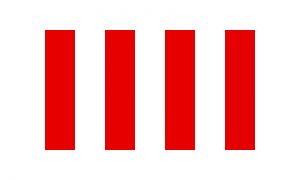
Artist Steve Lambert will discuss the various definitions of Free from human liberation, the law, freedom of movement, to economics. Tying together hippies, punk rock, Franklin Roosevelt and the Free Software movement. The program will begin with a short lecture, followed by a a short walking tour through the galleries and into the streets to see how these ideas apply in the real world.

DIS Magazine Presents:
Elastic Youth: Interpreting the Scrunchie
November 14th, 2010 – 3 PM – New Museum Theater
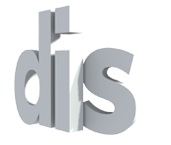
For the first in a series of lectures organized by the online fashion magazine DIS, Elastic Youth: Interpreting the Scrunchie, David Riley offers an in-depth analysis of the controversial hair accessory. Drawing on patent documents, fashion, and pop culture, he traces its history from mass marketed phenomenon to object of derision among the fashion elite. David Riley is an artist and musician living in NYC, known for his involvement with the band Mirror Mirror and the collaborative group The Society for the Advancement of Inflammatory Consciousness. He has exhibited and/or performed at The Kitchen, Momenta, John Connelly Presents, Klaus von Nichtssagend, Andrew Edlin, Audio Visual Arts (AVA) and Index Art Center, as well as venues around the USA and Europe.
Collaborators of Lizzie Fitch, a featured artist in Free, DIS Magazine are a fashion, art and commerce publication that seeks to expand creative economies. Beyond reporting the popular surfaces of culture, DIS materializes and projects contemporary identity poetics and politics. DIS is currently available in digital form at dismagazine.com. DIS is, collectively: Lauren Boyle, Solomon Chase, S. Adrian Massey III, Marco Roso, Patrik Sandberg, Nicholas Scholl, and David Toro.

New Style Curators
November 18th, 2010 – 7 PM – New Museum Theater
Last year, the New York Times proclaimed, “The Word ‘Curate’ No Longer Belongs to the Museum Crowd.” This panel takes a look at “curation” online and how the word applies to social media and Internet use. New media companies sometimes hire “curators” to filter the web for specialized information and data. But missing from this analogy is the importance of context and preservation. Are we all curators of the web? How are sites like Tumblr and Delicious contributing to this trend? Does the Internet even need curation? What can social media learn from the art world? More importantly, with everyone busy curating, who is making the original content online? Joanne McNeil will moderate a panel including Paddy Johnson (Art Fag City), Rex Sorgatz (Kinda Sorta Media), and Ceci Moss (Rhizome).

An evening with W.A.G.E. (Working Artists and the Greater Economy)
December 9th, 2010 – 7 PM – New Museum Theater
An evening with W.A.G.E. (Working Artists and the Greater Economy)
Free to Members, $8 General Public
In conversation with April Britski, Executive Director of CARFAC (Canadian Artists’ Representation/Le Front des Artistes Canadiens) and curator Lauren Cornell, representatives from W.A.G.E. will discuss practical aspects of the exhibition budget of Free and themes regarding the compensation of exhibiting artists at institutions in the U.S. and Canada.

Kickstarter Conversations
December 11th, 2010 – 3 PM – New Museum Theater
Founded in 2009, Kickstarter is the largest funding platform for creative projects in the world. Every month, tens of thousands of people pledge millions of dollars to projects from the worlds of music, film, art, technology, design, food, publishing and other creative fields. Kickstarter is a new form of patronage and commerce: creators offer products and experiences that are unique to each project, and keep 100% ownership and control over their work. What underlies Kickstarter’s straightforward premise is a powerful alternate model of funding for the arts: one that enables creators, of all stripes, to realize their projects without the support of the grants, galleries, or the larger art world apparatus. It also raises certain fundamental questions: such as, does art lose its mystique if it is financing is laid bare? How do artworks exist outside the parameters of the art world? Is art, in 2010, at home in mass culture? For this panel, Kickstarter founders Perry Chen and Yancey Strickler will be in conversation with artists who have successfully used this platform to realize projects: Michael Crowe & Lenka Clayton (of Mysterious Letters), Zana Briski (of Reverence & Born Into Brothels), Zach Lieberman (of EyeWriter).

Refresh Cold Reads with César Alvarez
December 11th, 2010 – 5:00 PM – New Museum 2nd floor
Museum visitors are invited to perform live impromptu cold reads of the Refresh transcripts with guest readers who have been cast by Kristin Lucas. The Refresh transcripts document an exchange that took place between Lucas and a Judge in name change court in 2007. Lucas will be present to introduce the guest readers who were chosen based on their own life experience. César Alvarez will read for the part of Kristin because of his personal name story.
César James Alvarez is named after César Cauce and Dr. James Waller, two victims of the Greensboro Massacre. On November 3 1979, members of the KKK caravaned through an Anti-Klan protest at a public housing project in Greensboro, NC. After verbal altercations the Klansmen pulled guns from the trunks of their cars and opened fire on the demonstrators, killing 5 and injuring 11 others. Alvarez grew up with 2 other Césars who were named for Cauce. He has lived, together with the others, in remembrance of those who died. His name has always signified the loss of a close family friend along with the hope for rebirth, healing, and courage to stand up for justice. There are many others who share the names of the 5 victims of the Greensboro Massacre. The multiplication of these names represents a ripple of loss sent through a community and the desire to keep their memory and values alive.

The Redacted Manuscript: a reading/ performance by Jill Magid
December 16th – 8 PM – 2nd Floor Galleries
Jill Magid’s performance-based work involves immersing herself in systems of authority in order to explore issues of vulnerability, observation, and trust. The Redacted Manuscript is a performance based on her experiences working with the Dutch secret service (AIVD). Commissioned by the AIVD to create an artwork for their headquarters, Magid immersed herself in the intelligence agency’s methods, using the tactics of the organization to interview and collect personal information on undercover agents. Surprised by her ability to penetrate the organization to such depths, the agency censored many of the resultant artworks, including redacting a substantial portion of Magid’s manuscript for a novel based on her experience. In a dramatic conclusion to the AIVD commission, the Dutch Ministry of Interior confiscated the original version of Magid’s manuscript was while it was on view in her exhibition at Tate Modern earlier this year. The Redacted Manuscript will be performed by the artist and four actors.

Refresh Cold Reads with Bob Edgar
December 18th, 2010 – 5:00 PM – New Museum 2nd Floor
Museum visitors are invited to perform live impromptu cold reads of the Refresh transcripts with guest readers who have been cast by the artist. The Refresh transcripts document an exchange that took place between Lucas and a Judge in name change court in 2007. Lucas will be present to introduce the guest readers who were chosen based on their own life experience. Bob Edgar will read for the part of Judge because of his professional capacity to influence change.
Bob Edgar is the Vice President of Donor Relations for NY Community Trust, a New York City community foundation that assists donors with charitable giving. Like his great-great grandfather, Judge Hugh Lennox Bond, a humanitarian and early civil rights leader appointed by President Lincoln with the task of integrating the South, Bob Edgar also holds a position of social importance. His awareness of emerging issues and the changing needs of the public directly influences charitable activity and has a profound impact on public life. Edgar asked that his honorarium for participation in the event series be redirected as a charitable gift to The Osborne Association.
“The Osborne Association offers opportunities for individuals who have been in conflict with the law to transform their lives through innovative, effective, and replicable programs that serve the community by reducing crime and its human and economic costs.” http://www.osborneny.org/

Finding Photography
January 13th, 2011 – 7 PM – New Museum Theater
Organized and moderated by Matt Keegan, featuring Roe Etheridge, Tim Barber, Mary Manning and Laurel Ptak.
This conversation with notable photographers and founders of websites, such as Tiny Vices, I Heart Photograph and Unchanging Windows, will explore how the web not only affects the discovery of new photography, but also its distribution, interpretation and creation. With an emphasis on images and short text publishing encouraged by popular platforms like Tumblr, does photography lose depth? Does the continual circulation and re-presentation of photographs affect the work, itself? Is photography more resilient to change because we live in an image saturated culture? Panelists will present their projects, and discuss these questions, and more through audience Q&A.

Credits
“Free” was made possible by several generous individuals and organizations, who I would like to acknowledge. First, the artists. It was my great pleasure to be in conversation with all twenty-two of them during the run-up to the show. I have been inspired by our conversations, and am truly honored to feature their work-much of which was made especially for “Free”-and engage the public around it over the next three months.
I would also sincerely like to thank The Andy Warhol Foundation for the Visual Arts, without whom this exhibition would not have been possible. Their belief in and generous lead support for “Free” at an early stage turned a vision into a reality. Major support also was provided by Shane Akeroyd, who has steadfastly supported adventurous programs at the New Museum. The New York State Council on the Arts–and Karen Helmerson, in particular-as well as the Toby Devan Lewis Emerging Artists Fund provided much appreciated additional support. The Mondriaan Foundation, Amsterdam; the Office for Contemporary Art Norway; and the Royal Norwegian Consulate General all contributed to artists projects and travel, a genuine reflection of their support of cultural exchange between Europe and the United States.
At the New Museum, I would like to thank Lisa Phillips, Toby Devan Lewis Director, for the opportunity to organize this exhibition and for her ongoing advice. My great thanks to the dynamic and unflagging exhibition crew, particularly Joshua Edwards, who was a partner on the installation design and a true advocate for exhibiting the artist work as powerfully and truly as they outlined. Also Shannon Bowser, Chief Preparator, and Victoria Manning, Registrar, and the entire crew. Associate Directors Regan Grusy and Karen Wong and Deputy Director John Hatfield for their invaluable contributions to realizing this exhibition and for their enthusiasm, and Communications Officer
Gabriel Einsohn for her active and intelligent efforts to translate the show from an early stage to a broad audience. Also Jess Ramsay, Exhibition Assistant, who gracefully coordinated logistics in the lead-up to the show. And, everyone else at the Museum, who contributed—thank you.
I brought my constant collaborators and esteemed colleagues from Rhizome to produce online aspects of “Free” specifically Senior Editor Ceci Moss who will edit this website, Associate Director John Michael Boling who designed it, and Jonathan Vingiano, now New Museum staff, who realized it. Rhizome’s Director of Technology Nick Hasty programmed and contributed creatively to Ryan Trecartin and David Karp’s River the Net. I am also grateful to the luminary group of essayists who will help bring the themes and works to life for our readers: Brian Droitcour, Caterina Fake, Ceci Moss, Ed Halter, and Joanne McNeil.
Last, but not least, from the Rhizome Board, thanks to Lisa Roumell for her belief in my curatorial efforts, and Fred Benenson for his essential advice on this exhibition, and to extra-institutional friends and colleagues: Cory Arcangel, Fred Benenson, Chet Gulland, Matt Keegan, Lanka Tattersall and Matt Wolf.

Elastic Youth: Interpreting the Scrunchie Video
Here’s a video of the lecture Elastic Youth: Interpreting the Scrunchie by David Riley, organized by DIS Magazine. The lecture comprised part of the programming for “Free”.

Free Culture by Lawrence Lessig
Excerpt below from the Preface to Free Culture: How Big Media Uses Technology and the Law to Lock Down Culture and Control Creativity by Lawrence Lessig, from Penguin Press, 2004.
…Free Culture is about the troubles the Internet causes even after the modem is turned off. It is an argument about how the battles that now rage regarding life on-line have fundamentally affected “people who aren’t online.” There is no switch that will insulate us from the Internet’s effect.
But unlike Code, the argument here is not much about the Internet itself. It is instead about the consequence of the Internet to a part of our tradition that is much more fundamental, and, as hard as this is for a geek-wanna-be to admit, much more important.
That tradition is the way our culture gets made. As I explain in the pages that follow, we come from a tradition of “free culture” – not “free” as in “free beer” (to borrow a phrase from the founder of the free-software movement) but “free” as in “free speech,” “free markets,” “free trade,” “free enterprise,” “free will,” and “free elections.” A free culture supports and protects creators and innovators. It does this directly by granting intellectual property rights. But it does so indirectly by limiting the reach of those rights, to guarantee that follow-on creators and innovators remain as free as possible from the control of the past. A free culture is not a culture without property, just as a free market is not a market in which everything is free. The opposite of a free culture is a “permission culture” – a culture in which creators get to create only with the permission of the powerful, or of creators from the past.
If we understood this change, I believe we would resist it. Not “we” on the Left or “you” on the Right, but we who have no stake in the particular industries of culture that defined the twentieth century. Whether you are on the Left or the Right, if you are in this sense disinterested, then the story I tell here will trouble you. For the changes I describe affect values that both sides of our political culture deem fundamental.

On Commonwealth by Antonio Negri
Excerpt from “On Commonwealth” by Antonio Negri, written in October 2009. Here, Negri describes some of the basic ideas elaborated in the book Commonwealth, co-written with Michael Hardt, published on Harvard University Press in 2009.
Before Commonwealth, we published Empire and Multitude.
Whilst Empire was a book that could be immediately understood from the point of view of the spatiality of power, Multitude presented some problems. In particular, the question of how the multitude could organise itself.
So the first issue we confront in Commonwealth is the becoming Prince, in Machiavellian terms, of the multitude. I am not following the thread of the book here. I am just trying to outline the problems we set out to confront in the book.
We thought that the possibility of giving a structure, or a spine, a backbone to the multitude resided in the concept of the common.
So, what is this concept of the common?
First of all, let me say a small footnote on its naturalistic dimensions. We all know that the common is water, air, soil, the sea, land, etc. but we are interested in the human-made common, because the naturalist common has long been reabsorbed in the productive structures of capitalism.
So the problem we confront in the book is the definition of the common inside the multitude.
The notion of the common and the notion of multitude tend to be juxtaposed and confounded. They are interchangeable notions, the constitution of the common and the multitude. That is to say, the common does not precede or follow the multitude: the making of the multitude is the common.
All of this obviously occurs within capitalism and capitalism is always a social relation, one between those who command and those who obey, between fixed and variable capital.
So we need to build the concept of the common inside the relation of capital. Here capital is presented as struggle, as a common that is there, but that was historically appropriated by capital and continuously subjected, in the process of its making, to capital.
But today the common is the name of capitalism: capitalism today is capitalism of the common. People who insist on private property today are actually talking about the private property of capital, which is the common of capital against the property-less.
Here we find the great bifurcation of our times, which is the new technical composition of labour power, inside and outside the common but expropriated of its capacity and possibility of enjoying it.
The general context of the development of this bifurcation is biopolitical, and in the book Commonwealth we dedicate a chapter to explaining how this bifurcation is one of the concept of capital itself, where one divides into two: on the one hand, the communism of capital, on the other hand, the precarisation of this new labour power.

Take the W.A.G.E. Survey
W.A.G.E. (Working Artists and the Greater Economy), who organized an event in conjunction with Free last month and named Free their first W.A.G.E.-certified show, have announced that they are conducting a survey in order to provide greater transparency regarding the economic practices of arts organizations in New York City. They are polling visual and performance artists who have worked on exhibitions in New York with either or both:
Small to Medium Non-Profit Institutions
Large Non-Profit Institutions & Museums
Visit the links above to take the survey.

Ways of Seeing, Chapter 1 by John Berger
Excerpt from Chapter 1 of Ways of Seeing by John Berger, pages 7-34. From Penguin Books, 1977.
What the modern means of reproduction have done is to destroy the authority of art and to remove it — or, rather, to remove its images which they reproduce — from any preserve. For the first time ever, images of art have become ephemeral, ubiquitous, insubstantial, available, valueless, free. They surround us in the same way as a language surrounds us. They have entered the mainstream of life over which they no longer, in themselves, have power…
If the new language of images were used differently, it would, through its use, confer a new kind of power. Within it we could begin to define our experiences more precisely in areas where words are inadequate. (Seeing becomes before words.) Not only personal experience, but also the essential historical experience of our relation to the past: that is to say the experience of seeking to give meaning to our lives, of trying to understand the history of which we can become the active agents.
The art of the past no longer exists as it once did. Its authority is lost. In its place there is a language of images. What matters now is who uses that language for what purpose. This touches upon questions of copyright for reproduction, the ownership of art presses and publishers, the total policy of public art galleries and museums. As usually presented, these are narrow professional matters. One of the aims of this essay has been to show that what is really at stake is much larger. A people or a class which is cut off from its own past is far less free to choose and to act as a people or a class that on has been able to situate itself in history. This is why – and this is the only reason why – the entire art of the past has now become a political issue.

The Gift: Creativity and the Artist in the Modern World by Lewis Hyde
Excerpt from the Introduction to The Gift: Creativity and the Artist in the Modern World by Lewis Hyde, pages 2-4. From the Second Vintage Books edition, 2007.
It is the assumption of this book that a work of art is a gift, not a commodity. Or, to state the modern case with more precision, that works of art exist simultaneously in two “economies,” a market economy and a gift economy. Only one of these is essential, however: a work of art can survive without the market, but where there is no gift there is no art.

New in Stock, a photo essay by DIS
In conjunction with “Free,” DIS documents the work and the art going experience while borrowing conventions from stock photography. The characters pictured in these documents are tourists, students, dealers, art administrators, curators, docents, and emerging artists.
DISimages.com is a serial project focused on manipulating the codes of stock photography to answer questions that have not yet been asked. By generating new stock options, DIS will broaden the spectrum of lifestyle portrayal.
Photographer
Marco Roso
Stylists
Lauren Boyle and Solomon Chase
Photography Assistant
Angela Hau
Stylist Assistant
Akeem Smith
Hair
Katsuhiro Suzuki
Makeup
Mari Susuda
Hair Assistant
Orie Shishido
Casting
Preston Chaunsumlit
Featuring
Britta Thie, Avril Sergeon,Vanessa Sergeon, Zoë Salditch, Sookram Jairam, Felix Lee, Lauren Burns-Coady, Ceci Moss, Lauren Cornell, Richard Haines, David Horvitz, Kai Kühne, Omar Rahim, Francis Carlow, Leigha Mason, Gilbert Rolle, Matthew Whitley, Shawn Maximo, Oscar Sanabria, Fabrizio Sanabria, Aliya Feldman, Greg Barton, Géraldine Bretault, Rick Herron, Joanne Cheung, Tommy Wasserman, Marissa, Quasia Risper

Tags
- amanda ross-ho,
- andrea longacre-white,
- clunie reid,
- jill magid,
- liz deschenes,
- lizzie fitch,
- seth price,
- trevor paglen
Two Bits: The Cultural Significance of Free Software by Christopher M. Kelty
Excerpt from the Introduction to Two Bits: The Cultural Significance of Free Software by Christopher M. Kelty, pages 2-4. Originally published on Duke University Press, 2008.
Free Software is a set of practices for the distributed collaborative creation of software source code that is then made openly and freely available through a clever, unconventional use of copyright law. But it is much more: Free Software exemplifies a considerable reorientation of knowledge and power in contemporary society—a reorientation of power with respect to the creation, dissemination, and authorization of knowledge in the era of the Internet. This book is about the cultural significance of Free Software, and by cultural I mean much more than the exotic behavioral or sartorial traits of software programmers, fascinating though they be. By culture, I mean an ongoing experimental system, a space of modification and modulation, of figuring out and testing; culture is an experiment that is hard to keep an eye on, one that changes quickly and sometimes starkly. Culture as an experimental system crosses economies and governments, networked social spheres, and the infrastructure of knowledge and power within which our world functions today— or fails to. Free Software, as a cultural practice, weaves together a surprising range of places, objects, and people; it contains patterns, thresholds, and repetitions that are not simple or immediately obvious, either to the geeks who make Free Software or to those who want to understand it. It is my goal in this book to reveal some of those complex patterns and thresholds, both historically and anthropologically, and to explain not just what Free Software is but also how it has emerged in the recent past and will continue to change in the near future.
The significance of Free Software extends far beyond the arcane and detailed technical practices of software programmers and “geeks” (as I refer to them herein). Since about 1998, the practices and ideas of Free Software have extended into new realms of life and creativity: from software to music and film to science, engineering, and education; from national politics of intellectual property to global debates about civil society; from UNIX to Mac OS X and Windows; from medical records and databases to international disease monitoring and synthetic biology; from Open Source to open access. Free Software is no longer only about software—it exemplifies a more general reorientation of power and knowledge.
The terms Free Software and Open Source don’t quite capture the extent of this reorientation or their own cultural significance. They refer, quite narrowly, to the practice of creating software—an activity many people consider to be quite far from their experience. However, creating Free Software is more than that: it includes a unique combination of more familiar practices that range from creating and policing intellectual property to arguing about the meaning of “openness” to organizing and coordinating people and machines across locales and time zones. Taken together, these practices make Free Software distinct, significant, and meaningful both to those who create it and to those who take the time to understand how it comes into being.
In order to analyze and illustrate the more general cultural significance of Free Software and its consequences, I introduce the concept of a “recursive public.” A recursive public is a public that is vitally concerned with the material and practical maintenance and modification of the technical, legal, practical, and conceptual means of its own existence as a public; it is a collective independent of other forms of constituted power and is capable of speaking to existing forms of power through the production of actually existing alternatives. Free Software is one instance of this concept, both as it has emerged in the recent past and as it undergoes transformation and differentiation in the near future. There are other instances, including those that emerge from the practices of Free Software, such as Creative Commons, the Connexions project, and the Open Access movement in science. These latter instances may or may not be Free Software, or even “software” projects per se, but they are connected through the same practices, and what makes them significant is that they may also be “recursive publics” in the sense I explore in this book. Recursive publics, and publics generally, differ from interest groups, corporations, unions, professions, churches, and other forms of organization because of their focus on the radical technological modifiability of their own terms of existence. In any public there inevitably arises a moment when the question of how things are said, who controls the means of communication, or whether each and everyone is being properly heard becomes an issue. A legitimate public sphere is one that gives outsiders a way in: they may or may not be heard, but they do not have to appeal to any authority (inside or outside the organization) in order to have a voice. Such publics are not inherently modifiable, but are made so—and maintained—through the practices of participants. It is possible for Free Software as we know it to cease to be public, or to become just one more settled form of power, but my focus is on the recent past and near future of something that is (for the time being) public in a radical and novel way.
The concept of a recursive public is not meant to apply to any and
every instance of a public—it is not a replacement for the concept of a “public sphere”—but is intended rather to give readers a specific and detailed sense of the non-obvious, but persistent threads that form the warp and weft of Free Software and to analyze similar and related projects that continue to emerge from it as novel and unprecedented forms of publicity and political action.

Tags
- free,
- free software,
- public,
- reference
Kickstarter (Mini) Conversations
In advance of the Kickstarter Conversation tomorrow at the New Museum at 3pm, we spoke with a few of the artists on the upcoming panel about their experience using the site to raise funds for their projects.
ZANA BRISKI
Briski is a New York-based photographer whose X documentary Born into Brothels won an Academy Award for best documentary. The film, co-directed by Ross Kauffman, is a portrait of several children who live the red light district of Calcutta. Briski employed Kickstarter to fundraise for her current project the Migratory Museum, detailed below.
Can you describe how you discovered Kickstarter, and managed your Campaign?
I spend most of my time disconnected in wild places. My dearest friend and collaborator Jeff Magness keeps me up to date with the things that I need to know about. He suggested I do a Kickstarter campaign and I was resistant at first because I needed to raise quite a bit more than the average project. I also was reluctant to make the project so public at such an early stage. It took several months for me to decide to do it. And part of the reason in the end was the desire to start building a community of supporters – not just financial supporters – but to test the waters to see if this really is a good idea. The response was overwhelming – everyone had a mantis story to share! I was often moved to tears reading them. I responded to every backer personally so it was quite a lot of work, but well worth it and so very gratifying. I even received some beautiful thank you cards for the rewards I sent out. It seems everyone wants to jump on the mantis bandwagon! I’m a big fan of Kickstarter – the concept, the elegant squeaky-clean design and how well it is managed. It works and it’s needed.
When you describe a migratory museum, what do you mean? And, can you share the current status of the project?
Reverence is a museum that will travel to several cities around the world. It is not a tent – it will be a more substantial structure, but it will be temporary. Maybe it will find a final resting place for a more permanent exhibition. It’s migratory rather than traveling because that’s what some insects do – they migrate.
I am currently working with the architect Shigeru Ban. I have written the proposal, handed over the check and now I, like a mantis, will wait patiently. Next I need to convince the mayor how absolutely necessary it is to have a giant mantis eggpod land in Central Park in 2012. I think he’ll understand.
MICHAEL CROWE & LENKA CLAYTON
Crowe and Clayton initiated Mysterious Letters in 2009. The goal is to write a letter to everyone in the world; and began with two small towns. In April 2009, they sent a personal, handwritten letter to each of the 467 households in the small Irish village of Cushendall. They artists “these unsolicited letters would prompt neighbourly discussion, spreading across the town, promoting community curiosity.” In November 2009, they continued the project in Pittsburgh, sending a bundle of letters to each home in the neighborhood, Polish Hill.
What did you write about in your letters? Were they personalized?
We wrote about everything, from forests in Kentucky to the food in Ben Afflek’s refrigerator. Often we’d run out of ideas and we’d get friends to give us a list of topics to write about (Prison, mice, Sol Le Witt, turnips, etc.). All the letters are scanned and online. Some of them were personalized, we’d walk around the towns (in detective mode), making maps, scrawling notes about homes and taking secret photos. These tended to lead to stalkerish letters though, even if we just wrote, “Love those yellow roses in your garden, smashing!” So we don’t do that personalized thing so much now. We try to make them cheerful, chirpy, the sort of thing a slightly drunk great grandmother would like. Oh yes, the Old People’s Homes, we let them in on the secret, as we don’t want to upset them.
What was the response to the letters like? Did it differ between Ireland and the U.S.?
Initially we weren’t supposed to know anything about what people thought of the letters. We were just going to write all the letters, leave, then send them all from afar. We see the hundreds of discussions neighbours have about their letters as the art, not the letters themselves. Friends often thought it was a bit perverse not to want to know what these towns thought of the letters but we were happy to just leave them to it and move on to the next place. Then, in Ireland a BBC television news crew picked up the story, so we saw about 0.01% of the reaction, a mix of bafflement, mild worry and fun. Mostly though, we don’t know.
Later when we did it in Pittsburgh a similar thing happened, it was on television news and Associated Press picked up on it. Some residents were a bit afraid, despite our best friendly efforts; other people just really loved it. One FBI guy apparently was interested in launching a class action lawsuit, thinking something terrible was afoot. We got occasional emails from a couple of the worried people later, but weirdly they seemed to really like the idea once we said “hello” back. Lenka lives near the area and people thank her for their letters to her to this day (there aren’t many people in Pittsburgh called Lenka).
Can you describe how you discovered Kickstarter, and later managed your Campaign?
About two weeks before doing Mysterious Letters in Pittsburgh we chanced upon Kickstarter. It was pure luck, after exhaustive 24 hour, 9 days a week internet searching for nothing in particular. Just washed ashore on it at 5am. We really really really really needed the money, because we funded the first Letters in Ireland. The campaign was managed with a sort of clueless enthusiasm. We only had 2 weeks to raise $2000 and it’s hard to know what people want. We added the sorts of incentives that we’d want, like drunken letters, fragments from the Eiffel Tower with a love letter, silly, curious oddities. All through the campaign we added new pledges which we thought were fun, good value, and in the spirit of the project. Also we pestered the living daylights out of everyone we knew.

VVORK: Variety Evening at the New Museum Video
In this clip at 14:30, artist Kristin Ross performs “Refresh” – a work on display in Free. “VVORK: Variety Evening at the New Museum” was organized by Vienna-based collective VVORK on the 30th of October, 2010 as part of Rhizome’s New Silent Series at the New Museum. The event was “a contemporary variety show, composed of daring and experimental translations of original artworks. Variety is inspired by how culture of all kinds—sound, moving image, graphics—cycles easily between states and forms.” Artists included: Wojceich Kosma, Vladimir Nikolic, Tao Lin, Kristin Lucas, Adrian Piper, Pierre Bismuth, and Claire Fontaine.

Tags
- kristin lucas
Illuminated Manuscripts: Alexandre Singh’s “Assembly Instructions” by Brian Droitcour
[Originally published in Rhizome News, Wednesday, November 4, 2009]
Storytelling is the backbone of Singh’s work; several of his exhibition projects were spawned by his thousand-page book, The Marque of the Third Stripe, a fictionalized biography of Adidas founder Adi Dassler. It is probably not uncommon for artists to experience a sense of futility when they set about making objects, when “it’s all been done.” Artists like Singh give heft to their works by imbuing them with symbolic power in the context of narratives of their own making. Singh uses many sources, but professes a fondness for surfing Wikipedia. In an interview with ArtReview, he said: “The Surrealists made an art of finding drawings in the grain of wood. I think I do the same finding stories in the grain of Wikipedia.” The superficiality and transience that make the user-generated encyclopedia a dubious resource for research are boons for a creative reader like Singh, because they make room for drawing new, unlikely connections.
The idea of Wikipedia–or more broadly, the internet–as a restless data set that denies autonomous spaces for myth and history, news and fiction, offers one perspective for considering Singh’s work. The slippery transparency sheets he uses as slides make for a satisfying dramatization of the flat flipping of web pages on a screen. His unbound books become legible for his audience when the overhead projector’s beam of light transforms their horizontal pages into images on the wall–a low-tech, small-scale, fairy-tale version of the mass media beaming content to the people. Of course, the internet metaphor fails to provide an exhaustive reading of the Assembly Instructions Lectures. There is a lot more going on, and all real and imagined similarities between the overhead projector and more sophisticated broadcast media vanish in the striking moments when Singh exploits his chosen medium’s unique physical properties. In the Ikea lecture, as he layered images of equestrian statuary on top of each other to illustrate the conventions of that genre, the darkening filmy buildup of transparencies offered silent “proof” for the thesis that white light is one of the components of brown.

Tags
- alexandre singh
New Style Curators Video
For those who may have missed it, here’s a video of the New Style Curators panel that happened on November 18th. The event was organized by Joanne McNeil in conjunction with the Free exhibition.
Last year, the New York Times proclaimed, “The Word ‘Curate’ No Longer Belongs to the Museum Crowd.” This panel takes a look at “curation” online and how the word applies to social media and Internet use. New media companies sometimes hire “curators” to filter the web for specialized information and data. But missing from this analogy is the importance of context and preservation. Are we all curators of the web? How are sites like Tumblr and Delicious contributing to this trend? Does the Internet even need curation? What can social media learn from the art world? More importantly, with everyone busy curating, who is making the original content online? Joanne McNeil will moderate a panel including Paddy Johnson (Art Fag City), Rex Sorgatz (Kinda Sorta Media), and Ceci Moss (Rhizome).

In Defense of the Poor Image by Hito Steyerl
[Originally published in e-flux's journal #10, November 2009]
The poor image is a copy in motion. Its quality is bad, its resolution substandard. As it accelerates, it deteriorates. It is a ghost of an image, a preview, a thumbnail, an errant idea, an itinerant image distributed for free, squeezed through slow digital connections, compressed, reproduced, ripped, remixed, as well as copied and pasted into other channels of distribution.
The poor image is a rag or a rip; an AVI or a JPEG, a lumpen proletarian in the class society of appearances, ranked and valued according to its resolution. The poor image has been uploaded, downloaded, shared, reformatted, and reedited. It transforms quality into accessibility, exhibition value into cult value, films into clips, contemplation into distraction. The image is liberated from the vaults of cinemas and archives and thrust into digital uncertainty, at the expense of its own substance. The poor image tends towards abstraction: it is a visual idea in its very becoming.
The poor image is an illicit fifth-generation bastard of an original image. Its genealogy is dubious. Its filenames are deliberately misspelled. It often defies patrimony, national culture, or indeed copyright. It is passed on as a lure, a decoy, an index, or as a reminder of its former visual self. It mocks the promises of digital technology. Not only is it often degraded to the point of being just a hurried blur, one even doubts whether it could be called an image at all. Only digital technology could produce such a dilapidated image in the first place.
Poor images are the contemporary Wretched of the Screen, the debris of audiovisual production, the trash that washes up on the digital economies’ shores. They testify to the violent dislocation, transferrals, and displacement of images—their acceleration and circulation within the vicious cycles of audiovisual capitalism. Poor images are dragged around the globe as commodities or their effigies, as gifts or as bounty. They spread pleasure or death threats, conspiracy theories or bootlegs, resistance or stultification. Poor images show the rare, the obvious, and the unbelievable—that is, if we can still manage to decipher it.

Tags
- circulation,
- copyright
Cut and Paste by Charlie White
[Originally published in Artforum, March 2009]
One could argue that the current financial meltdown has been lurking behind every corner–that with each new height of global wealth, voices of reason warned that the bottom would surely fall out. Perhaps one such bellwether was the return of certain modernist strategies in art. Although most recuperations of this sort have been merely decorative or nostalgic, a few have been symptomatic of a desire to confront art’s embeddedness within political crisis, market fluctuation, and consumer taste. Collage–the medium of modernist shock par excellence–has made one such return: Though never completely absent from contemporary art practices, collage had become a lesser-used aesthetic language during the past three decades. Spurred back into play precisely amid dire political circumstances, images of terror, and an unending war, collage seems to be riding a wave of political corruption, shrapnel, and personal loss to reemerge as a legitimate contemporary language.
But the manner in which collage can make meaning–in an atmosphere now dense in remixes, mash-ups, and shuffles–will be very different than it was in times of crisis past. Today, collage must confront its status as a form that has risen rapidly in postwar popular culture, making it a natural impulse for all media. It is not only a common response to the layers of information that burden us but also an invisible force that reorganizes histories, logs, and lineages to be more readily accessible–now an everyday necessity. I would like to take collage’s recent resurgence in art as an occasion to revisit and update its related popular histories–a shifting story, one that hovers at the fluid seam of art, politics, technology, and mass media.

Tags
- amanda ross-ho,
- collage,
- remix
Let’s call the whole thing off: Martijn Hendriks interviewed by Nicole Edwards
[Excerpt below from an interview with Free artist Martijn Hendriks by Nicole Edwards, originally published on the occasion of Hendriks' solo exhibition Let’s Call the Whole Thing Off, MIC Toi Rerehiko, Auckland, May – June 2009]
NE: You have expressed your interest in exploring the possible role of art as a form of ‘critical iconoclasm’. How do you perceive the relationship between your own strategies of intervention through negation and iconoclasm?
MH: I think that both are caught up in a kind of split situation, which interests me; the split situation of drawing attention to the very subject of the images that are destroyed or negated. Any form of iconoclasm, it seems, both introduces an act of negation and reproduces what it destroys. Even if it is no longer present or visible, iconoclasm reproduces its object by bringing it back to our attention somehow, or bringing it to memory. That doubleness is more interesting to me than any thinkable form of true nihilism or complete negation. There is a sort of dialogue or level of communication in both historical iconoclasm and my strategies of intervention through negation. It’s not just that you take something away by taking its image down or defacing it, it is more that you propose to reconsider how we relate to what it stands for and how it is represented and reproduced in a certain context. That’s what interests me more than the purely negating aspects of these practices.
NE: To what extent is it possible to engage in a truly critical form of iconoclasm without re-evaluating the means of production by which such critique is made possible? In other words, how effective is the project of questioning visibility through visual media particularly in the context of an institutionalized art forum?
MH: There are multiple approaches to this question, depending on how you define ‘means of production,’ which exist on many levels. For me, the means of production that enable any critical art practice to emerge are increasingly multiple: they bring into play knowledge, money, the gallery, theory, some familiarity with art, the space of the exhibition, the time you need for conceiving of and making a work, an interview such as this, the technical and material tools that I use, a certain visual literacy, channels of distribution that are available, texts that I read, images that I see, films I watch, figuring out how to communicate with curators, the visual media that you know how to use, trips I am able to take, and so on. They all somehow have a part in enabling a practice to develop into a coherent whole from which it becomes possible to formulate even the most minimal critical thought. And since any critique also relies for its existence on what it criticizes, we could even argue that the object of criticism, in a weird way, is also part of what we can understand as ‘means of production.’ In that sense, visual media may well provide the most effective place to question expectations of visibility. Once you see all these different aspects going into your practice, it is impossible not to re-evaluate those things. That’s what you’re doing, constantly, in a yet unarticulated way, when you make a work. But at the same time you don’t really want to be doing all these mental loops. It’s just what happens in a process with many steps and ideas and levels of thinking. That’s what makes it so hard sometimes to realize a new work: you are conscious of all these sides to a situation, and you somehow need to take them into account without letting them paralyze or dictate you or make you too self-conscious about what you are doing. There is all this stuff, all these considerations and re-evaluating going into a work, and still you know that the strongest work is the work that translates a single idea clean and simple. The trick is to realize that simple work while dealing with the fact that there is nothing simple about making it.

Tags
- martijn hendriks
Becoming Tarden by Jill Magid
Below is an excerpt from the prologue to Jill Magid’s novel Becoming Tarden, parts of which are available online through the Tate Modern. Becoming Tarden is one of the works in “Free”.
Living in Amsterdam in the spring of 2004, I received a letter from a senior advisor to the Netherlands’ chief government architect. Enclosed was a job description, translated from Dutch. The Government Buildings Agency was hiring on behalf of the De Algemene Inlichtingen en Veilingheidsdienst, or the Dutch secret service. The Organization had doubled in size over recent years due to the new wave of global terrorism and was thus moving to a larger building. As a government project funded with public money, federal law required a percentage of the building’s total budget be used to commission a new onsite artwork. The Agency’s mission was to appoint someone whose work would support the mission of The Organization.
The Organization’s reluctance to commission an artist was clear from the document, which excited me even more. It described its task as to protect the interests of the nation by researching groups and individuals, both domestic and international, which pose a threat to the democratic order of the state. Society, it wrote, expects The Organization to know what those threats include. At the same time, citizens require legal protection against techniques used by The Organization that invade the personal domain, such as audio and physical surveillance. The Organization acknowledged that just how far it is permitted to go in fulfilling its task without compromising the cornerstones of Dutch society – openness, democracy, and civil rights for all – is constantly in question. “Sometimes,” the letter concluded,”the information that is assembled cannot be made public. Where possible the organization tries to be open.”
Applications should include a resume, mission statement, and examples of relevant work.

Tags
- jill magid
Frontier Photography by Trevor Paglen
[Excerpt below from "Frontier Photography" by Trevor Paglen, whose photographs of military and communications satellites are in "Free". "Frontier Photography" originally appeared in the March 2009 issue of Artforum]
Contemporary military and reconnaissance satellites are ideologically and technologically descended from the men who once roamed the deserts and mountains photographing blank spots on maps. Imaging reconnaissance satellites such as the Keyhole series once used high speed films specifically designed by Kodak for reconnaissance missions. Since the mid 1970s, Keyhole-class spacecraft going by the code names Advanced Crystal and Ikon have used CCDs (charge-coupled devices) to broadcast real-time photo-intelligence to their operators below. (The imaging chips ubiquitous in digital cameras were first designed for reconnaissance satellites). Moreover, contemporary reconnaissance satellites have closed the temporal loop between surveying, ordering, and targeting. Eavesdropping satellites with football field-sized antennas at an altitude of 22,241 miles (going by code names such as Magnum (Advanced Orion), Mercury (Advanced Vortex), or Mentor) can pluck a cell phone call out of the electromagnetic ether, pinpoint its origin, and task a Keyhole or Onyx class spacecraft with imaging the area. The imaging spacecraft can then send targeting information to a covert data-relay spacecraft like Quasar, Nemesis, or MILSTAR, which can transmit bombing coordinates to airborne JSTARS command stations, Tomahawk cruise missiles, and “smart bombs” in B-2 stealth bombers. The spacecraft so essential to American “full spectrum” military power appear as faint points of light in the night sky from the northern shore of Mono Lake.
My own surveying and photographing of what I call the “other night sky” is perhaps yet another iteration of the frontier photographers’ tradition of visualizing and ordering blank spots on maps. Some of the photos are taken using a computer-controlled motorized tripod to move the camera exactly opposite to the earth’s rotation to keep stars in one place on the film pane over the course of an exposure. In these photos, the spacecraft appear as streaks of light against a static background. Other photographs are taken using a static mount, allowing stars and nebulae to move in concert across the film pane, disrupted by the angled streaks of spacecraft in low earth orbits, or as single points of light in the case of spacecraft in geostationary orbits. After years spent paying close attention to the other night sky, these secret objects have become familiar to me. I can recognize how the orange glow of Lacrosse/Onyx 5 is different than its sister spacecraft (2, 3, and 4). I’ve become familiar with the distinctive flashing pattern of an object called USA 32 and the triangular formations of Naval Ocean Surveillance Systems. Over the
course of this work, streaking points of light in the night sky have become like words in a language.
If, as was the case with the O’Sullivans and Muybridges of the past, the production of symbolic order goes hand-in-hand with the exertion of control (if we can only control things by first naming or imaging them), then perhaps developing a lexicon of the other night sky might be a step towards reclaiming the violence flowing through it. But this is not a passive exercise. I photograph the other night sky. The other night sky photographs back.

Tags
- trevor paglen
About A Wikipedia Reader by David Horvitz
In the below, artist David Horvitz explains the concept behind his A Wikipedia Reader project, which his work in “Free” Southern-most Inhabited Island of Japan (Hateruma… Public Domain) is derived. Previous iterations of A Wikipedia Reader are available online as PDFs, here and here.
For this project I asked artists with varying interests to create a thread of linking Wikipedia articles starting with something they found interest in, and continuing to other topics from links within the page. The results are a group of similar or dissimilar topics that are all linked together linearly.
There were two initial purposes in this project. The first was to create a small game that explored surfing through information using keywords. I wanted to explore how within a digital system categories of knowledge have become almost irrelevant in accessing the information they once contained. The Siege of Paris is no longer confined under World History, France, Franco-German or Franco-Prussian War 1870-1871 (DC281-326.5), as it is in the Library of Congress. It is just as much a part of French History as it is in the story of the elephants Castor and Pollux, the Paris Commune, things that happened September 19, 1870, and balloon mail lore. And it is just as immediately accessible from any of these places, as well as the possibility of ending up in a multitude of other diverse places. Instead of topics organized and accessed by a tree model going from larger branches to smaller ones (World History, French History, etc…), I picture a new model where there are no branches, but a pile of scattered leaves where one leaf overlaps many other leaves. Everything is interrelated. It always has been.
The second purpose of this project is to present a list of ideas that reflect the interests of each artist. Ideally, one could be able to use these articles as supplementary to understanding the artist’s practice and work. The exception is with those who chose to use this opportunity to perform a conceptual game about the task itself (like with Brendan Fowler’s contribution).
Because of the nature of Wikipedia, many of these articles have been updated since the artists did their initial search. Some of these may even no longer be linked together. And, some may contain errors (grammatical, factual, etc…).
I did my own search. I found my way from boredom to balloon mail. In real situation a few years ago in Los Angeles, I found myself a little bored and wandering through a bookstore one-night. I came across a title that caught my attention: Here is Where We Meet. It was a newly released book by John Berger. I opened the book and found a description of trapped Parisians sending distant loved ones letters by unguided balloons. That was the first time I got to balloon mail from boredom.
- David Horvitz, February 2008.

Tags
- david horvitz
Free Labor: Producing Culture for the Digital Economy by Tiziana Terranova
[Originally posted to Electronic Book Review on June 20, 2003]
Working in the digital media industry is not as much fun as it is made out to be. The “NetSlaves” of the eponymous Webzine are becoming increasingly vociferous about the shamelessly exploitative nature of the job, its punishing work rhythms, and its ruthless casualization. They talk about “24-7 electronic sweatshops” and complain about the ninety-hour weeks and the “moronic management of new media companies.” In early 1999, seven of the fifteen thousand “volunteers” of America Online (AOL) rocked the info-loveboat by asking the Department of Labor to investigate whether AOL owes them back wages for the years of playing chathosts for free. They used to work long hours and love it; now they are starting to feel the pain of being burned by digital media.
These events point to a necessary backlash against the glamorization of digital labor, which highlights its continuities with the modern sweatshop and points to the increasing degradation of knowledge work. Yet the question of labor in a “digital economy” is not so easily dismissed as an innovative development of the familiar logic of capitalist exploitation. The NetSlaves are not simply a typical form of labor on the Internet; they also embody a complex relation to labor that is widespread in late capitalist societies.
In this essay I understand this relationship as a provision of “free labor,” a trait of the cultural economy at large, and an important, and yet undervalued, force in advanced capitalist societies. By looking at the Internet as a specific instance of the fundamental role played by free labor, this essay also tries to highlight the connections between the “digital economy” and what the Italian autonomists have called the “social factory.” The “social factory” describes a process whereby “work processes have shifted from the factory to society, thereby setting in motion a truly complex machine.” Simultaneously voluntarily given and unwaged, enjoyed and exploited, free labor on the Net includes the activity of building Web sites, modifying software packages, reading and participating in mailing lists, and building virtual spaces on MUDs and MOOs. Far from being an “unreal,” empty space, the Internet is animated by cultural and technical labor through and through, a continuous production of value that is completely immanent to the flows of the network society at large.
Support for this argument, however, is immediately complicated by the recent history of critical theory. How to speak of labor, especially cultural and technical labor, after the demolition job carried out by thirty years of postmodernism? The postmodern socialist feminism of Donna Haraway’s “Cyborg Manifesto” spelled out some of the reasons behind the antipathy of 1980s critical theory for Marxist analyses of labor. Haraway explicitly rejected the humanistic tendencies of theorists who see labor as the “pre-eminently privileged category enabling the Marxist to overcome illusion and find that point of view which is necessary for changing the world.” Paul Gilroy similarly expressed his discontent at the inadequacy of Marxist analyses of labor to describe the culture of the descendants of slaves, who value artistic expression as “the means towards both individual self-fashioning and communal liberation.” If labor is “the humanizing activity that makes [white] man,” then, surely, humanizing labor does not really belong in the age of networked, posthuman intelligence.
However, the “informatics of domination” that Haraway describes in the “Manifesto” is certainly preoccupied with the relation between cybernetics, labor, and capital. In the fifteen years since its publication, this triangulation has become even more evident. The expansion of the Internet has given ideological and material support to contemporary trends toward increased flexibility of the workforce, continuous reskilling, freelance work, and the diffusion of practices such as “supplementing” (bringing supplementary work home from the conventional office). Advertising campaigns and business manuals suggest that the Internet is not only a site of disintermediation (embodying the famous death of the middle man, from bookshops to travel agencies to computer stores), but also the means through which a flexible, collective intelligence has come into being.
This essay does not seek to offer a judgment on the “effects” of the Internet, but rather to map the way in which the Internet connects to the autonomist “social factory.” I am concerned with how the “outernet” – the network of social, cultural, and economic relationships that criss-crosses and exceeds the Internet – surrounds and connects the latter to larger flows of labor, culture, and power. It is fundamental to move beyond the notion that cyberspace is about escaping reality in order to understand how the reality of the Internet is deeply connected to the development of late postindustrial societies as a whole.
Cultural and technical work is central to the Internet but is also a widespread activity throughout advanced capitalist societies. I argue that such labor is not exclusive to the so-called knowledge workers, but is a pervasive feature of the postindustrial economy. The pervasiveness of such production questions the legitimacy of a fixed distinction between production and consumption, labor and culture. It also undermines Gilroy’s distinction between work as “servitude, misery and subordination” and artistic expression as the means to self-fashioning and communal liberation. The increasingly blurred territory between production and consumption, work and cultural expression, however, does not signal the recomposition of the alienated Marxist worker. The Internet does not automatically turn every user into an active producer, and every worker into a creative subject. The process whereby production and consumption are reconfigured within the category of free labor signals the unfolding of a different (rather than completely new) logic of value, whose operations need careful analysis.

Tags
- aleksandra domanovic,
- free,
- joel holmberg,
- labor,
- ryan trecartin,
- seth price
The Nine Eyes of Google Street View by Jon Rafman
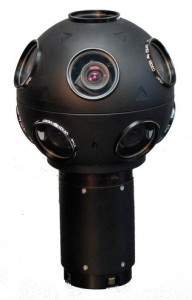
[Originally posted in Art Fag City's "IMG MGMT" series on August 12, 2009]
One year ago, I started collecting screen captures of Google Street Views from a range of Street View blogs and through my own hunting. This essay illustrates how my Street View collections reflect the excitement of exploring this new, virtual world. The world captured by Google appears to be more truthful and more transparent because of the weight accorded to external reality, the perception of a neutral, unbiased recording, and even the vastness of the project. At the same time, I acknowledge that this way of photographing creates a cultural text like any other, a structured and structuring space whose codes and meaning the artist and the curator of the images can assist in constructing or deciphering.
Street View collections represent our experience of the modern world, and in particular, the tension they express between our uncaring, indifferent universe and our search for connectedness and significance. A critical analysis of Google’s depiction of experience, however, requires a critical look at Google itself.
Initially, I was attracted to the noisy amateur aesthetic of the raw images. Street Views evoked an urgency I felt was present in earlier street photography. With its supposedly neutral gaze, the Street View photography had a spontaneous quality unspoiled by the sensitivities or agendas of a human photographer. It was tempting to see the images as a neutral and privileged representation of reality—as though the Street Views, wrenched from any social context other than geospatial contiguity, were able to perform true docu-photography, capturing fragments of reality stripped of all cultural intentions.

Tags
- google,
- jon rafman,
- photography
The Unthinkable Community by Paul Chan

[Originally published in e-flux journal #16, May 2010]
One of the great mysteries of our time—besides the reason why the United States is still in Iraq after seven years, the magical thinking that enabled banks around the world to sell bad debts as good investments, and perhaps we can add here the enduring significance of Jeff Koons—is how the ever-expanding methods by which we communicate with one another—from cell phones to SMS, from e-mail to Twitter, from Facebook to Chatroulette—are alienating us from others and ourselves.
There is no doubt that advances in technology have fundamentally transformed the nature and reach of communication in social life. These advances have also generated new forms of economic empowerment, cultural exchange, and, ultimately, new modes of living. Making connections is a serious business. And this business is, in turn, transforming the way such connections shape our sense of self.
The desire to communicate, to conjure in speech or sound or image or movement an inner experience that expresses what we want or who we are (or who we want and what we are) is being repurposed to serve a need beyond that of conveying and understanding. The telecommunications and related technology industries have capitalized on the demand for communication by producing ever more robust and specialized platforms for making connections. But this is not necessarily so we communicate and understand one another more, but rather so there is simply more speech-material to gather, transmit, quantify, and capitalize. In other words, communication is being industrialized. In the economic scheme of things, forms of expression are now a natural resource, to be tapped and exploited for profit, like oil. And a productive life is today inextricably linked to generating more and more speech for others to hear, see, and read. To live fully in the present means to be in constant communication: the self as network. Ego sum communicatio.
But having more social contacts has not made for stronger social bonds. All the texting and friending may expand the number of people in one’s life, but the links do not enrich the quality of the arrangements. Common interests bring people together. But what keeps them together is neither common nor easy. It takes an evolving awareness of the differences that naturally develop between two individuals, and a commitment to allow those differences to take root, so that common connections grow into singular bonds. The open secret to this process is time, the only dimension capable of registering the moments and ruptures that define the growth of an individual abiding an unbridgeable difference to become one for the other.
Time deepens connections, whereas technology economizes communication. This is why, despite the growing number of ways for people to be seen and heard, tele-technologies have ironically made it harder for people to comprehend one another. What matters in communication—understanding, relationality, interchange—has somehow gotten lost in the transmission. Cellphones, wireless devices, and the proliferation of social media online have revolutionized the ways in which we communicate, and at the same time, compressed what we say and type to such a degree that intelligibility is sacrificed for the sake of reach, ubiquity, and consumption.

Tags
- amanda ross-ho,
- joel holmberg,
- ryan trecartin,
- social media,
- theory
Viewing Copies: On the Mobility of Moving Images by Sven Lütticken

[Originally published in e-flux journal #8, September 2009]
An artist once paid a critic back for lunch by handing him a viewing copy of a video work, adding that this should be more than enough—after all, the piece was worth 25,000 Euro. Both were in on the joke, of course; both knew that a DVD viewing copy of an art video is worth even less than an empty new DVD. In a way, viewing copies do not really exist—their spectral status is owed to the art world’s economy of artificial scarcity and the severe limitations it imposes on the movement of images. Aby Warburg once called Flemish tapestries—early reproductive media that disseminated compositions throughout Europe—automobile Bilderfahrzeuge.1 Later media have proven to be rather more powerful “visual vehicles” capable of being produced on a Fordist assembly line. But rather than have the work travel to the viewer—an increasing tendency throughout the nineteenth and twentieth centuries—in the case of video or film pieces in contemporary art the viewer has to travel to the work, installed in a gallery or museum.
In contemporary art, even pieces produced in media that allow for infinite mass (re)production are executed only in small editions. In the age of YouTube and file-sharing, this economy of the rarified object becomes ever more exceptional, placing ever-greater stress on the viewing copy as a means of granting access to work beyond the “official” limited editions and outside of the exhibition context. The viewing copy is the obverse of the limited edition: as a copy given or loaned to “art world professionals” for documentation or research purposes, it can never be shown in public. The viewing copy thus widens the reach of the work of art, but confidentially and in semi-secrecy. It is precisely this eccentric status of the viewing copy within the economy of art—which itself has an equally exceptional status within contemporary capitalism—that makes it an exemplary object, a theoretical object par excellence.

Tags
- clunie reid,
- copyright,
- harm van den dorpel,
- theory
Richard Stallman’s “The Free Software Definition”
Richard Stallman, a major figure in the Free Software movement and the founder of the GNU Project and the Free Software Foundation, wrote “The Free Software Definition” in 1986. It is a crucial document in the history of copyleft and it is pertinent to many of the themes in the Free exhibition.
“Free software” is a matter of liberty, not price. To understand the concept, you should think of “free” as in “free speech,” not as in “free beer.”
Free software is a matter of the users’ freedom to run, copy, distribute, study, change and improve the software. More precisely, it means that the program’s users have the four essential freedoms:
* The freedom to run the program, for any purpose (freedom 0).
* The freedom to study how the program works, and change it to make it do what you wish (freedom 1). Access to the source code is a precondition for this.
* The freedom to redistribute copies so you can help your neighbor (freedom 2).
* The freedom to distribute copies of your modified versions to others (freedom 3). By doing this you can give the whole community a chance to benefit from your changes. Access to the source code is a precondition for this.

Tags
- free,
- reference,
- software
Takeshi Murata Interview Video
A few months ago, the Creators Project interviewed Free artist Takeshi Murata about his work and practice, focusing on his unique approach to animation.

Tags
- interview,
- takeshi murata,
- video
Seven on Seven: Ryan Trecartin & David Karp Video
Here’s a video of David Karp and Ryan Trecartin presenting Project Ten, the original incarnation of the work riverthe.net featured in Free, at the Seven on Seven conference earlier this year.

Tags
- ryan trecartin,
- ryan trecartin & david karp,
- video
Performance 4 (Seth Price) by Gene McHugh on Post Internet
Through his career, though, Price has developed strategies which resist the anxieties posed by these endless cycles of performance and novelty. Two of those strategies are delay and re-versioning. In both of these cases, one might say that Price’s medium is his own archive or database.
Delay, as a strategy, is less concerned with the moment in which it is produced and more concerned with the blast it gives off at a later date. And re-versioning allows Price to participate in the NOW of the performance by returning to its past. Price’s body of work is open to continuous re-working by the artist himself. This mutability of his archive simultaneously destroys the past and keeps it alive.

Tags
- database,
- performance,
- seth price
Seth Price, Correspondence by Boško Blagojević
[Originally published in Rhizome News, September 9th, 2010]
The following is an excerpt of an ongoing correspondence between Seth Price and Boško Blagojević.
………..
BB: I’d like to talk more about nationalism with you, but for now maybe let’s get back to the 10-6… mix. Music brings people together too, after all. How did it start?
SP: I was collecting great songs, and for some reason it was all dance music! Dance music from the last thirty-five years or so, electronic dance music. This went on for a couple of years, and I’d stick each track to the previous one so I could organize them in one place. And then I wanted to mix the tracks together, that whole DJ thing, so it kept expanding.
With the Title Variable pieces [2001—], I already had a structure for working with music, and it offered a way to consider why I was accumulating dance music, what the form would be, how to frame those things. On the other hand, the compilations had so far focused on very specific historical niches, odd pockets of music that didn’t fit, so ‘dance music’ seemed too broad. But the more I thought about it, the more it fit the project, because these compilations were supposed to be frameworks for thinking about how production and distribution change over time, and “8-4…” comes out of just those sorts of changes, it could only be a product of its moment. Partly this is because of the way that “dance music” fills any space and cannibalizes any genre, and plays well anywhere that consumption or production happen. Also the way that everyone’s now invited to take on the DJ role, not the performance aspect or “reading the crowd,” but the ease of sharing a notion of taste, the distribution of taste. And finally there was something about availability, the availability of mixing software, and of music itself. Infinite music, music taken for granted.
File sharing was originally the spark behind the Title Variable piece: fishing for disparate parts, manipulating them, repackaging them as a kind of expression of taste, although an ambiguous one. But because I started the piece in 2001, it developed right alongside iTunes and the iTunes store and the iPod, and the mainstreaming of filesharing, and the shuffle function, and the “mix” as a list of references, as information pure and simple. The mix is a different kind of structure from when I started, when I wasn’t aware of those things, when they didn’t really exist yet.
Of course, eight hours’ worth is kind of a potlatch. Excessive sharing. But that’s what’s happening now, excessive sharing.

Tags
- interview,
- seth price
Photos from the Free Opening
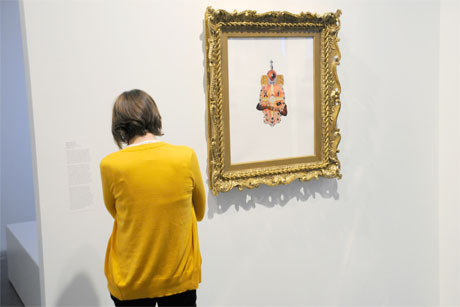
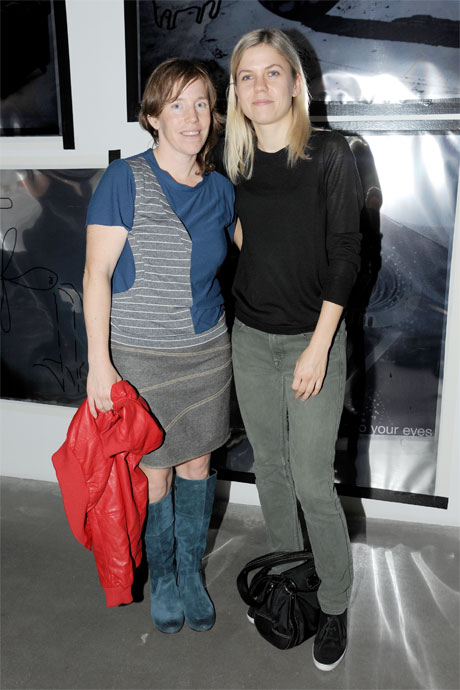
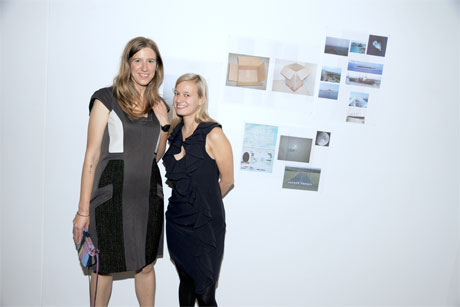
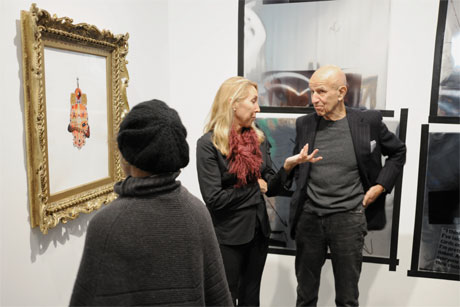
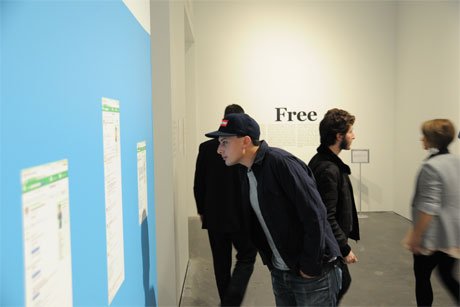

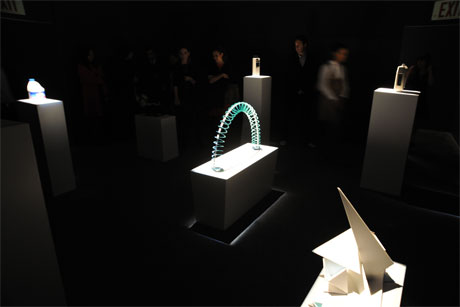
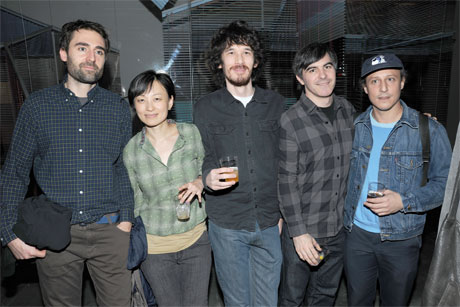
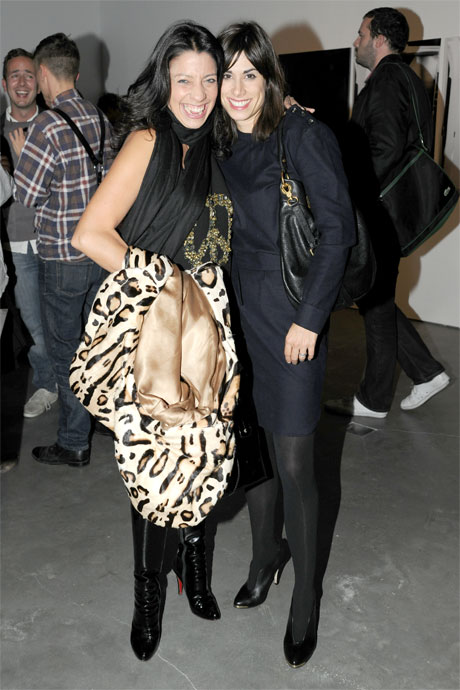
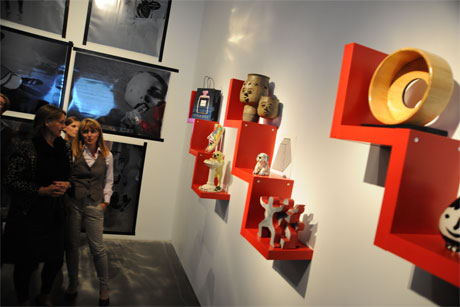

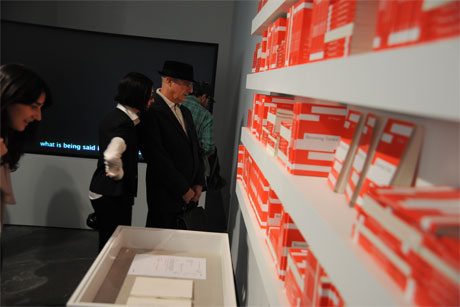


Free Installation Shots
Rhizome Curatorial Fellow Jess Ramsay took some shots of Free during the installation process, so you can get a behind-the-scenes peek.
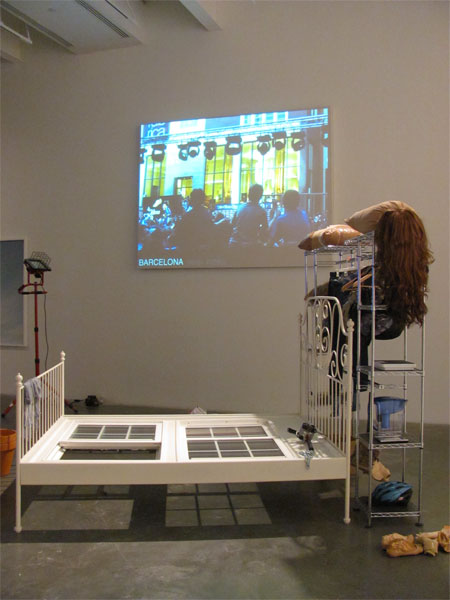
Lizzie Fitch's sculpture in the foreground and Ryan Trecartin & David Karp's "riverofthe.net" in the background




